the landscapes of pittwater as shown through the colonial wandering sketcher artist
Prior to the availability of photographs, and people prepared to carry these cumbersome early versions of cameras over hill and through dale and on water to 'get' these images, the sketch and the sketcher were who captured and shared images of places no shod in soft leather and silk stocking foot could venture to. These sketches and paintings, the original colonial art school of 'en plein air' Pittwater Artists, combined with articles published in the periodicals of the time describing the ventures of those who travelled through this place, offer a glimpse into a landscape unchanged when viewed from the places these were made, or taken from.
This view of Mona Vale, for instance, seemingly taken from near the summit of the land opposite Bushrangers Hill at the Bungan beach - Newport Beach overlap, was created by Henry Grant Lloyd on November 30th 1859:

This aspect looks as though the walkers are heading to Mona Vale from Newport, also there is no St John's on what we now call Mona Vale headland - that chapel opened in 1871. The home that can be seen was, in 1859, leased by Henry Bate, then the Therry family, and finally the Boutlon's, previously the Wilson home and Foley premises, is visible.
Also visible is the waters which would form part of the front yard of the George Brock 'The Oaks' and which were part of the flow of water through the landscape that included The Black Swamp on present day Mona Vale Golf Course. Some sections, enlarged, to show these details, including those little brown coloured marks to depict cows - Pittwater was a food bowl area then, with a dairy in just about every stretch of green between headlands from Barrenjoey to Long Reef.
.jpg?timestamp=1635446335098)
The tenancy of 'Mona Vale farm' became William Boulton's in 1872. He was at Mona Vale until January 1882, when he took out a publican’s licence for the Newport Hotel and then bought the hotel which was not sold until 22 years after he passed away in 1919. Illustration from the Pittwater and Hawkesbury Lakes Album. 1880, by Harold Brees Courtesy the Mitchell Library:
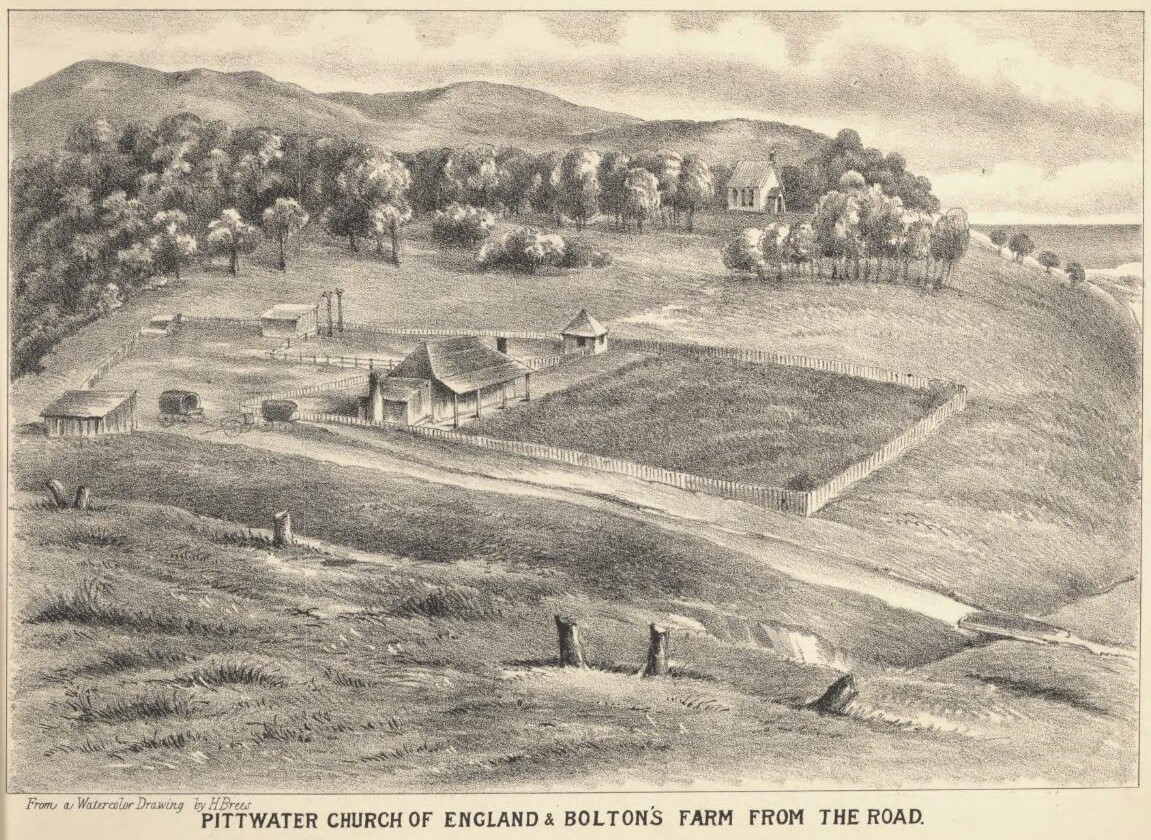
After the murder of Mary Ann Farrell’s father, David Foley, in November 1849, the Farrells appear to have run their own and the Foley farm as one, enjoying the use of hundreds of acres of land for their cattle. The 700 acre farm was leased for a short time by Henry Bate and Fred Berkelman in 1858-59, but their venture failed, according to Henry’s daughter, because of cattle thieves who frequently drove off and killed their cattle.
For a short time a caretaker named Lush was installed; then in August 1862 James Therry, a relative of Father J.J. Therry, became the tenant of Mona Vale. For more detail see The Murder of David Foley by Shelagh Champion OAM + Maria Louisa Therry – Pittwater Matriarchs
Pittwater in 1857 and 1859 - from the periodicals of the past:
LOSS OF THE SCHOONERS NORNA, HABP, RAPID, AND ARIEL.
Captain Cullen, of the Norna, with his crew and one man belonging to the Ariel, left Broken Bay yesterday morning about eight o'clock, and reached town in the evening. He has furnished us with particulars respecting the loss of the above vessels. The Norna, 43 tons, sailed for Newcastle about five on Sunday evening, the wind E.S.E. The Ariel, Rapid, and Harp, bound to Newcastle, were in company, and pat back to Broken Bay. The Norna was off Bungareenore about 12 o'clock. The wind then changed to E.N.E.|, and fearing more easterly weather, ran hack to Broken Bay, and brought to an anchor about three a.m. on Monday morning. It blew hard from the eastward all Monday, varying from E. to S.E. At ten p.m., let go second anchor, both chains to an end, the gale and squalls increasing in violence.
About four on Tuesday morning, the Harp went ashore close to West Head, were she now lies bilged. Between nine and ten the Rapid was close ashore in the breakers, the sea making a breach over her. The crew for safety took to the boats, and went on board the Ariel; the Rapid went ashore shortly after. The Ariel parted one anchor, slipped the other chain, and made sail, and run ashore under Barranjoey. Finding there was no hope of saving the Norna, the crew also took to the boats and had to run some distance up the Hawkesbury. The vessel immediately drifted ashore, and became a total wreck. The barque H. M. Warfield rode out the gale safely. The sea was running a great height on Tuesday and Wednesday morning into the Bay. No lives, we are happy to say, were lost, but the crews have lost their all. The Harp belongs to Mr. E. M. Sayers, and is said to be insured ; the Norna to Mr. H. B. Morris. It was reported that a schooner was seen ashore near Mount Elliott. The Policeman, and the Paterson Packet, for Newcastle, sailed on Sunday, a few hours before the Norna. The master of the Harp with some of the Rapid's crew, also walked from Broken Bay yesterday. Two of the Rapid's crew went on to Newcastle in the H. M. Warfield. The captain of the Rapid had his leg severely injured in hoisting the boat on board the Ariel, and is staying at Broken Bay with the captain of the Ariel. Some heavy pieces of timber were seen floating down the Hawkesbury yesterday morning. With reference to the vessels reported wrecked in Broken Bay, in Friday's Herald , the following additional particulars have been obtained. The Harp, schooner, is the property of Mr. E. M. Sayers, and is insured in the General Assurance Office, for £800. The Ariel is owned by Messrs. Duguid and Manson; insured in the New South Wales Office, for £600. The Norna, owned by Messrs. Morris and Lane ; and Rapid, the property of Captain Clark, are both uninsured. The Chance, ketch, ashore at Newcastle, is also uninsured. LOSS OF THE SCHOONERS NORNA, HARP, RAPID, AND ARIEL. (1857, August 3). The Shipping Gazette and Sydney General Trade List (NSW : 1844 - 1860), p. 181. Retrieved from http://nla.gov.au/nla.news-article161170827
Charles Lush, in the employ of Henry Jefferson Bate, farmer, Pitt Water, was convicted of having assaulted his master by striking him several times, hitting him once in the eye. Fined 10s., with costs. WATER POLICE COURT. (1859, August 23). The Sydney Morning Herald (NSW : 1842 - 1954), p. 8. Retrieved from http://nla.gov.au/nla.news-article13029692
WATER POLICE COURT
TUESDAY.
BEFORE the Water Police Magistrate and Mr. G. H. Rowley.
Archibald Watson, who had been found drunk at the North Shore, was fined 10s., in default or payment to be imprisoned for twenty-four hours.
Henry Bate was summoned on the information of William Trimbey, who sought to recover from him a balance of wages, which defendant owed him and re-fused to pay. Mr. Borton appeared for the plaintiff. It appeared that complainant had been employed by defendant to cut wood at Pitt Water, and he claimed wages for nineteen weeks and two days that was £14 17s. 4d. (minus £6 Is. 6½d. for goods and cash received), the balance due £8 15s. 10d. Defendant disputed the amount, maintaining that the balance due was £6 4s. 11d. The Court ordered that defendant pay complainant £7 and costs.
James Rotheveel, seaman, for deserting his ship, the Loevestyn, was sentenced to fourteen days' hard labour in gaol. WATER POLICE COURT. (1859, September 28). The Sydney Morning Herald (NSW : 1842 - 1954), p. 2. Retrieved from http://nla.gov.au/nla.news-article13031259
WATER POLICE COURT. TUESDAY.
BEFORE Mr. R. J. Hopkins and Mr. T. Cooper.
But one drunkard was on this day's sheet, and as it was the defendant's first offence he was admonished and discharged.
Harriet Carter, n married woman, residing at the North Shore, was brought before the Court as a person of unsound mind. Henry Carter, her husband, stated that defendant had, for the last three years, shown symptoms of insanity. She was in the habit of going into the bush, where she frequently lost herself ; and on one occasion she was pulled out of a water-hole into which she said she had fallen. Her husband said he was afraid she would do herself some bodily injury if left without restraint. Dr. Rutter, who had examined prisoner, was of opinion that she was of unsound mind. The Bench ordered that defendant enter into sureties by her husband to be of good behaviour for one week, or in default to be imprisoned for that term.
John Andrews, of Pitt Water, was charged, on the information or Joseph Shaw, with having wilfully and maliciously killed a calf, the property of informant. Mr. Borton appeared-for plaintiff; Mr. Moffatt for defendant. Several witnesses were examined, from whose evidence it appeared that about midnight of the 21st day of last month, prisoner entered plaintiff's ground adjoining his own at Pitt Water, and with a stick beat a calf belonging to complainant, from the effects of which the animal died the following day. Its head having been much bruised and its neck broken. The attorney for the prosecution having omitted to place complainant in the box to swear in support of the information, and to identify prisoner as the John Andrews there mentioned, defendant's attorney on those grounds raised an objection, which was ruled by the Bench to be fatal to complainant's case, and it was therefore dismissed. WATER POLICE COURT. (1859, October 5). The Sydney Morning Herald (NSW : 1842 - 1954), p. 3. Retrieved from http://nla.gov.au/nla.news-article13031574
John Andrews was born in the village of Severnstokes, Worcestershire, in 1795, the eldest child of Charles and Mary (or Martha) Andrews, farmers. When he joined the 80th Regiment of Foot (the Stafford Volunteers) on 13 May 1816 he could neither read nor write, but he learnt to do so while in the Regiment. John came to New South Wales in the advance guard of the Regiment, arriving on the Lady Kennaway on 12 October 1836. His duties in the next few years included guarding the iron gangs of convicts who were building roads around Hartley and Lithgow. Sergeant John Andrews was discharged on 30 April 1841, after 25 years’ service. He received a pension, and also applied for and obtained the authorised remission in the purchase price of land, for which he was eligible. [AO Reel 1083] On 8 February 1842, fifty acres of land at the Basin, Pittwater, were advertised for sale as Lot 8.
John Andrews purchased the land with the £50 remission to which he was entitled, and it was granted to him on 18 April 1842. [LTO SN75/1] He married a widow, Hannah Jackson, on 4 January 1849. Both gave their place of residence as Broken Bay. John Andrews agreed to sell six acres “to commence and be taken from the western boundary” of his farm to Joseph Shaw on 4 May 1849. He agreed to give Shaw legal title “at any time he may require” on condition of the purchase money being paid. John Collins was witness to the agreement. [LTO Book 82 No.492] See Joseph Shaw. On 4 November 1859 John Andrews sold his grant to John Smith for £150. [LTO Book 71 No.929] John Smith made his will on 11 April 1862, just three days before he died, leaving the land to Hannah Andrews. Probate was granted to Hannah Andrews on 11 April 1872.
On 10 October 1872 John and Hannah Andrews exchanged their land, which is still known as 'Soldiers Point', for a much smaller block of land at Careel Bay, belonging to John Collins, on which Collins had built a cottage. [LTO Book 132 Nos.923 & 924] This block of land was Lot 1 of Section XIII, bounded by John Street on the south, William Street on the west, and the creek on the north. Bedridden since April 1877, John Andrews died on 12 May 1879 at the home of John Gould, Brighton Cottage, Whistler Street, Manly. He had no children.
Charles Andrews was the younger brother of John Andrews. Born in 1799, in March 1818 he joined the 80th Regiment of Foot (the Stafford Volunteers), in which his brother was already serving. The Regiment came to Australia in 1836. 100 acres of land at Cabbage Tree Bay (North Manly) was advertised as Lot 7 on 8 February 1842. Charles teamed up with Christopher Skally to purchase the land, both of them being due for discharge. Under the regulations of 15 February 1840, a remission of £50 was authorised for Charles as a late Sergeant in the 80th Regiment, and a remission of £25 was authorised for Christopher Skally as a late Private in the 28th Regiment of Foot. The purchase price of £60 was well covered, and the land was granted to them on 9 May 1842. [LTO SN75/18] Charles Andrews, settler of Manly Cove, and his wife Jane Isabella, and Christopher Skally of Windsor, and his wife Bridget, sold the land in 1847. 10 acres went to Isaac Lowry on 2 August 1847 for £10 [LTO Book 13 No.241]; 16 acres went to John Whaley on 9 August 1847 for £16 [LTO Book 35 No.160]; and 74 acres went to John Sims on 9 August 1847 for £63 [LTO Book 13 No.235].
John and Mary Anne Sims sold the 74 acres to Henry Miles, Thomas Youl, Thomas Kirby and Robert Symon on 19 December 1850. Symon sold his share for £8 to the other three, who partitioned the land among themselves on 27 November 1854. [LTO Book 35 No.799] Kirby immediately sold his share to Henry Gilbert Smith for £140, while Henry Miles, gardener, and Thomas Youl, stonemason, sold part of their land to Smith, but remained as residents. Whaley sold his 16 acres to Smith for £200 on 30 January 1855. This gave H.G. Smith ownership of all land along the ocean front north of the Corso, except a small part near Manly Lagoon, which still belonged to Thomas Youl. Isaac Lowry’s 10 acres passed through a number of hands before being purchased by James Farrell on 14 July 1871. This was the land commonly known as Farrell’s Paddock - Profiles of the Pioneers in Manly, Warringah and Pittwater - George and Shelagh Champion, 2013 revised version.
Henry Jefferson Bate, of Pitt Water, appeared on summons at the instance of Eliza Crowe, who complained that he had become indebted to her for wages as a general servant in the amount of £44 13s., which he refused to pay. Mr. Borton appeared for complainant. The Bench ordered the payment of £42 with costs. WATER POLICE COURT. (1859, October 28). The Sydney Morning Herald (NSW : 1842 - 1954), p. 4. Retrieved from http://nla.gov.au/nla.news-article13032388
BROKEN BAY AND ITS VICINITY. .
To the Editor of the Herald.
Sire, you will oblige me by inserting in your widely-circulated ' journal some particulars of the country and people in the vicinity of Broken Bay, as they came under my own observation while on a professional visit to that vicinity. The distance from Manly Beach to Broken Bay is twenty-two miles, over a country only passable by bush track, which is none of the safest for either man or beast, being hilly and rugged. Occasionally you will come across patches of rich alluvial soil between the hills, and stretching along the sea-coast unoccupied oy man-a result undoubtedly attributable, in a great measure, to the want of a good road.
The residents are few and far between. They appear to be of an industrious class – those within seven miles of Manly Beach are engaged in agricultural pursuits, while those between Miss Jenkins, at Long Reach House, to Broken Bay, are generally employed in dairy farming; and all appear to be in very comfortable circumstances.
The hospitable characteristics of the people I had the pleasure of experiencing; for often a lone walk of several miles, part of the road being through a salt-water swamp (which at a trifling expense might be effectively drained), through which I had to wade, the damper, eggs and butter, that were laid before me at the house of one of the settlers were, it is unnecessary to say, done ample justice to. On arriving at Mount St. Patrick, on which a house occupied by a hardy Hibernian, stands, I found, coal cropping out of the mountain about a quarter-mile from Pitt Water. The property belongs to the Rev. John Joseph Therry, and there is little doubt but that at some future time coal will be an important article of export from the district.
The harbour of Pittwater is a noble sheet of water, capable of admitting ships of any burden and its scenery overhanging the place is rich and diversified '
I counted no less than twelve vessels-cutters and schooners sailing out of the harbour on Sunday morning last, thus showing the value of so near and safe a harbour of refuge. The vessels had taken shelter there for the night merely.
In a comfortable little nook behind Barren Joel resides the Customs officer, Mr. A. Ross, who has been living there for the past six years and during that time he has made great Improvements.
From the hospitality, kindness, and urbanity of Mr. Ross and his good lady, experienced by me at their hands I think him to be the right man in the right place. I found several living families there whose members had not suffered a days sickness during the time of their residence at the locality – a time extending in some cases over several years. No clergyman visits the neighbourhood, except a Roman Catholic priest, who attends when sent for – so I was informed.
In conclusion, I would point out the desirability of forming a good road to the locality, for I believe that more than anything else would conduce to the prosperity of the district. It would enhance the value of property, both public and private, and would act as an inducement to runny industrious families now out of employment in Sydney, to go and settle down in the neighbourhood
I have the honour to be, Sir, yours very truly,
JOHN S. PARKER
City Coroner's Office, Tuesday, October 18. BROKEN BAY AND ITS VICINITY. (1859, October 19). The Sydney Morning Herald (NSW : 1842 - 1954), p. 5. Retrieved from http://nla.gov.au/nla.news-article28628383
In the Supreme Court; of New South Wales.
ECCLESIASTICAL JURISDICTION.
In the Goods, Chattels, Credits, and Effects of Robert Strutt, late of Broken Bay, in the Colony of New South Wales, seaman.
NOTICE is hereby given, that after the expiration of fourteen days after the publication of this notice, application will be made to this Honorable Court in its Ecclesiastical Jurisdiction, that Administration of all and singular, the goods, chattels, credits, and effects,, which were of the above-named Robert -Strutt, deceased, may be granted to Samuel Strutt, of Port Macquarie, in the Colony, aforesaid, seaman, a brother of the said deceased.—Dated this fourth day of November, a d. 1859.
HENRY NEWBON,
Proctor for the Applicant,
120, Elizabeth-street, Sydney.
2916 4s. 6d. ECCLESIASTICAL JURISDICTION. (1859, November 4). New South Wales Government Gazette (Sydney, NSW : 1832 - 1900), p. 2430. Retrieved from http://nla.gov.au/nla.news-article228602780
Compare that sketch of a Mona Vale vista from Bungan with this image:
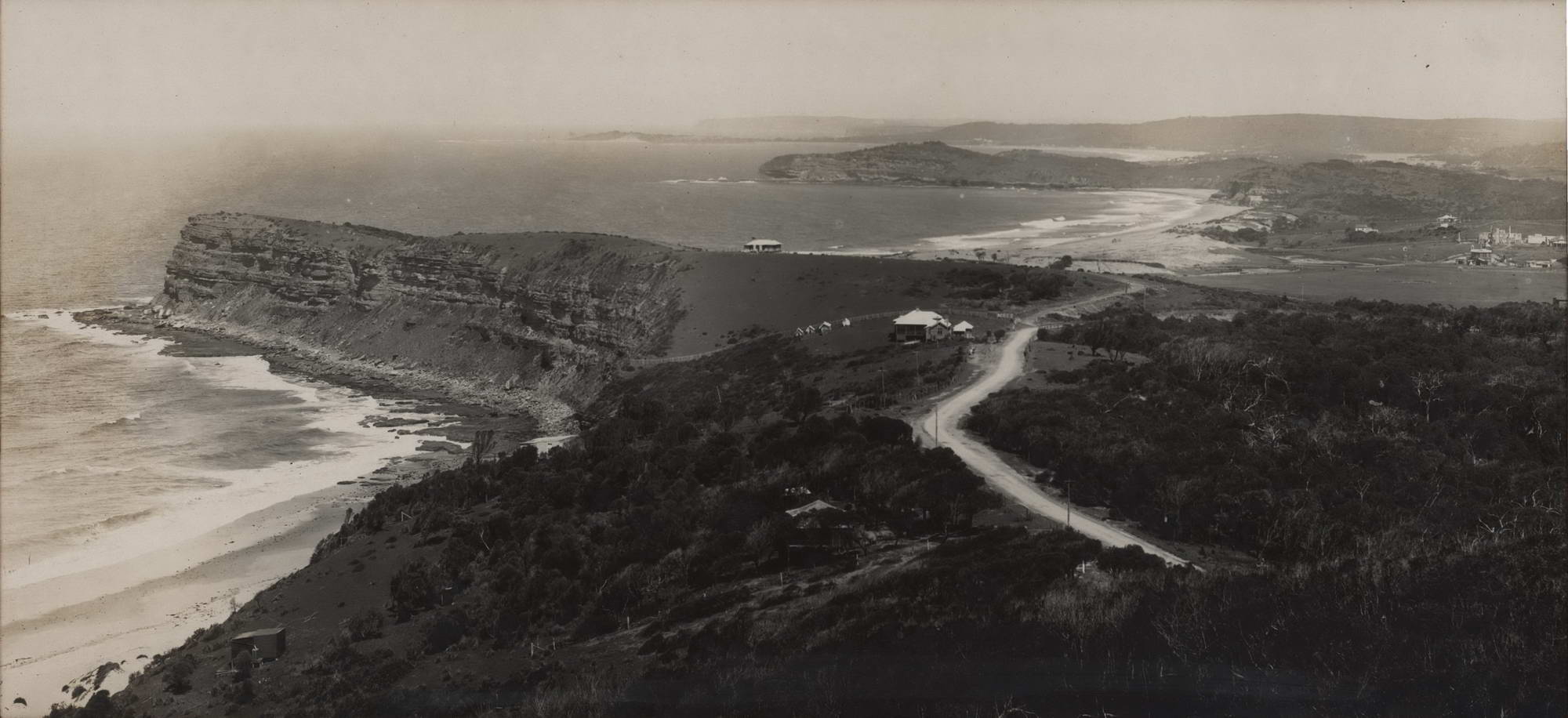
View From Bushranger’s Pt Near Newport Hill [NSW] c1915-20/25. Vintage silver gelatin photograph, typed title on accompanying slip, Shows Bungan and Mona Vale Beaches. By NSW Government Printer (Aust., commenced 1842). Item #CL174-113 - Price (AUD): $1,250.00 - from Josef Lebovic Gallery - 'Cooinoo' is the house mid picture with 4 tents in its' backyard - to the far right of frame can be seen Brock's 'The Oaks' Mansion in its first version and prior to the fire of January 8th 1912 which gutted the main structure, which seems to have some kind of crane or ladder against the main rounded centre builting.
And this image, taken further out on the eastern point at north Bungan Beach from the roof of Bungan Castle in September 2018:

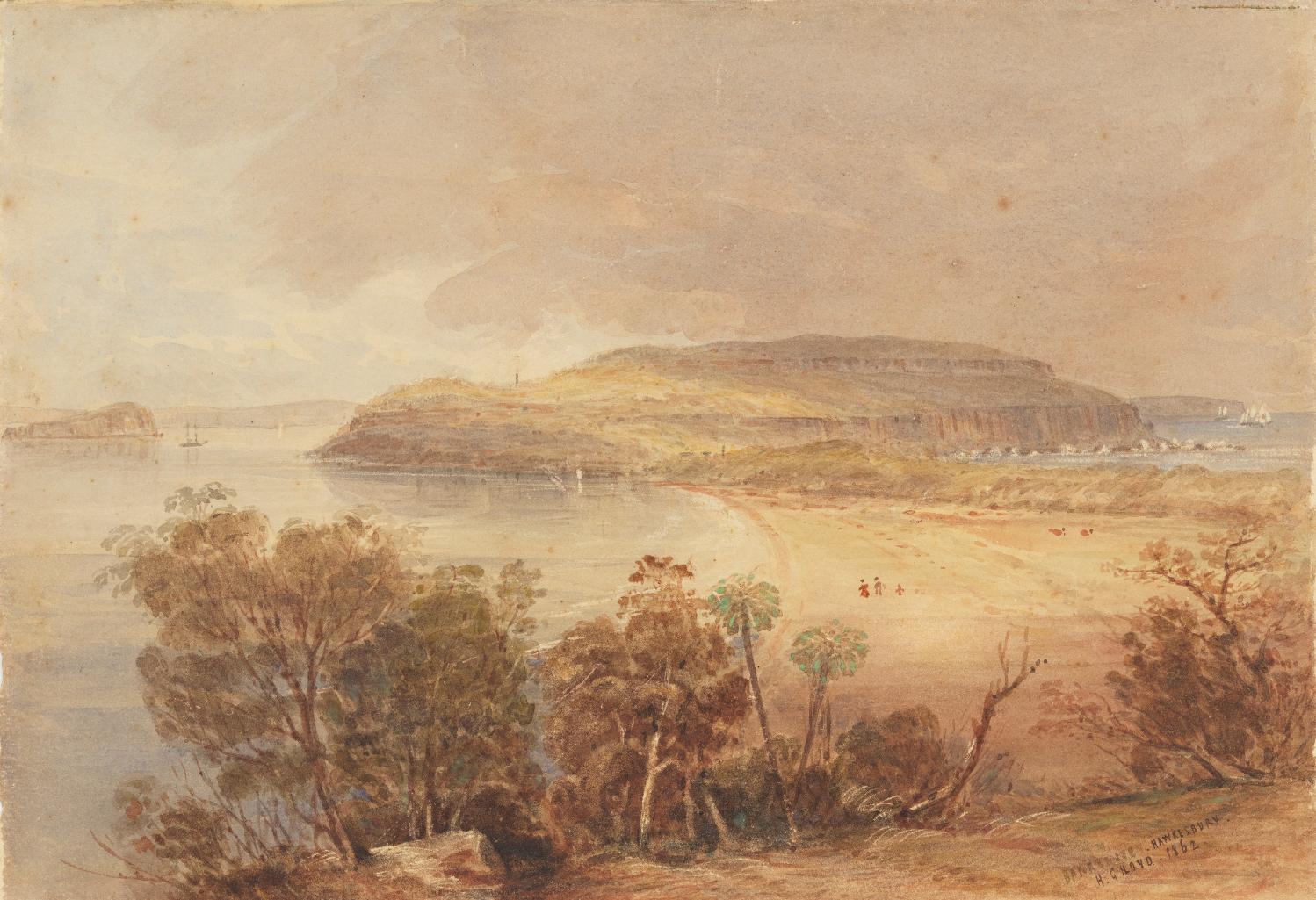


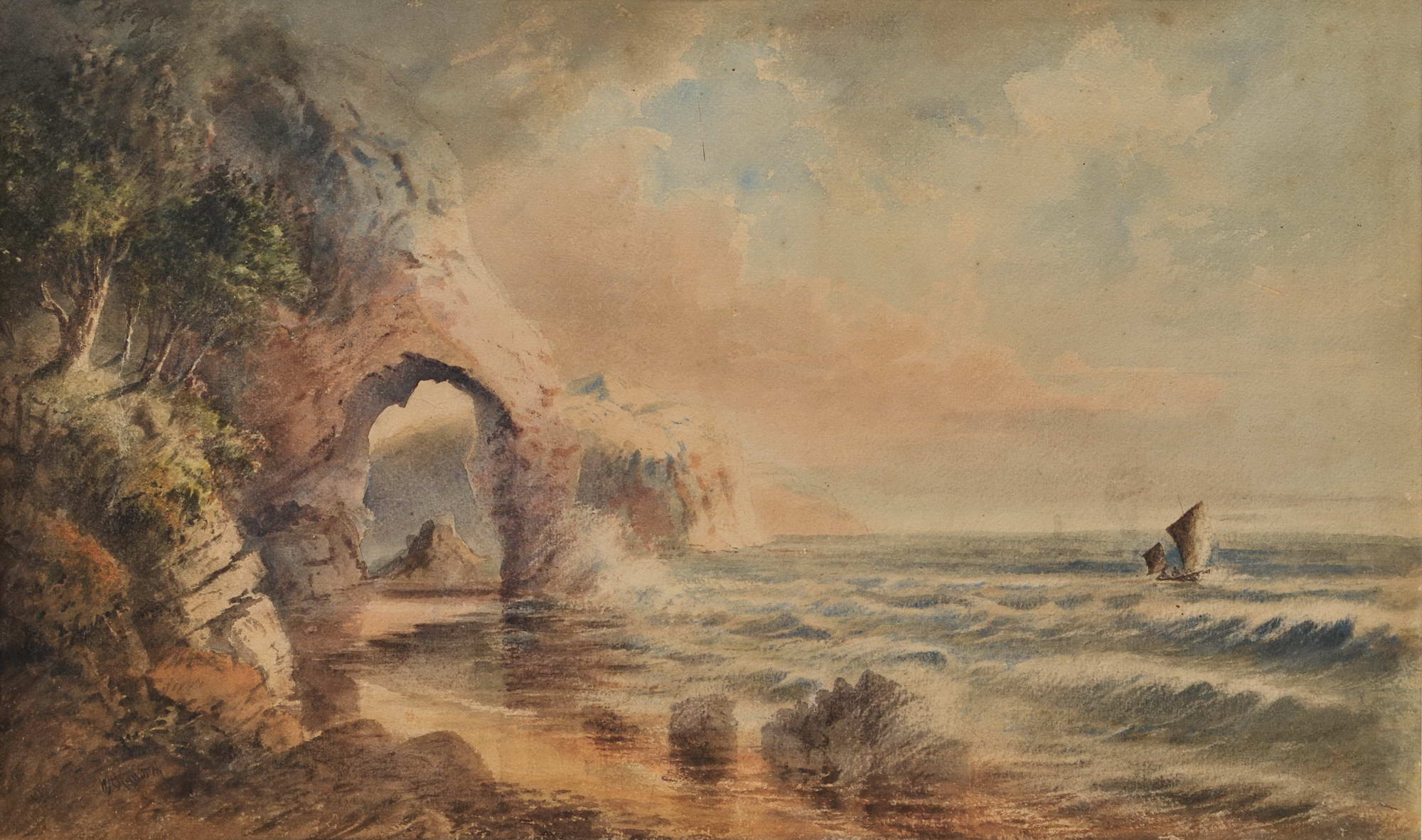
W.H. Raworth (Brit./Aust./NZ, c1821-1904). St Michael’s Arch, NSW [Avalon] c1860s. Watercolour, signed lower left, obscured title in colour pencil verso, 34.2 x 56.5cm. Tear to left portion of image, slight scuffs and foxing to upper portion. Price (AUD): $2,900.00 at:https://www.joseflebovicgallery.com/pages/books/CL181-53/w-h-raworth-c-brit-aust-nz/st-michaels-arch-nsw-avalon
BROKEN BAY.
[FROM OUR CORRESPONDENT]
June 24 – We have had tremendous weather, but, as far as Pitt Water is concerned, no damage has been done with the exception to one of our picturesque curiosities, St. Michael’s Arch. It has at length to the too mighty elements and the destroying influence of time, that which was the admiration of all who have beheld it is now almost baseless fabric-there is only about one half of the outer support left, looking at it at a distance it has the resemblance of a coloured pillar. In its fall it carried a large portion of the overhanging rock with it, a thousand tons of gigantic boulders, and in such masses that I think it will stop the ingress from that part to the cave, but at yet we have had no close inspection for the rollers are dashing to the height of the stupendous rocks. The only idea I can give of the gale is that the froth of (not spray) the sea came over Mount St. Joseph, opposite the house, half a foot in size, and spread itself down to the dam, at times shading the heights of the mountain,-its resemblance was that of an overwhelming snow storm.
The sea at Barranjoey washed away the flower garden in front of the Chinamen's huts, taking soil and all, so that the beach comes close up to their door. There must have been awful havoc in the Hawkesbury, for all the beaches from Barranjoey to the Long Beach are strewn with fragments of houses, boxes, chairs, door frames, dead pigs, hay, wheat, broken bedsteads, weather-board sides of houses, oranges with large branches, pumpkins, melons, corn cobs, and other debris, that scarcely any portion of the beaches can be seen. Mr. Conolly picked up a workbox, in which was contained a number of receipts and letters directed to Mr. Moss, Windsor. The beaches on which are the debris is Barrenjoey, Whale Beach, Collins's Beach, Mick's Hollow Beach, Farrell's Beach, Mona Beach, and Long Beach, so it may be imagined the great extent of destruction. BROKEN BAY. (1867, June 27). The Sydney Morning Herald (NSW : 1842 - 1954), p. 2. Retrieved from http://nla.gov.au/nla.news-article13144304
A TRIP TO PITTWATER.
Some friends of mine having purchased part of the Pittwater estate recently offered for sale, were anxious to see the land, and they invited me to accompany them. Saturday last was fixed for the trip. On that morning we were all up betimes. The night before we agreed that whoever rose earliest should call the others. Being known to rise on the first sound of the ' cock's shrill clarion,' I was expected to rouse my friends. At 5 o'clock when I went to do so I found that one of them had been up two hours, the others even longer. They had evidently worried themselves into wakefulness all night, for which there was no necessity, as a late sleeper might catch the first Manly boat, by which we were to leave Sydney. Saturday morning broke in smiling silence on the city and suburbs: it was one of those mornings which call forth praise and prayer to heaven for the blessing of such a climate as we enjoy in this Southern land. The waters of the harbour from our point of view (the heights of North Shore)looked like several lakes which were as calm as millponds. Our unrivalled harbour, it appears to me, presents scenes at, daybreak and by moonlight that cannot be viewed at any other time.
In summer mornings, before the sun rises, you may see creeping over the waters of its various nooks and bays gauze-like exhalations, which magnify the ships and boats in the stream. On the appearance of the great, vaporizer the mist is dispelled and the grand picture we all admire is unveiled. The nocturnal beauty of Port Jackson one never ceases to admire. Music only is wanted to make a moonlight view of it one of the most pleasurable sensations. Another harbour, pre-eminent for its capacity and safety,' and no mean rival of our own is more blessed in this respect, for the melody of the Shandon Chimes supplies the void felt here. On this I ponder,
Where'er I wander,
And thus grow fonder,
Sweet Cork, of thee ;
Why thy bells of Shandon,
That sound so grand on
The pleasant waters
Of the river Leo.
On board the Royal Alfred we were joined by a young gentleman who was also a guest. There were not more than half-a-dozen other passengers besides our party. Some of them looked sleepy and sullen, and appeared as if they had parted on bad terms with Morpheus. One of them who was late had to jump on board. The unamiable mood in which he appeared soon gave way to perfect equanimity, the effect, as one observed, of the soothing influence of the incense from the North Shore gums.
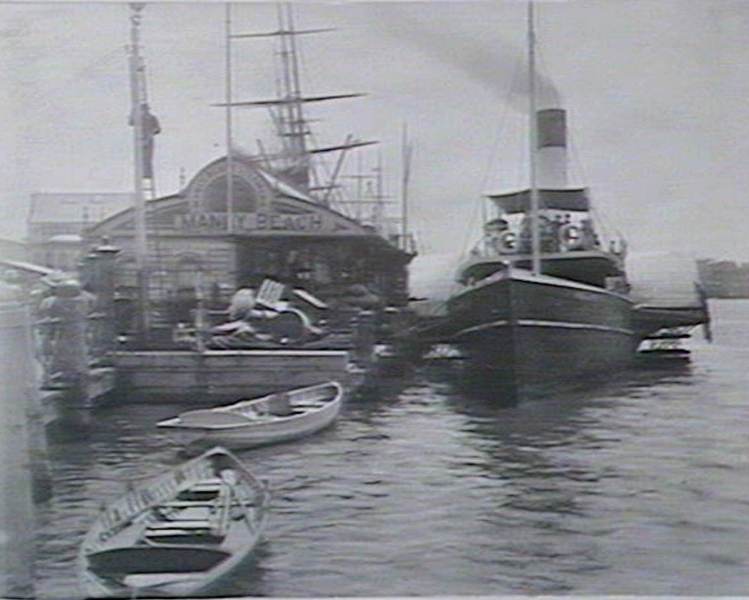
"Royal Alfred" at wharf Circular Quay, date; 9/1935 (?!), Image. No: d1_20453, courtesy State Library of NSW.
Arrived at Manly, we had an appetite for breakfast which many might, envy. This watering place reminds one of Passage, which Father Prout describes as situated
Upon the say;
'Tis nate and dacent,
And quite adjacent
To come from Cork,
On a summer's day.
The 'trap' which was awaiting us at, the hotel door, and which had been bespoken, was certainly not one of Kearey Brothers'. It had the appearance of a disused milk-cart., or a superannuated costermonger's conveyance. Our young companion did not like the look of it, but on being told there was no other available for our journey, he had sufficient of the Stoic in him to sink his personal feelings. Needs must when a Manly coach proprietor commands the drive to Pittwater. There is nothing very charming in the neighbourhood of the Pittwater road from Manly. Ducks and water fowl might find it a suitable abiding locality, but Manly-ites, if they have any regard for the future repute of their rising suburb, will extend it on the higher ground Spitwards.
Some four or five miles out of the township we overtook the 'royal mail coach' with its convoy conveying the mails and passengers to Boulton's or Newport at the head of the navigation of the Pittwater harbour. We sailed alone in this company until we crossed the Narrabeen Lagoon. As we emerged there from we descried a church, which appeared to be as well supported as the Smithy described in one of Swift's anecdotes. Seeing no residents around, we inquired where the congregation came from, but our Jehu was not a Matt Ryan. Indeed he was the most taciturn ' whip ' I ever travelled with.
Shortly after we entered upon the estate at Bilgola beach, where there is a deep leafy glen well adapted for the growth of bananas. On ascending to Bilgola Head a splendid view of the coast from Cabbage Tree Head to Barranjoee is obtained. The broad Pacific lay on our right at that moment as placid as Farm Cove. A splendid valley lay before us with the homestead of the patriarch of Pittwater, Mr. John Collins, in the distance; on the left, undulating land, well timbered.
Descending to the valley, we crossed the farm purchased by Mr. Canty, which is believed to be carboniferous. Some years ago competent judges gave it as their opinion that coal existed there. A bore of four hundred feet, made in the ground many years ago, when an attempt was made to test it, passed through strata that indicated the immediate vicinity of the black diamond. Mr. Coghlan's diamond drill would soon settle the question whether coal could be struck there. Mr. Collins's farm is situated in the valley, being flanked on the east by St. Michael's Cave and the South Head of Broken Bay, and on the West by Mount St. Mary. After doing full justice to Mr. Collins's hospitality, we sallied forth under his guidance to survey that part of the estate in which we were interested. We directed our steps towards Long Beach, nearly opposite Scotland Island, Pittwater Harbour. The land improved as we receded from the valley. Indeed we were agreeably surprised at finding soil and slope not excelled by any locality we had seen on the coast, except Irishtown, Lane Cove. My friends were delighted with their investment, and were only sorry they had not purchased more of the land.
Pittwater estate belonged to the late Very Rev. Archpriest Therry, who bequeathed it to the Society of Jesus. It is surrounded on all sides save one by water; and it has been highly praised for its salubrity. It has a Catholic church, at which the Rev. Dr. Hallinan officiates once a month; it has also a Provisional school, attended by some twenty children. There is an incipient town called Brighton at Careel Bay, north-west of Barranjoee. The site is eminently unsuited for a township, and the sooner it is abandoned the better. A low swampy beach from which the water recedes at ebb tide, is not well adapted for settling on. A better site is that on the harbour higher up at Long Beach, where there is ‘ample room and verge ' enough, besides a moderately elevated coast and deep water. West Carbery, as we christened the place, is the site for a township.
A large block of land at Stokes's Point is reserved for a College. The scenery at Pittwater and on the greater part of the way thither is simply grand. When the road is better— (Mr. Collins informed us there is money on the estimates to form it all the way), and when a better style of conveyance is available, I know of no place or drive that will present so many attractions to the invalid, the pleasure or holiday-seeker. Everything conspires to quiet the anxieties of the mind and invigorate the body. Wooded slopes and deep ravines, picturesque views of ocean, beach, and headland, are features that would dissipate the megrims of a miser or restore peace to the mind of a rejected swain. Notwithstanding the discomforts we laboured under from the vile vehicle we had, we enjoyed the trip to and fro uncommonly well, and arrived at 7 in the evening at Manly without any mishap beyond that which a little application of Australian Ointment will remedy, as our young friend of bills and briefs said. CRUIG BARRY.11th May, 1880. A TRIP TO PITTWATER. (1880, May 22). Freeman's Journal(Sydney, NSW : 1850 - 1932), p. 19. Retrieved from http://nla.gov.au/nla.news-article133488037
Mr Jeremiah Canty's son, Michael's widow sold his holding to Arthur Jabez Small on the 27th of July 1921 for £3300 NSW Land Records provides:

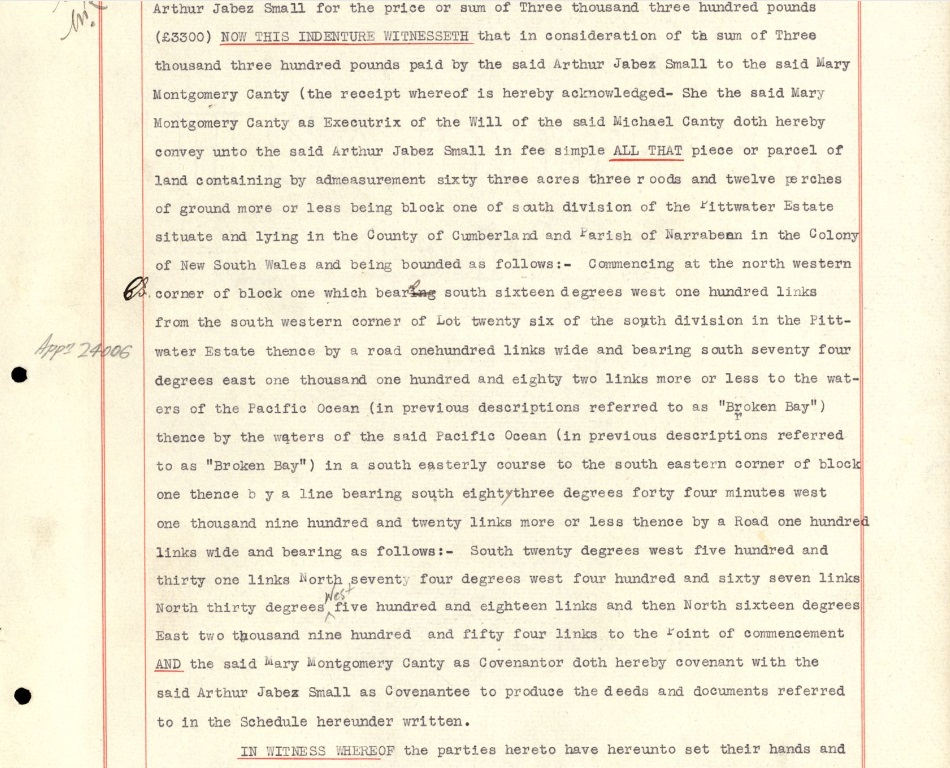
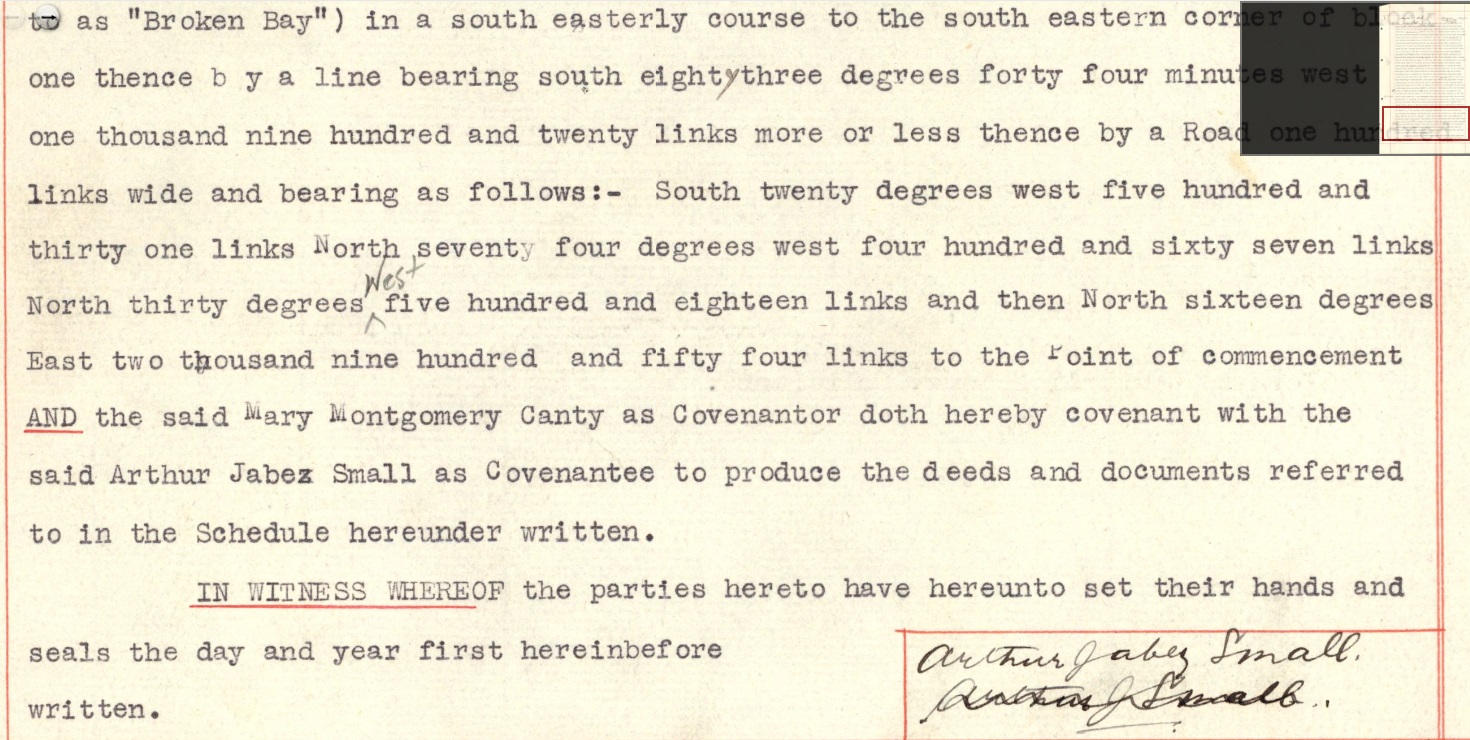
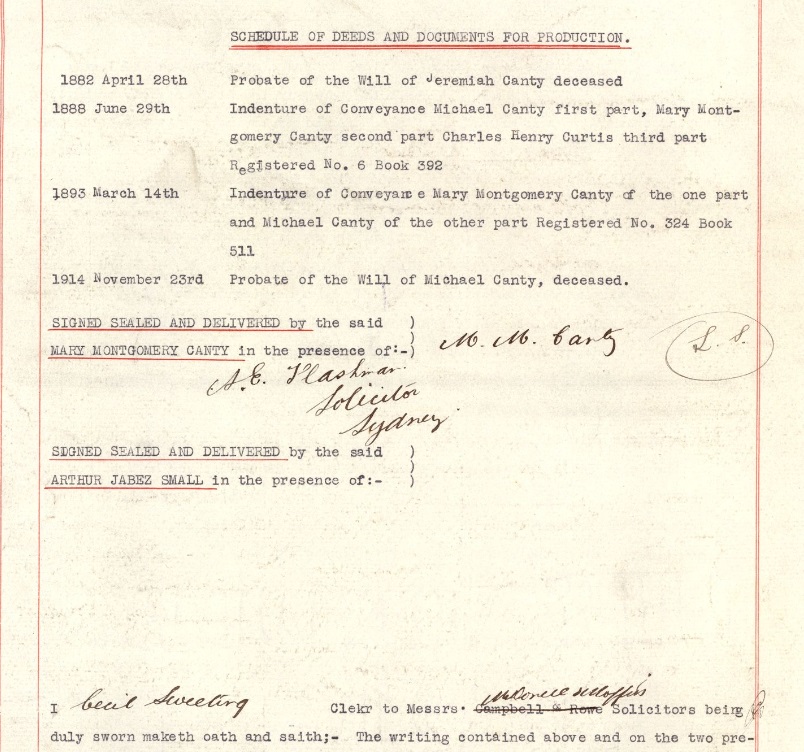
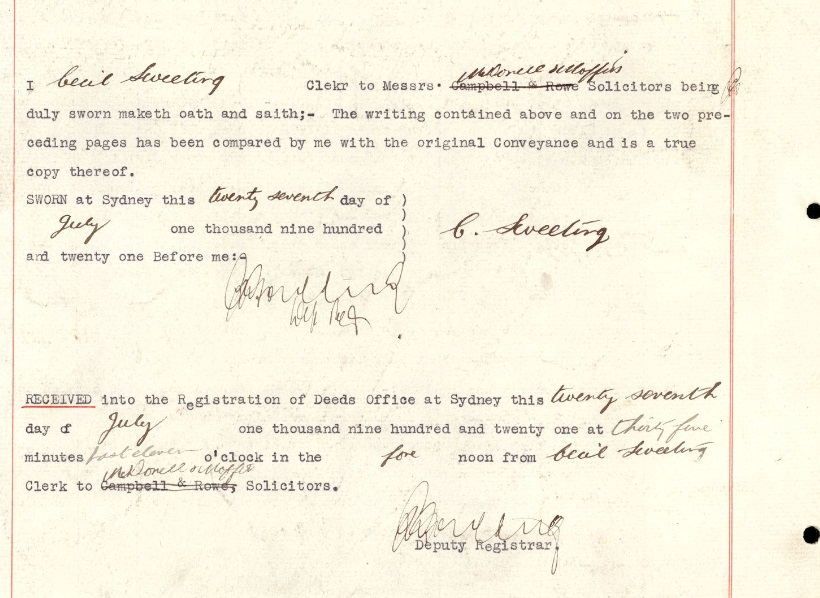
Henry Grant Lloyd
Henry Grant Lloyd, watercolour painter and sketcher, was born in Chester, Cheshire on January 6th 1830 at 3 p.m., according to family records, the third (but eldest surviving) son of Lieutenant Henry Grant Lloyd of the 36th Regiment, Bengal Native Infantry, and Charlotte, née Williams. He was baptised in St John’s Church of England the following day. Having visited Van Diemen’s Land on a year’s sick leave in 1825 his father, now Captain Lloyd, returned to Hobart Town in the Brothers on February 22nd 1841 on two years’ sick leave with his wife, Henry Grant, another son and a servant. Captain Lloyd served a final two years in India, then retired in July 1844, as 'Major', to a large property at New Norfolk, Van Diemen’s Land, which he named Bryn Estyn after the family home in Wales. Henry Grant Lloyd jnr. spent his childhood there.
In 1849 Lloyd became a divinity student at Christ’s College, Bishopsbourne. Two sketches of this institution survive dated 2 November 1849 (NLA) and 24 December 1849 (ALMFA). By 1851 it was clear that he was unsuited to a career in the church, apparently because he was homosexual, and Bishop F.R. Nixon refused to ordain him. This curious item in one of the local papers:
TO THE EDITOR OF THE " COURIER."
Christs's College,
23rd October, 1851.
SIR,-I could have readily spared myself the unpleasant task of trespassing again upon your columns, had I not perceived in Mr. Wedge's last letter, of 13th instant, published in the Courier of yesterday, two false insinuations, which call for immediate contradiction, viz.:
1. He finds it convenient to state that I accused him of having personally communicated the report of Romanizing proceedings, &c. to the Protestant Association. The words with reference to my private conversation with Dr. Fry were these.-" Harry : it's Mr. Wedge ; and I think, he said, you wrote to him about it, but, at the same time, I will not be positive about the last." This, if I mistake not, differs widely from a matter-of-fact-statement ; and "Harry, &c." will apply equally to an indirect means as well as a direct one.
2nd. That the Rev. Warden afforded me " his guidance, &c." in the composition of my last letter, which I most emphatically deny ; and can hardly think it just that, although Mr. W. may have had the assistance of a friend at Bishopsbourne in revising, &c. his own late disreputable production, that the like imputation should be cast upon myself: in short, the virus of Mr. Wedge's letter is only equalled by his unblushing effrontery. It must have been observed by. every reader that Mr. W. has declined to contradict the quotations from his own writings, which I propounded for his consideration,-Secanse, forsooth, they were " absurd, puerile, ire." Let me ask Mr. Wedge wherein his notions of absurdity consist t whether it is in avoiding altogether the " question at issue"-for I have always under-stood that open truth courts enquiry and defies gainsayings; and with respect to "PUERILISM," let me inform the said gentleman that old age does not necessarily bring wisdom,-as his own late proceedings have fully exemplified. I would ask whether the tone of Mr. W.'s letter betokens aught of gentility, still LESS of that " spirit of peace and good-will" which he vainly asserts is deficient in "my esteemed friend Dr. Fry." I would advise Mr. W. to look at home, where he will find sufficient cause for self rebuke without referring to others.
I remain, Sir,
Your obedient servant,
W. GRANT LLOYD. Classified Advertising (1851, October 29). The Courier (Hobart, Tas. : 1840 - 1859), p. 1. Retrieved from http://nla.gov.au/nla.news-article2960000
A few other family notes from the pages of the past:
NEW NORFOLK.
TO THE EDITOR OF THE COLONIAL TIMES.
Bryn Estyn, 4th August, 1854.
SIR, In your issue of the 2nd August, giving some account of the National Temperance movement at New Norfolk, it is stated, that,- - '
" Major Lloyd requested permission to express his views in favor of the movement, and narrated his experience of the workings of strong drink in the Indian army."
Your correspondent has, however, erred in his communication of the very brief remarks made by me on that occasion. They were elicited by a remark made by the previous reverend and eloquent advocate of the movement, to the effect, that strong drink was an acquired, and not an original habit, and not in any way necessary to man. It occurred to me, that, if proof were necessary, attention might well be directed to the natives of British India generally, and I stated to the meeting that in my experience of 24 years in the Bengal Army, I had not known three cases of drunkenness. That the soldiers were able and as ready to their duty, going shoulder to shoulder, as their comrades in the British army, and I appealed to the gallant chairman if it were not so?
I have thought it well to send you this correction to place before your readers (if you will so favor me) lest it should be supposed I had accused my late generous and gallant companions, of a crime almost unknown in their ranks.
- I am
sir, your obedient servant,
HENRY LLOYD. NEW NORFOLK. (1854, August 15). Colonial Times (Hobart, Tas. : 1828 - 1857), p. 2. Retrieved from http://nla.gov.au/nla.news-article8776938
NEW NORFOLK.
SATURDAY, 30th APRIL, 1859.
An inquest was held this morning at Mr Excel's, the Wheat Sheaf, New Norfolk, before Henry Lloyd Esq., coroner, and the following jury a-B. Hubbard, foreman, Messrs. Smith, Bruce, Excel, Gordon, Harris, and Grist, on the body of John Ross, who died suddenly on Friday morning, at the house of a man named Dalton.
From the evidence of Drs. Moore and Alliston, who made post mortem examination of the body, The jury returned a verdict that the deceased died from natural causes. He was 90, years, of age. NEW NORFOLK. (1859, May 9). The Hobart Town Daily Mercury (Tas. : 1858 - 1860), p. 3. Retrieved from http://nla.gov.au/nla.news-article3254884
BURGLARY AND ATTEMPT AT MURDER.
It is not often that either of the crimes mentioned above, now stain the annals of Tasmania. The con-junction of the two is so rare as to have become, of late years, almost unknown. Yet, such an event took place in the usually law-abiding locality of New Norfolk, and the time chosen the earliest hours of Easter Sunday. An advertisement offering £10 for the discovery of the offenders, published in another column, in so far tells its own tale ; but the following fuller particulars are from a reliable correspondent, who says that Mr. Charles G. H. Lloyd, son of Major Henry Lloyd, of Bryn Estyn, whose bedroom is over the entrance to his father's house at Bryn Estyn, was awakened about 1 o'clock on Sunday morning, and thought he heard a noise below. He instantly got out of bed, took up a loaded pistol, and quietly descended the stairs, which reach from the upper story to the entrance hall in front. On reaching the landing near the drawing room, he discovered, to his surprise, that the front entrance door was open. He at same time heard a low talking or whispering, and at once called out "Who's there?" He was instantaneously answered by the discharge of a gun, and heard the whiz of a ball pass near his head. Nothing daunted, he returned the would-be murderer's fire. In levelling his pistol, Mr. Lloyd directed his aim at the flash of the firearm that had been discharged at him, the luxurious foliage of an elm tree near the entrance steps placing the marauders so completely in the shade as to prevent his otherwise guiding his aim, the trueness of which, however, was proved by the presence of blood on the stone steps at the front entrance ; then on a stone roller about ten yards from the door steps, and again on a rail fence bounding the lawn, and some twenty yards from the house.
When daylight enabled an examination of the premises to be made, Mr. Lloyd, on looking about where he stood when he delivered his fire at the burglars, detected an indentation on the wall near, and of the size of a musket ball, and underneath, on the floor, he picked up the ball, which is now in the hands of the Superintendent of Police, New Norfolk,' This event has, of course, created great sensation, and all manner of conjectures are afloat. It is believed that though one of the objects may have been plunder, that there was in this midnight visit 'a deeper crime contemplated, and to this the advertisement evidently refers in the allusion to the w thread."
We believe it is certain that threats have been made against Mr. Lloyd was one of the witnesses in the late conviction at the Supreme Court for sheep stealing, and on the occasion of his then proceeding to town to give his evidence, a gentleman, since deceased, put him on his guard by telling him he had heard that threats against his life had been used. The stock on the Bryn Estyn Estate has for thirty years been the subject of repeated raids, and the past immunity careful watching and stringency most distasteful to the gangs who have been helping themselves, for there is every reason to fear that Sunday mornings 'attack is part of a plan of retaliation. It is horrible to think that such things can be possible among us ; and it is to be hoped that the persons who were engaged in the midnight attack on Bryn Estyn will be brought to justice, and thus cut down in its infancy a heinous offence hitherto unknown in the land. BURGLARY AND ATTEMPT AT MURDER. (1875, March 30). The Mercury (Hobart, Tas. : 1860 - 1954), p. 2. Retrieved from http://nla.gov.au/nla.news-article8936239
LLOYD.-On June 23, at her residence, Bryn Estyn, New Norfolk, Charlotte, the beloved wife of Major Henry Lloyd, in the 73rd year of her age. The funeral will take place at New Norfolk, on THIS DAY, the 26th, at 2 o'clock p.m. Family Notices (1878, June 26). The Mercury (Hobart, Tas. : 1860 - 1954), p. 1. Retrieved from http://nla.gov.au/nla.news-article8964738
DEATHS. DELAMAIN.—On October 19, at Brighton, England, Major-General W. H. Delamain, late of H.M. Royal Horse Artillery, and son-in-law of Major Henry Lloyd, of Bryn Estyn, New Norfolk, Tasmania. Family Notices (1879, February 12). The Mercury (Hobart, Tas. : 1860 - 1954), p. 1. Retrieved from http://nla.gov.au/nla.news-article8973626
LLOYD.-On February 28, at Bryn Estyn, New Norfolk, the wife of C. G. H. Lloyd of a daughter. Family Notices (1879, March 3). The Mercury (Hobart, Tas. : 1860 - 1954), p. 1. Retrieved from http://nla.gov.au/nla.news-article8974334
LLOYD.—On April 29, at Bryn Estyn, New Norfolk, Tasmania, Major Henry Lloyd, H.E.I.C.S., in the 80th year of his age. The funeral will take place at 3.30 p.m. TO-MORROW (Friday). Melbourne, Sydney and Brisbane papers please copy. Family Notices (1879, May 1). The Mercury (Hobart, Tas. : 1860 - 1954), p. 1. Retrieved from http://nla.gov.au/nla.news-article8976455
CREDTORS' NOTICE.
ALL PERSONS having CLAIMS against the Estate of the late MAJOR HENRY LLOYD, of Bryn Estyn, New Norfolk, are requested to send the same for adjustment to the Executors, under cover to ROBERTS & ALLPORT. Stone Buildings, June 26,1879. Advertising (1879, June 30). The Mercury (Hobart, Tas. : 1860 - 1954), p. 1. Retrieved from http://nla.gov.au/nla.news-article8978463
DELAMAINE. —On August 26, at her residence, Hereford-road, Bayswater, England, Jane, relict of the late Major-General W. H. Delamaine, R.A., and only daughter of the late Major Henry Lloyd, of Bryn Estyn, New Norfolk, Tasmania.
LLOYD. —On September 13, at Port Hope, Canada, Maria Rosa, wife of the Rev. Arthur Lloyd, M. A., and youngest daughter of the late Colonel John Lloyd, C.B., R.A., of Chester, and niece of late Major Henry Lloyd, of Bryn Estyn, New Norfolk, Tasmania. Family Notices (1892, November 26). The Mercury (Hobart, Tas. : 1860 - 1954), p. 1. Retrieved from http://nla.gov.au/nla.news-article13294947
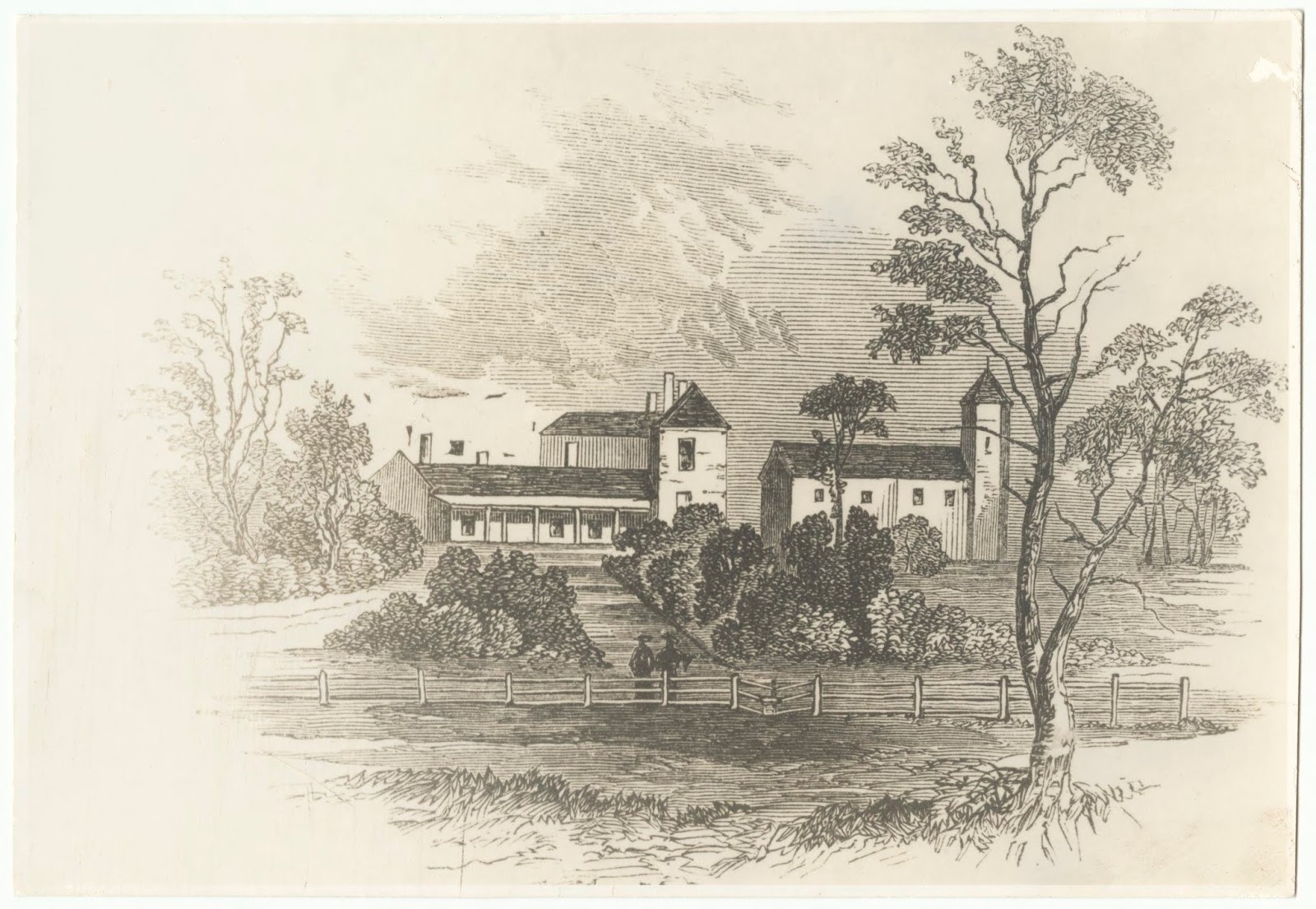
Christ College, Bishopsbourne (1856) Tasmania. H Butler Stoney. Libraries Tasmania: LPIC147-1-116
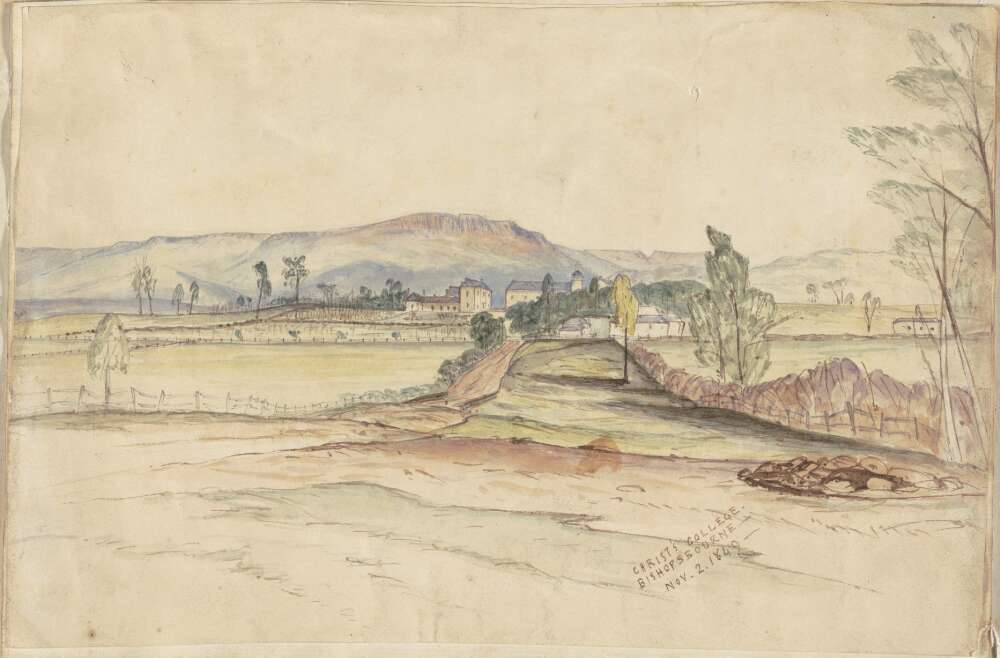
Lloyd, Henry Grant. Christ's College, Bishopsbourne, Nov.2, 1849 [picture] / [Henry Grant Lloyd] 1849, courtesy National Library of Australia
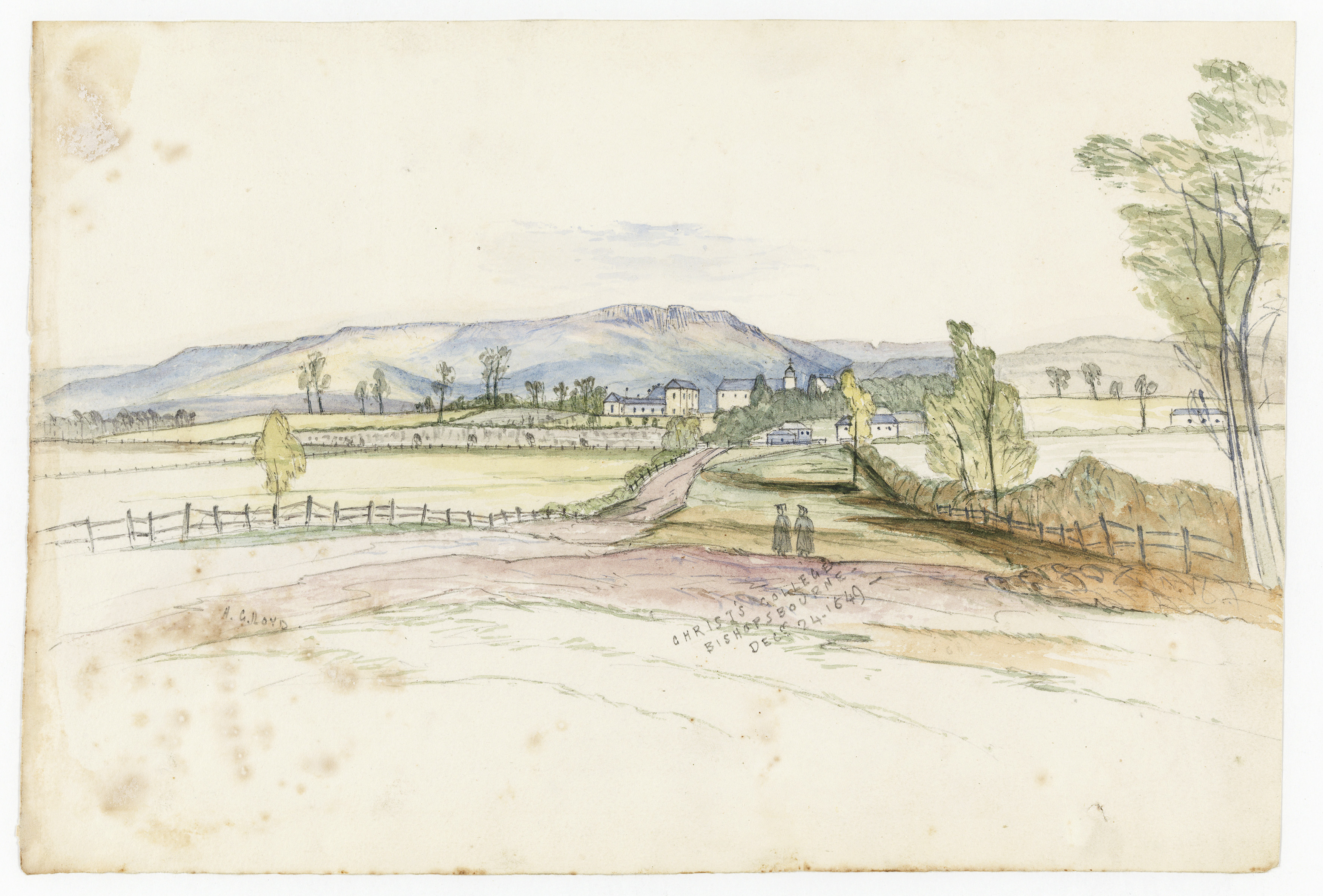
Christ's College Bishopsbourne Decr. 24, 1849 / H.G. Lloyd. Digitised item from: Allport Library and Museum of Fine Arts, Tasmanian Archive and Heritage Office, AUTAS001144581444, courtesy State Library of Tasmania
Christ College is the oldest tertiary institution in Australia and is a residential college of the University of Tasmania. In 1840, Christ College was first proposed in Lieutenant-Governor Sir John Franklin's Legislative Council. The college was opened on October 1st 1846, founded in Bishopsbourne, modelled on the Oxford and Cambridge colleges, as an Anglican college. By 1856, the college closed due to bad financial conditions. In 1879, the College re-opens in Hobart and in 1885, the institution moved to the Hobart High School premises on the Domain on a seven year lease. In 1892, the lease was not renewed because of the foundation of the University of Tasmania. In 1911, the College reopened as the matriculation section of the Hutchins School. In 1926, The Christ College Act receives Royal Assent. In 1929, a move of staff and students into an enlarged site in Park Street occurred and in 1933, the institution was formally affiliated with the University as its first residential college. In 1971, the College relocates to Sandy Bay, near Hobart.
As a result of this 'Harry’ Lloyd was shingle-splitting in the Huon Valley in 1853, according to an entry in the diary of Mary Morton Allport – who thought it shameful for his mother. It did not last long.
Mr. Lloyd’s chief occupation between 1846 and 1857 appears to have been sketching landscape scenery all over Tasmania, his earliest known sketch being dated 27 January 1846 when he was possibly a student of John Skinner Prout. In a later advertisement Lloyd claimed to have been taught by Prout, an artist who provided an undemanding, picturesque grounding for a large number of Van Diemen’s Land amateur artists. In 1874 he announced the fulfilment of a long-cherished ambition to publish a book called 'Tasmania Illustrated’ in imitation of Prout, but it failed to materialise.
A coloured lithograph after one of Lloyd’s drawings, Hobart Town from the New Wharf, was published by M. & N. Hanhart of London about 1859, the skill of the lithographer W.L. Walton as much as the work of Lloyd, whose draughtsmanship was never strong, is apparent to modern critics. By the time it was published Henry Lloyd was living in Sydney, where he took drawing lessons from Conrad Martens and visiitng Pittwater.
Henry Lloyd travelled indefatigably throughout his long life, seemingly obsessed with recording every landscape he saw. Despite some delicate drawing showing the influence of Martens, the majority of his works are rough field sketches rather than finished paintings. Their chief value lies in their interest as historical documents, for Lloyd was meticulous about naming, dating and signing his sketches; many even have compass directions. He was more successful with close focus than distant views, even though the latter far outnumber the former, and he certainly visited and drew places recorded by few other artists. At a conversazione held by the New South Wales Academy of Art on November 9th 1875, Eccleston du Faur was reported as urging the beauties of the Hawkesbury River, 'the Rhine of Australia’ Anthony Trollope had named it. Yet, du Faur stated, 'how many in this room have ever seen it below Windsor? ... Has it ever been illustrated, except, I think, at Wiseman’s Ferry by Mr C. Martens, and near its mouth by Mr. Slade [q.v.], and roughly sketched by Mr. Grant Lloyd of Tasmania.’
Other New South Wales and Queensland views were sketched in 1858-64 and 1875-80. In between Henry Grant Lloyd revisited Britain and went on a sketching tour of Wales, returning to Tasmania in 1872-75. He revisited the Grose Valley (NSW) for a few days in 1875, joining the painting and photography camps which Eccleston du Faur had established for members of the NSW Academy of Art and 'other gentlemen’, the chief guest being Lloyd’s fellow Tasmanian, W.C. Piguenit .
A private income meant that he had no need to sell his work, although he did find a market for some of his watercolours. More important to him was the status and exposure gained through local and international exhibitions, at which he won several medals. He exhibited at the 1875 Melbourne Intercolonial Exhibition and the following year was included in the Philadelphia Centennial Exhibition.
Except for an Australian sojourn in 1887-89, he lived in Dunedin from 1881 to 1899 and travelled throughout New Zealand; his watercolour, The Terraces, Rotamahana, New Zealand, is dated 1881 (Sotheby’s Fine Australian and European Paintings’ auction 28-29 April 1998, lot 388). He exhibited with the Otago Art Society at Dunedin in 1882, 1884, 1886-88, 1890-95, 1898 -99 and 1900-03, showed paintings with the New Zealand Academy of Fine Arts in 1896 and was included in the New Zealand and South Seas Exhibition of 1889-90. He also showed work at the 1891-92 Tasmanian Exhibition in Launceston and the 1894-95 Hobart International Exhibition.
In 1900 Mr. Lloyd returned to Tasmania to help with the management of Bryn Estyn.
SUPPOSED ACCIDENT
TO MR C. G. H. LLOYD WHILE SHOOTING
This afternoon we received a telephonic communications from New Norfolk slating that considerable excitement and concern prevailed in that pretty little township as the news spread that it was feared that a serious if not fatal accident had occurred to that well-known and highly esteemed member of the community —Mr Charles Griffith Hamilton Lloyd, J P, of Bryn Estyn. Mr Lloyd, who is a keen sportsman, left in his buggy, taking with him his gun, for Arthur's Marshs, distant about five miles from New Norfolk, with the idea of shooting some birds which he desired for stuffing. He arrived all well at a friends house at Arthur's Marsh, and there borrowed a boat, stating that he would not be very long away. He not returning for some time his friends became alarmed and a search was made, and this morning the boat was found floating bottom upwards, with the sails, oars, and other gear all correct, but there was not the slightest sign of Mr Lloyd or his gun. The information was at once communicated to the police at New Norfolk, and soon a large number of persons were engaged in the search for Mr Lloyd. It is feared that he has either met with serious accident on land which has disabled him, or that he has been drowned. SUPPOSED ACCIDENT, (1897, August 25). Tasmanian News (Hobart, Tas. : 1883 - 1911), p. 4 (THIRD EDITION). Retrieved from http://nla.gov.au/nla.news-article172888895
On Friday afternoon I had the pleasure, on the invitation of Mr. Edward Lloyd, of a trip out to Bryn Estyn, one of our southern homes. The road skirting the Derwent is one of the most pleasant walks or drives in the district, the long stretches of river always in view, and always changing, fringed with overhanging willows, varied by the more sombre native foliage, and lovely alike in their mirror-like placidity or "dark heaving" under the sea breeze of a summer day.
Bryn Estyn contains 1,360 acres, and has been in possession of the family for about 60 years. The house, a handsome stone structure of semi-Gothic style, is perched on the shoulder of a slight eminence overlooking the Derwent, and directly opposite the Falls railway siding. The outbuildings are also of freestone, of which there is an excellent quarry on the property. While discussing a supplemented biscuit, I was shown a number of curios collected by the late Mr. C. G. H. Lloyd. One I admired very much was an inlaid paper weight, a fragment of marble from the Taj Mahal Palace in India. I was also shown some of the birds stuffed by the deceased gentleman, who made a hobby of taxidermy.
We then took a turn round the cultivated paddocks, of which there are about 130 acres, and which surprised me by their vigorous and healthy growth. We first passed through a paddock of field peas, estimated to yield 30 bushell to the acre, and of so edible a variety that marauders without the luxury of a kitchen garden occasionally obtain a dish unbidden. In the adjoining paddock a crop of wheat in succession to peas should, with even fairly favourable weather, go over Mr. Lloyd's estimate of 35 bushels to the acre. North of the home-stead are several paddocks of strong growing oats, some of it just ready for the mower.
Work in the orchard of 30 acres, more than half in full bearing, is rather back-ward, but the trees all look bright and healthy, and promise a bountiful crop, as Mr. Lloyd informed me he had good grounds for believing the codlin moth would not be so prevalent as in former years. Some of the trees which at present look strong and vigourous, were infested with scaly blight, but this has been conquered by spraying with caustic soda and whale oil. A tree round the roots of which sulphur had been dug in showed fair signs of recovery, but was not as healthy looking as those treated with soda and oil. The orchard land consists of a sandy soil, with strong clay subsoil; the wheat land is a reddish, decomposed basalt; the bush land, which carries a fair number of sheep, extends to Dry Crook.
Mr. Lloyd gave me two apples (New Yorks), treated by his father by a special process in the early part of June. I tried one, and though slightly shrivelled on one side, the flavour was decidedly good. NEW NORFOLK. (1897, December 8). The Mercury (Hobart, Tas. : 1860 - 1954), p. 1 (The Mercury Supplement). Retrieved from http://nla.gov.au/nla.news-article9410804
Marriages.
LLOYD—BYRNE.—On August 3, at St. Matthew's Church, New Norfolk, by the Rev. J. Oberlin-Harris, M.A, Edward Lloyd, of Bryn Estyn, New Norfolk, to Lavinia Florence, eldest daughter of Mr. James Byrne, of New Norfolk. Home, Indian and colonial papers please copy. Family Notices (1898, August 17). The Mercury (Hobart, Tas. : 1860 - 1954), p. 1. Retrieved from http://nla.gov.au/nla.news-article9428780
In Memoriam
EXCELL.-In loving memory of our dear son Edward Arthur Excell, who was accidentally shot at " Bryn Estyn" estate, New Norfolk, on January 6, 1899, aged 21 years.
'Tis just twelve months ago today
Since my dear brother passed away;
The trial was hard, the pain severe,
I little thought his end was near.
O, hard it is to part on earth
With one we loved so dear;
But harder still it is to part
Without one farewell word or tear.
Inserted by his loving mother and sister, Mary and Elizabeth EXCELL. Family Notices (1900, January 6). The Mercury (Hobart, Tas. : 1860 - 1954), p. 1. Retrieved from http://nla.gov.au/nla.news-article12773295
Death has again visited us. Mr. Edward Lloyd, formerly of Bryn Estyn, passed away peacefully on Monday after a rather long illness. Mr. Lloyd was at one time secretary to the local Board of Agriculture, and secretary and inspector to the New Norfolk Fruit Board. At the time of his death, he was fruit inspector for the Cumberland district, and a member of the Prince Alfred Lodge, MAIN. Order of Oddfellows. He also belonged to the Masonic craft. The deceased was much respected, and his genial disposition rendered him popular with all who knew him., by whom his early death is universally regretted. He leaves a widow and one child. The funeral, which was very largely attended, took place on Wednesday, 5th inst. About 40 Oddfellows preceded the hearse, and the long cortege ended with a number of carriages, conveying leading residents. June 5. NEW NORFOLK. (1901, June 12). The Mercury (Hobart, Tas. : 1860 - 1954), p. 5. Retrieved from http://nla.gov.au/nla.news-article12841740
SALE OF AN ESTATE. HOBART, Friday. The well-known estate of Bryn Estyn, near New Norfolk, has changed hands, the purchaser being Mr. W. J. J. Reynolds head master at the Central state-school. It will be remembered that Mr. Lloyd, the owner, disappeared some years ago, and his whereabouts have never been ascertained. Since then Mrs. Lloyd and her son have resided on the estate. SALE OF AN ESTATE. (1901, October 5). Examiner (Launceston, Tas. : 1900 - 1954), p. 11 (DAILY.). Retrieved from http://nla.gov.au/nla.news-article91656270
This item shows that if Henry Grant Lloyd was going to go on a walking-sketching tour again he may have needed a horse along the way and a soft cloth to polish his glasses:
WILL Persons who took Crooked Handled Walking Stick from Verandah and Spectacles from Mantel-shelf on Bryn Estyn, Sale Day Return Post Office, New Norfolk Henry Lloyd. Advertising (1901, November 5). The Mercury (Hobart, Tas. : 1860 - 1954), p. 3. Retrieved from http://nla.gov.au/nla.news-article9574778
"Bryn Estyn," 1360 acres, New Norfolk, Mr. Hedberg, £6000 PROPERTY SALES. (1903, August 7). Examiner (Launceston, Tas. : 1900 - 1954), p. 6 (DAILY.). Retrieved from http://nla.gov.au/nla.news-article35558150
At the end of 1903 this compulsive traveller was preparing for yet another tour of Tasmania when he was seized with paralysis. He died on May 31st 1904, possibly at the home of his sister-in-law, and was buried in the New Norfolk Cemetery. His brother Charles, who had gone missing when he went to shoot birds on the river, finally had his probate resolved after his passing.
Henry's last known sketch is dated August 1903. Surviving drawings are numbered in the thousands. There are over 1,500 in the Mitchell and Dixson Library collections of the State Library of NSW. The Allport Library and Museum of Fine Arts also has a substantial collection, and the National Library of Australia hold a sample of watercolours. - [4.]
NEW NORFOLK- Benwerrin," Burnett-street, Private Board and Residence. Mrs. Lloyd _
NEW NORFOLK, "Benwerrin," Burnett-street, Private Board and Residence. Mrs. Lloyd. Advertising (1904, February 6). The Mercury (Hobart, Tas. : 1860 - 1954), p. 1. Retrieved from http://nla.gov.au/nla.news-article9677215
DEATHS. LLOYD.—On May 31, at New Norfolk, Henry Grant, eldest son of the late Major Henry Lloyd, 30th Bengal Native infantry. Funeral at 3 p.m. This Day (Wednesday). Indian, English, New Zealand, and New South Wales papers please copy. Family Notices (1904, June 1). The Mercury (Hobart, Tas. : 1860 - 1954), p. 1. Retrieved from http://nla.gov.au/nla.news-article9683479
PROBATES. The following probates have been issued :—; Charles Griffith Hamilton Lloyd to The Perpetual Trustees Executors and Agency Company of Tasmania Limited, £2,026; PROBATES. (1906, February 6). The Mercury (Hobart, Tas. : 1860 - 1954), p. 4. Retrieved from http://nla.gov.au/nla.news-article12754580
WHEREAS CHARLES GRIFFITH HAMILTON LLOYD late of Bryn 'Estyn near New Norfolk in Tasmania deceased departed this life on or about the twenty fourth day of August 1897 and the under signed The Perpetual Trustees Executors and Agency Company of Tasmania Limited have obtained Probate of the Will of the said Charles Griffith Hamilton Lloyd.
NOTICE is hereby given that all parties having claims on the Estate of the said Charles Griffith Hamilton Lloyd are required to send in to the Registrar of the Supreme Court of Tasmania the particulars of such claims in writing on or before the third day of October now next other wise they will be excluded from any benefit of the assets In the hands of the said Executors
Dated this second day of September 1907. The Perpetual Trustees Executors and Agency Company of Tasmania Limited E. AIETWSON, Manager. Advertising (1907, September 3). Examiner (Launceston, Tas. : 1900 - 1954), p. 8 (DAILY). Retrieved from http://nla.gov.au/nla.news-article45828920
MONDAY, January 9.
FIRST-CLASS PROPERTY IN DERWENT VALLEY. -
ROBERTS AND CO. LIMITED
Have received instructions from O H. Hedberg, Esq., to sell at their Mart, Murray-street, on MONDAY, January, 9, at 12 o'clock,
THAT MAGNIFICENT PROPERTY known as BRYN ESTYN, situated two and one-half miles beyond New Norfolk, and comprising in all about 900 acres of land, together with the whole of the LIVE AND DEAD STOCK, as follows:- ,
ORCHARD- 50 acres (mostly apples) in full bearing, planted with the choicest trees, in first-class order, and the orchards could be extended almost without limit. With the orchard are apple-house, 3,000 to 4,000 case material, apple Branch motor spray pump, etc, etc.; a good sitting of fruit is assured. .
HOPGROUNDS:-30 acres, mostly in full bearing, irrigated by two-cylinder 2, h.p. Marshall engine and centrifugal pump, throwing 150,000 gallons to highest point whence it is distributed over the estate, The lower hop ground is also watered by 6 h.p. oil engine and 6in. centrifugal pump. Ample wood exists on the property for firing the engine, and a new hop-kiln has been erected only last year.
CULTIVATION:-200 acres now under cultivation, and 200 more could be easily brought under; 50 tons of this seasoned hay will pass with the property.
IMPROVEMENTS: Stone House of 14 rooms, with h. and c. water, and put by its present owners into first-class order.
Out stone barn, blacksmith's, engineer a carpenter's shop, and 4 men's cottages are among the other buildings. Wire fences have been erected, and all fencing has been made good throughout.
LIVE AND DEAD STOCK The whole of the live and dead stock will be sold with the property, comprising draught horses, sheep, pigs, etc., etc.; and also all farm implements, one stand Cooper shearing machine, etc., etc" .
Other advantages ' noticeable with this property is the quantity of firewood on the run, which will become a more valuable asset each year, and also the "stone quarry (from which was obtained the stone for the Hobart G.P.O.), with crane, cottage, etc.
The long frontage, about a mile, upon the Derwent and proximity to the Falls Station may also be mentioned. The whole of the above will be sold in one lot as a going concern, and offers an exceptional opportunity to obtain a magnificent property highly improved Inventories of the live and dead stock will be supplied to intending purchasers previous to the Sale L., Reference-Messrs. Dobson, Mitchell., and Allport. Solicitors. Hobart
Printed and published by the Property Solicitors, DAVIES BROTHERS LIMITED.
at their Office, 87 Macquarie street, Hobart. Advertising (1910, December 21). The Mercury (Hobart, Tas. : 1860 - 1954), p. 8. Retrieved from http://nla.gov.au/nla.news-article10086040

[View of] New Norfolk - from Bryn Estyn, 29 Aug. 1847 / Henry Grant Lloyd. 'No. 51.' is written in ink in top left corner - courtesy Dixson Library, State Library of New South Wales
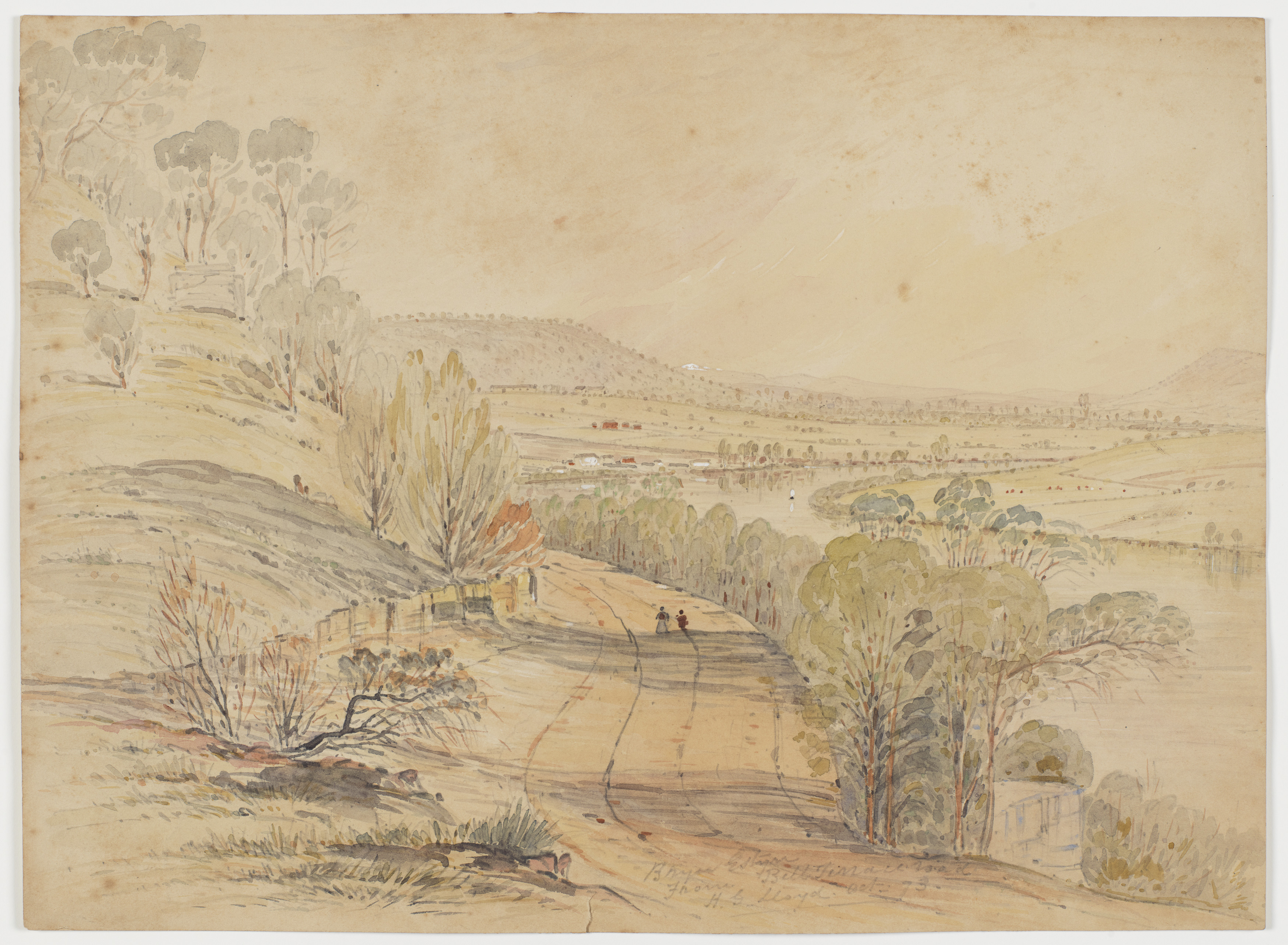
[View of] Bryn Estyn, from Bell Terrace Road, October 1873 / Henry Grant Lloyd, courtesy Dixson Library, State Library of New South Wales
William Govett
What's interesting about Henry Lloyd's sketches of Barrenjoey is these compared to a circa 1834 sketch by William Govett, who was on staff of Major Mitchell, Surveyor General of New South Wales, 1830-1835, taken from what looks to be the Palm Beach side of the tombola showing a different perspective of the headland:
Colonial Statistics. BROKEN BAY AND BRISBANE WATER - 1838
THERE is no part the colony within a hundred miles of Sydney, which has either been so long settled, or so little frequented by travellers from our colonial capital, as the country intervening between Port Jackson and Broken Bay. It is a broken, sterile, and uninteresting country for the most part; but there are particular spots in it of a much superior character, and the scenery in certain localities, especially along the coast, on the Narrabeen Lagoon and the inlet called Pitt Water is exceedingly fine. We happened to make a pedestrian tour from Manly Cove, on the north side of the harbour near the Heads, to Broken Bay a few weeks ago; and, although we cannot say much either for the country or the road, there is nevertheless sufficient to be gleaned by a careful observer ever in such a tour as to prevent us from saying, " it is all barren." In fact, as the finest flowers and shrubbery are generally found on the most barren land, it is not always the best land that will furnish the best subject for a good literary article.
An extensive bottom, as the farmers would call it, of the richest alluvial soil may be exhibiting to the delighted eye of the settler a splendid crop of maize; or a series of "flats," with not a tree upon them in their natural state, may present the finest wheat land in the world ; but we confess there is very little bottom for a good article in either case, and even a good writer soon becomes flat enough unless he takes a kangaroo leap to some subject of a more interesting or spirit-stirring character. To be threading one's way, how- ever, through a tangled wood while the loud roar of the vast Pacific's big ocean waves breaking ever and anon on the ironbound coast of this vast terra incognita, is sounding in one's ear like distant thunder, or like the roar of artillery — to mount one of those barren hills that stretch along the coast to catch a glimpse of the wild, but romantic scenery around from its rocky summit — to be walking by moonlight along one of the sandy beaches that line the shores of Pitt Water, the exact counterpart of one of our finest Scotch Highland lochs—to be arriving late in the evening at some small settler's farm, who has just been six months on his land, to be regaled with tea without sugar out of a common water-jug, and a piece of a damper—to sleep, or rather to attempt to sleep with a host of active little combatants as numerous and as formidable as a Roman legion— and finally to lose one's way for five or six hours in the bush, and to arrive at the North Shore with one's clothes so torn with the prickly shrubbery of that locality as to render it necessary to bivouac for a time till the sun has gone down on the town of Sydney, and darkness covers the land—these are the subjects which one can either write upon, or read about without getting tired or complaining of flatness.
There is a respectable family of the humbler walks of life settled at Manly Cove whose establishment exhibits in a very strong light, the immense benefits which this colony will eventually derive from the introduction of reputable and industrious families of a similar class in society into its extensive territory, under the admirable system introduced by the Whig ministry, in appropriating for that most important purpose the proceeds of all Crown land sold in the colony. The family we allude to is of the name of Parker. It consists of a husband and wife, rather past the middle age, and two stout young men, their sons. The father is a gardener, who emigrated with his family from England to the Cape of Good Hope a good many years ago, but preferring this colony, from all he had heard and read of it both in England and at the Cape, came on to New South Wales, leaving his third son in business at Cape Town. One of Mr. Parker's other two sons is a stonemason, and the other a carpenter and cabinetmaker, each of whom appears to be as much an adept in his own business as his father, who is a remarkably intelligent, shrewd, and well-principled old man, evidently is in his. Mr. Parker has purchased twenty acres of land and rocks on the eastern side of the cove, part of which he has laid out very tastefully, his two sons having been occupied in the mean time in erecting a neat stone walled cottage with suitable outhouses, part of the walls of both being the solid rock, which has been hewn away in certain places, and allowed to remain in others to suit the taste or convenience of the proprietor. In short the combination of mechanical force which Mr. P.'s virtuous and respectable family have been able to bring to bear on their little property is one of the happiest we have witnessed in the colony, and the result, we are confident, within a very few years hence will be the transformation of their twenty acres of rocks and land, hitherto deemed good for nothing, into one of the best cultivated, most romantic, and most valuable properties of its size within a day's journey of the capital. Mr. P.'s object has been to establish himself as a gardener and nurseryman, to supply the Sydney market with vegetables, fruit, fruit- trees, and shrubs.
As soon as a few small steam boats, such as ply on the river Mersey between Liverpool and the numerous little thriving villages along the Cheshire shore, are procured and set to work in our harbour of Port Jackson to ply between Sydney and the more important localities on the opposite shore, every acre of available land within a reasonable distance of the North Shore, will be increased in value several hundred per. cent. We are happy to find that an experiment of this kind is about to be tried by the establishment of a Steam Ferry Boat between Dawes' Battery and Billy Blue's Point. The establishment of such a boat will not only lead to the formation of several thriving villages on the North Shore, but will set an example which some people will soon follow by placing boats of a similar kind on other short courses within the harbour. Within a few miles of Manly Cove, from which there is a tolerable road for a considerable distance towards Broken Bay, there is more available land than we anticipated finding, and there is already something doing also in the way of improvement; the important operations of felling, fencing, and cultivating, being pursued by certain proprietors in that neighbourhood with some vigour. A very large portion of the land, however, is irreclaimably and hopelessly sterile.
On the banks of the Narrabeen Lagoon, a pretty extensive and romantic sheet of water situated about nine miles from Manly Cove, and communicating with the ocean in high floods there is a small extent of superior land for cultivation with a considerable tract of very fair pasture land belonging to the family of the late Mr. Jenkins, of Sydney; and about three miles farther on, towards the head of Pitt Water, there is a very fair cultivation farm leased to a small settler of the name of Foley. But the patches of arable land all along from Port Jackson to Broken Bay, are generally of such limited extent and the pasture land of such inferior quality to the forest land of the interior, that there must always be a very limited and widely scattered population in that part of the territory.
The South Head of Broken Bay is called by its native name, Barranjoey. It is a bold, rocky headland, situated at the extremity of a long narrow strip of land separating the main ocean from Pitt Water, and has evidently been an island at some former period, with a spit of sand running out from it towards the south. This sand-spit would be gradually extended by every gale till the island was at length married indissolubly to the main, the ceremony of joining hands having been performed by Father Neptune himself. There is a small patch of alluvial land of the first-rate quality near Barranjoey Head, on which a very industrious small settler of the name of Sullivan has set down, within the last few months, on a lease from Mr. Wentworth, the proprietor. The extent of land he has managed to clear and put into crop in so short a time, is as creditable to the settler as the splendid crop of maize and tobacco it bears is to the land. The neighbour-hood of Pitt Water and Brisbane Water is considered particularly favourable for the growth of onions, and the raising of that useful article of horticultural produce for the Sydney market, is the main dependence of the small settlers in these districts. The past season has been considered rather unfavourable, however, for this crop, the late rains, which have come in such good time for the maize, having been too late for the onions; but we found a very tolerable crop notwithstanding on various farms in both districts.
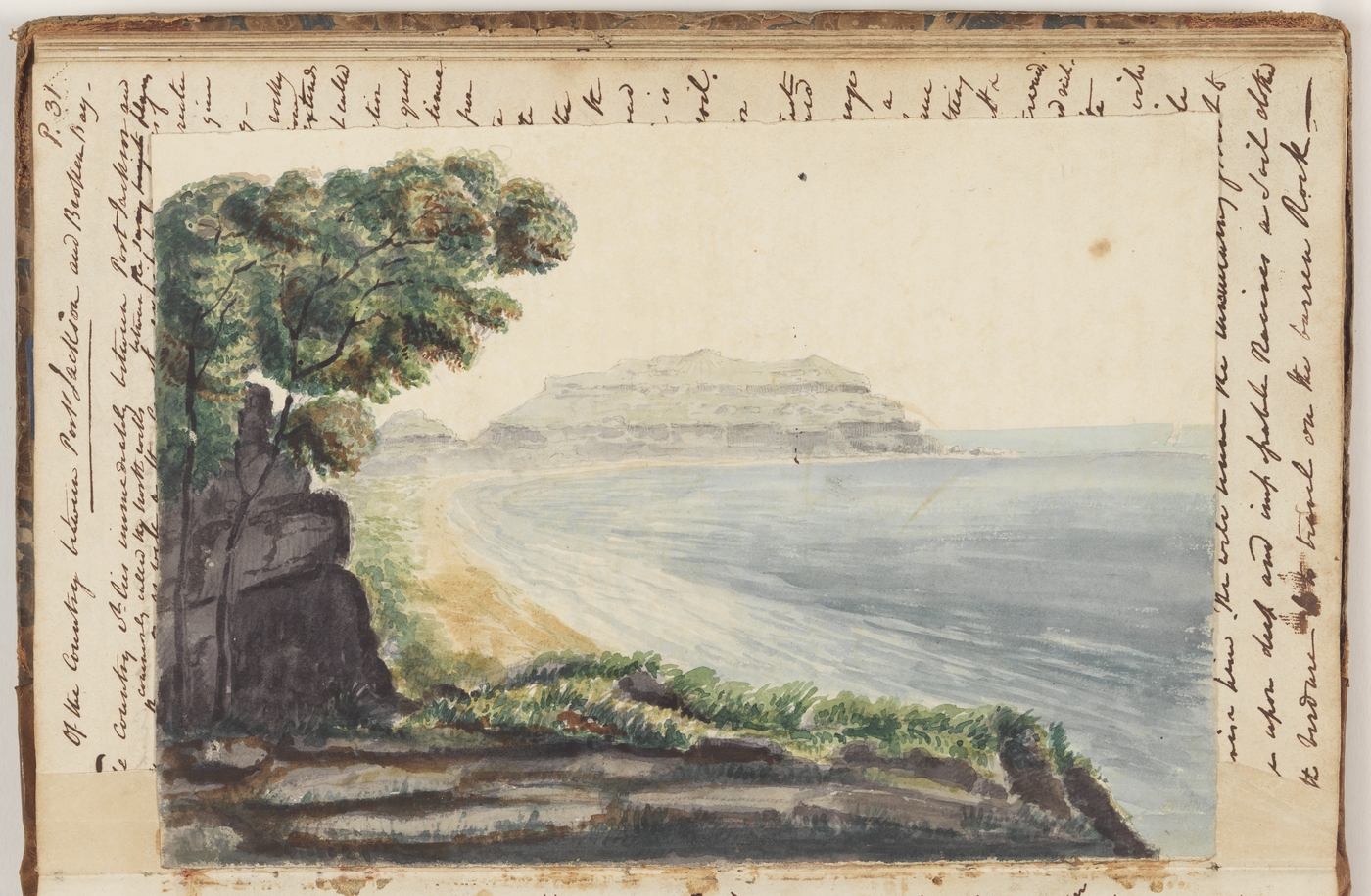
'South Head of Hawkesbury River called by the Natives Barrenjuee [sic]'. W.R.G. Image No.: a5504050 from; William Govett notes and sketches taken during a surveying Expedition in N. South Wales and Blue Mountains Road by William Govett on staff of Major Mitchell, Surveyor General of New South Wales, 1830-1835
The scenery near Barranjoey is romantic and interesting in a very high degree, the land and water being finely disposed for a picture, and the forest trees on the low ground along Pitt Water being remarkably umbrageous and beautiful, while the view from the Head itself — including the vast Pacific; Pitt Water separated from it by the narrow strip of land above-mentioned, and running up for the remaining part of its extent between two ranges of considerable elevation, and losing itself at length in the distance; Broken Bay, with the lofty, precipitous rocky island, called Mount Ellis, guarding the entrance of the Hawkesbury, and standing off, like a sentinel on duty, from its opposite shore, while the lower reaches of that noble river are seen stretching far inland between the lofty and barren ranges that line the whole extent of its course from the Blue Mountains to the ocean — all this is uncommonly fine.
Second or third-rate writers of literary articles of this kind regularly wish for the pencil of a Claude, or a Salvator Rosa, when they find themselves in such situations as we found ourselves in, to our no small gratification and delight, when we stood perched for a time on Barranjoey Head ; but as such idle wishes would not save any of our readers who might be desirous of experiencing the same pleasurable emotions, the trouble and fatigue of a long pedestrian tour through the bush, we shall not put ourselves to the trouble of uttering them. If any of our readers should be desirous of visiting the district of Brisbane Water, which we can assure them is well worth visiting, we would by all means advise them to postpone their visit till some of our enterprising colonial speculators shall have put a steam-boat on the course between Sydney and Brisbane Water.
For our own part we crossed Broken Bay in Sullivan, the small settler's small boat; and as there is a large extent of shallow water on the north side of the Bay, on which the sea breaks violently (whence its appropriate name, Broken Bay) whenever there is the least wind from certain quarters, we confess that sailing in such a vessel is somewhat dangerous. Rollers rise instantaneously, even in the mildest weather, in the Bay, and when one of these breaks on a small boat she is almost sure to be swamped, and all on board drowned. Brisbane Water is an inlet from Broken Bay, opening into the land at its north-eastern extremity. There is a reef of rocks extending for a considerable distance across the entrance from south to north, but the channel is sufficiently wide for those who are at all acquainted with the locality. The inlet, for a considerable distance up, is exactly like the embouchure of a large river, and as there are several other inlets of a similar kind opening into the main one, as Broad Water, Kingcumber or Cockle Creek, the district is a complete alternation of land and water, affording excellent means of communication for the settlers and most delightful scenery. Both along the banks of the main inlet and the other two just mentioned, there are settlers' houses for the most part picturesquely situated with a greater or smaller extent of land in cultivation around them according to circumstances.
There is much alluvial land of the first quality in the district, and the crop of maize, wherever we had an opportunity of observing it, was quite magnificent. Maize, onions, shingles, and sawed timber are the principle productions and exports of the district, and from the large quantity of these articles that have been exported to Sydney during the last few years, the settlers generally, we were happy to find, are in a thriving condition. Indeed, the district of Brisbane Water has sufficient resources for the sustentation and employment of a large population, and its vicinity to the capital will certainly attract numerous and reputable families and individuals as permanent residents in it whenever it is thrown open to the public by the establishment of a steam communication with the capital. From the want of such a communication at present Brisbane Water, although within four or five hours sail of Sydney, is virtually as distant from it as Port Macquarie, and till such a mode of communication with it is established, its re- sources will never be developed nor its rapid advancement both in population and in importance generally secured. It is a matter of astonishment, therefore, to us, that while there is such a rage exhibited in the colony, on the part of certain of our colonial speculators, for the extension of steam communication with Hunter's River, the capabilities of a district, so much less extensive it is true, but so much nearer hand, should hitherto have been so totally neglected.
There are at present three steam boats running between Sydney and Hunter's river, and a fourth is expected to commence plying immediately. Now, whether this is overdoing the thing or not we have no means of determining; but as the smallest and tardiest of these vessels will in all likelihood stand but an indifferent chance of success in competing with the others, we would by all means advise the proprietor to try the experiment of changing her course by causing her to ply alternately between Sydney and Brisbane Water, and Sydney and Illawarra. Neither of these districts is supposed to be at present sufficiently advanced to afford constant employment to a steam vessel of the size of the Maitland, but knowing both of them, as we happen to do, we are confident they would afford such employment to any vessel that would make a voyage from the capital to each alternately.
The machinery of the Maitland is scarcely powerful enough for her size, and although a good sea boat she is unable to make much progress against a head sea. She will therefore run the risk of being driven off the course when a third powerful vessel, to ply twice a week, is placed on the Hunter's river line. But her slower rate of sailing than that of the other Hunters' river vessels would be no objection either at Illawarra or at Brisbane Water; and although the proprietor might not realize his expectations by placing her on that course at the very first, we are confident that the rapid advancement of both of these districts, beyond all former precedent would not only be the certain result, but would amply and speedily repay him for all his original outlay. Verbum sat sapienti.
The Rev. Mr. Rodgers of the Church of England, and the Rev. Malcolm Colquhoun, of the Church of Scotland, have both recently gone to settle as ministers of the gospel at Brisbane Water. We most heartily wish them both all success. Colonial Statistics. (1838, February 28). The Colonist (Sydney, NSW : 1835 - 1840), p. 2. Retrieved from http://nla.gov.au/nla.news-article31720524
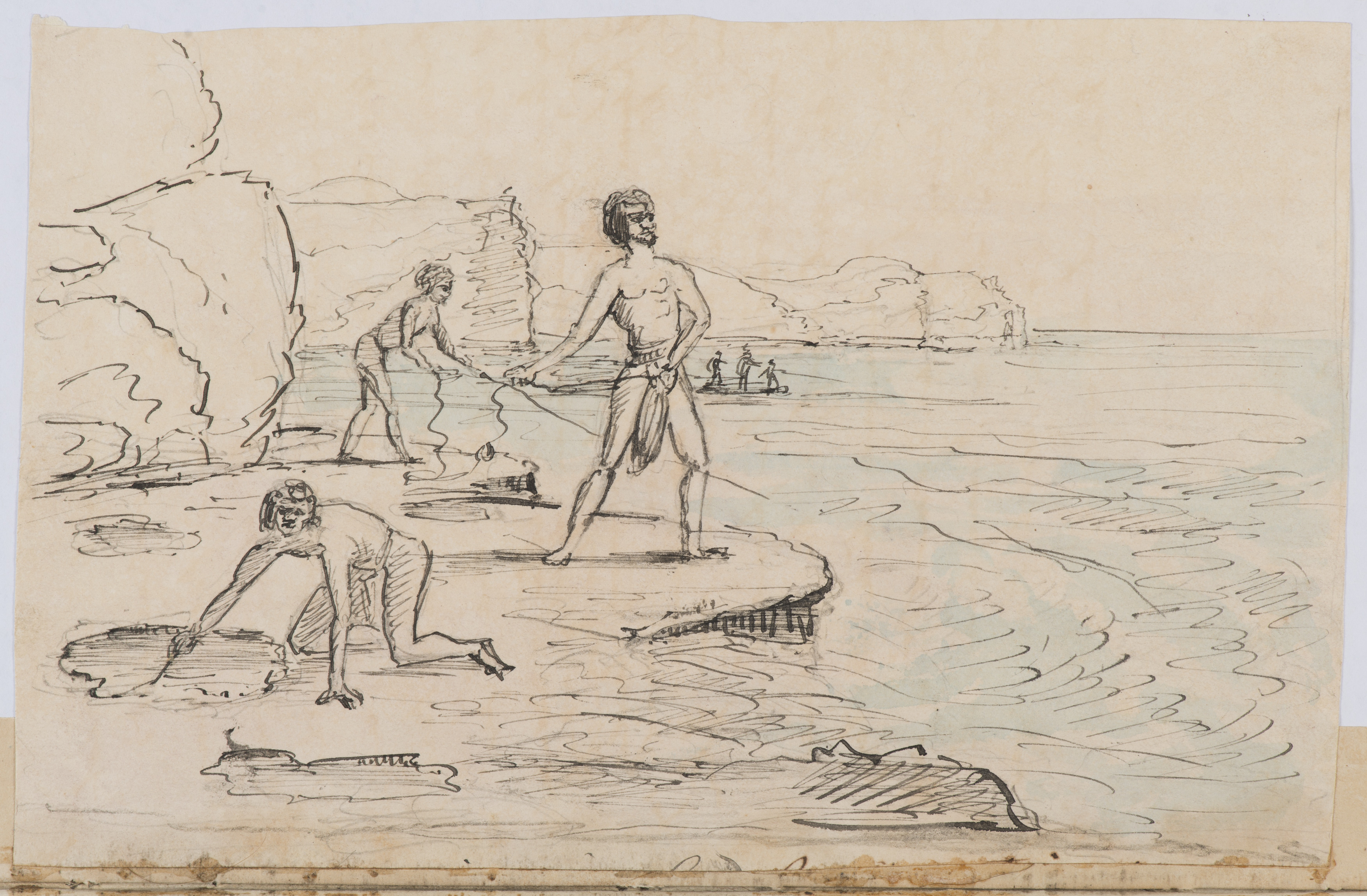
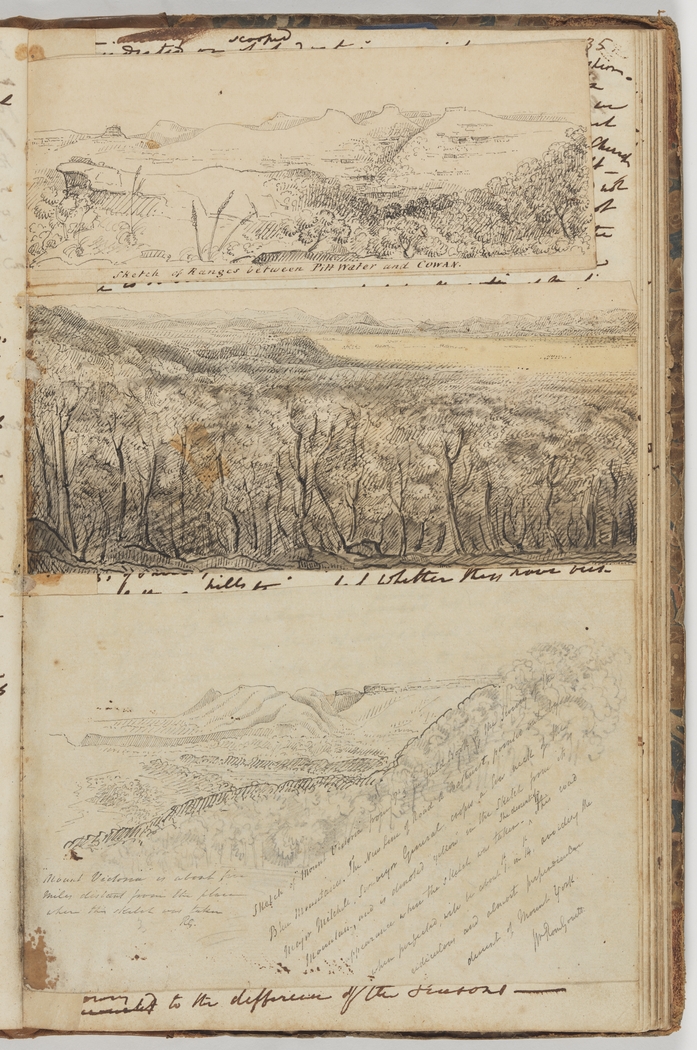
Major Mitchell, Surveyor General of New South Wales, also made a sketch of this area around a decade prior to Mr. Govett's visit:
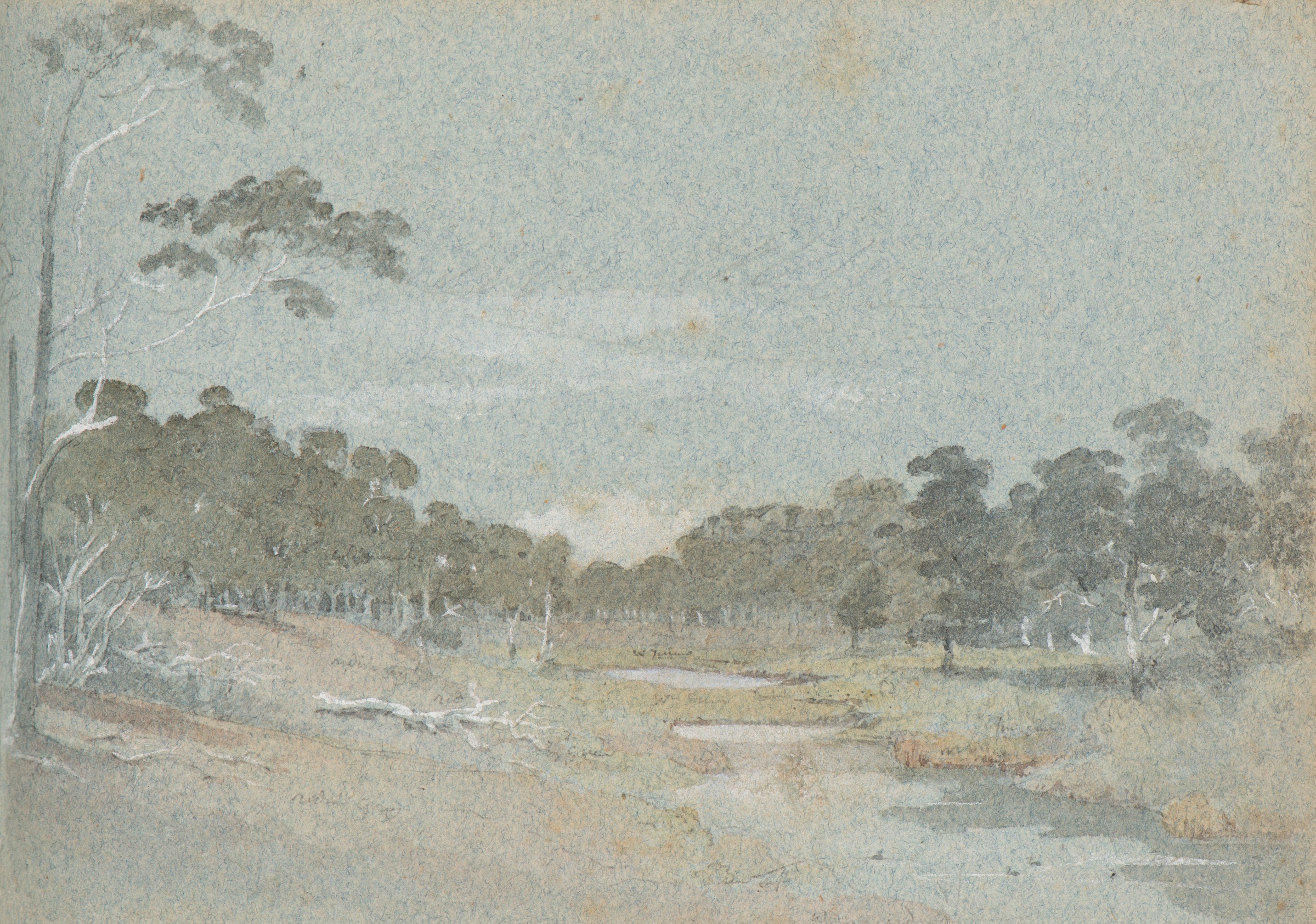
Sir Thomas Mitchell sketchbook - Careel Bay 1828 (flat area leading north towards; where present day Careel Creek is) - Item c03082_0024_m, courtesy State Library of NSW
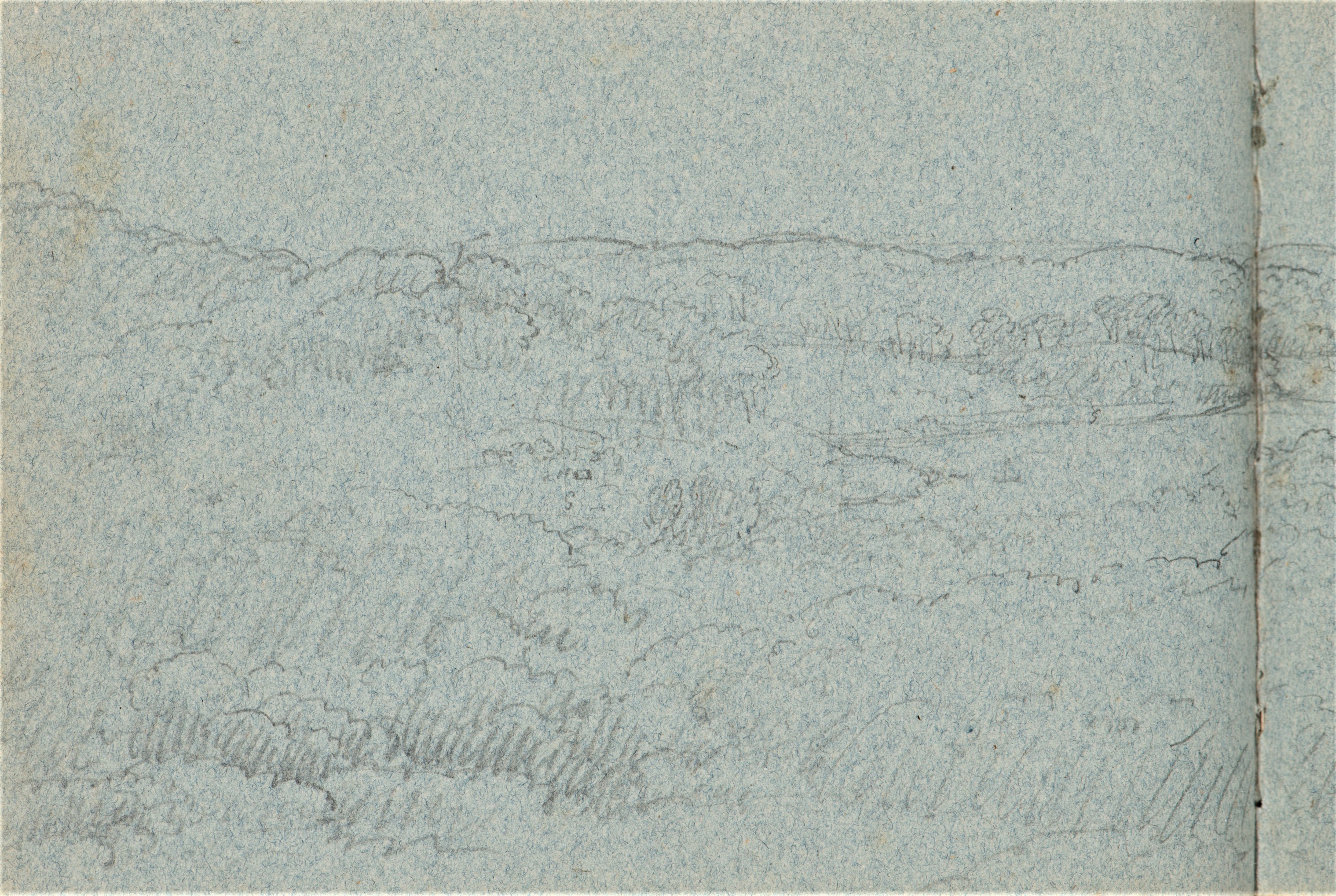
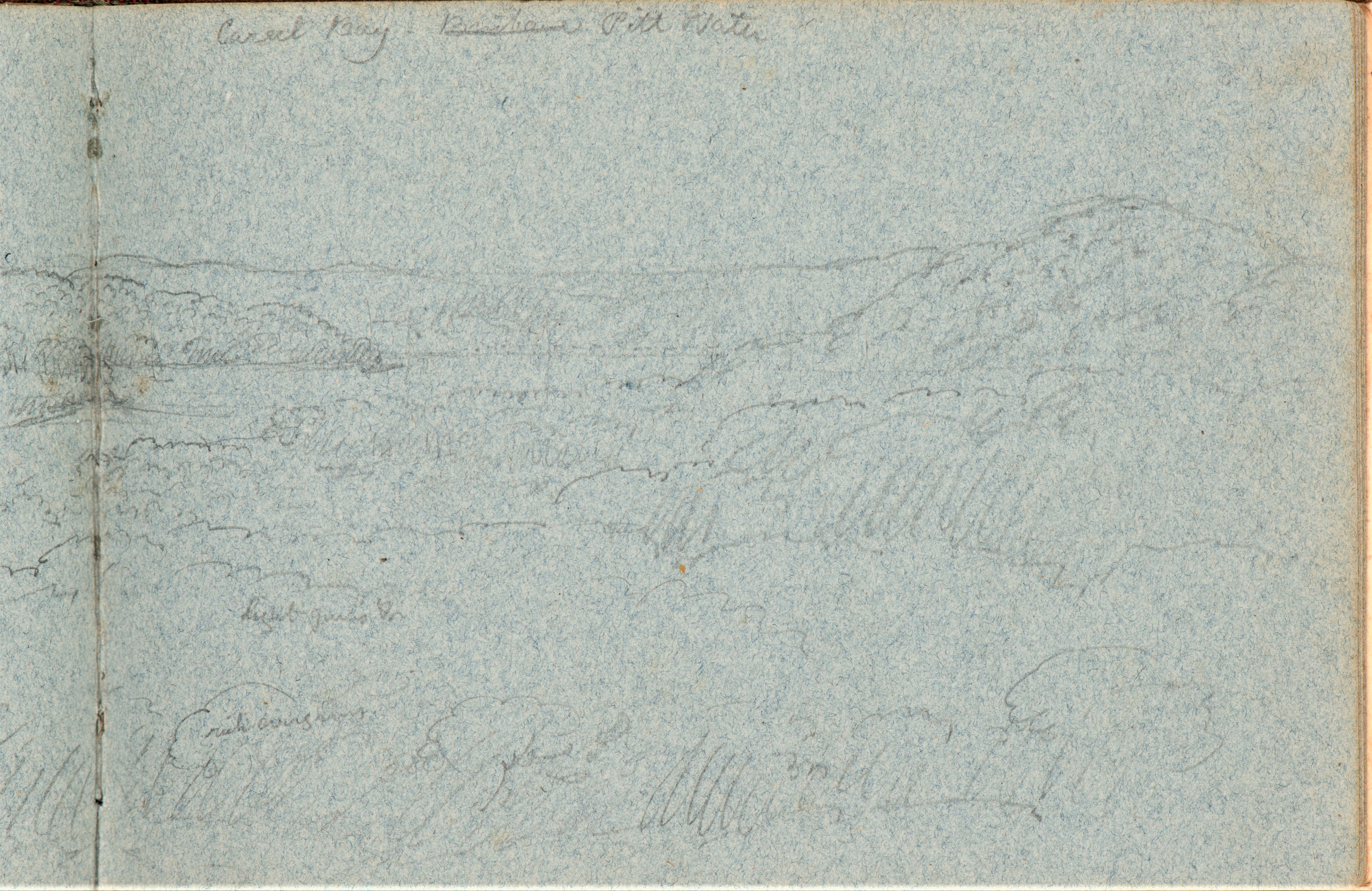
Careel Bay, by Sir Thomas Mitchell, 1828 Field and Sketchbook, Items c03082_0015_m and c03082_0016_m, courtesy State Library of NSW
Conrad Martens
We have been favoured with the sight of a miniature likeness of Mr. Marten's, the celebrated landscape painter; the likeness is excellent, and the colouring is very clear. Mr. Samuel Elyard is the artist, who, we understand, intends to open a studio. We have no doubt that this proficiency in his art will ensure him success.
We recommend no one in love with his legs to swim to Parramatta,, as an enormous shark was observed in the river, by the Steamer the other day.
One of the aborigines of the Capita Tribe, died a short time since from the meazles. Domestic and Miscellaneous Intelligence. (1836, January 29). The Australian (Sydney, NSW : 1824 - 1848), p. 2. Retrieved from http://nla.gov.au/nla.news-article36853153
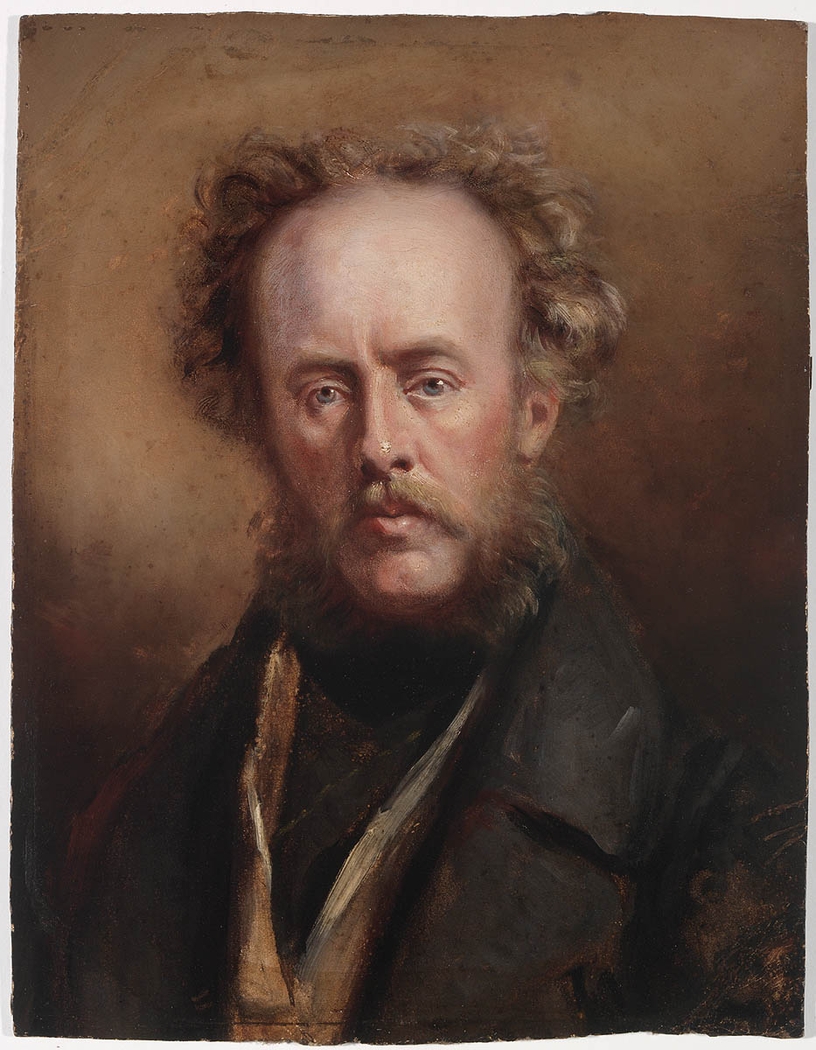
Conrad Martens, ca. 1840 / painted by Maurice Felton - Inscribed in ink on reverse by Myra Felton, the artist's daughter, "Conrad Martens. By Maurice Felton M.D. Property of Myra Felton", Item: a928666h courtesy Mitchell Library, State Library of New South Wales.
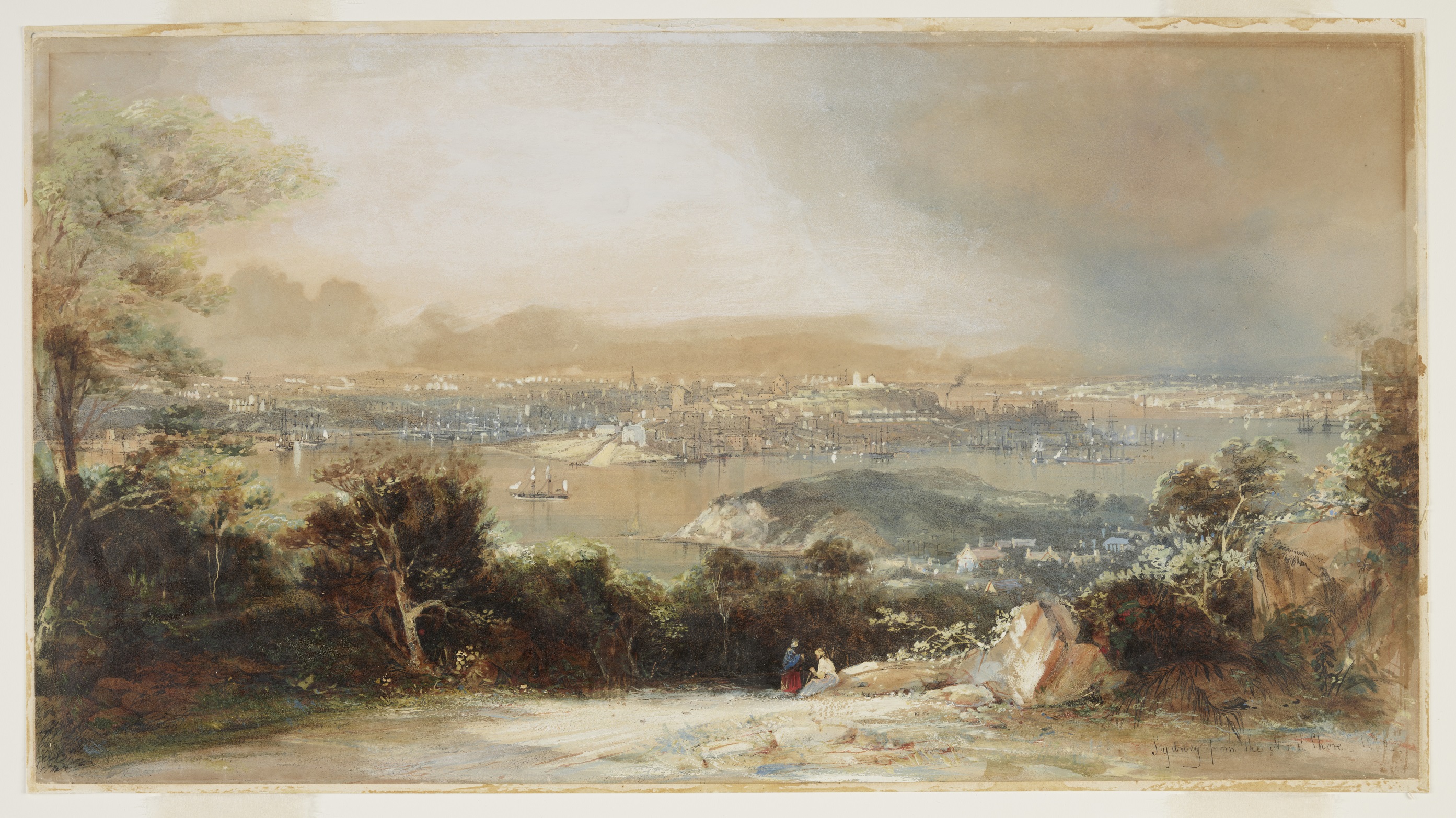
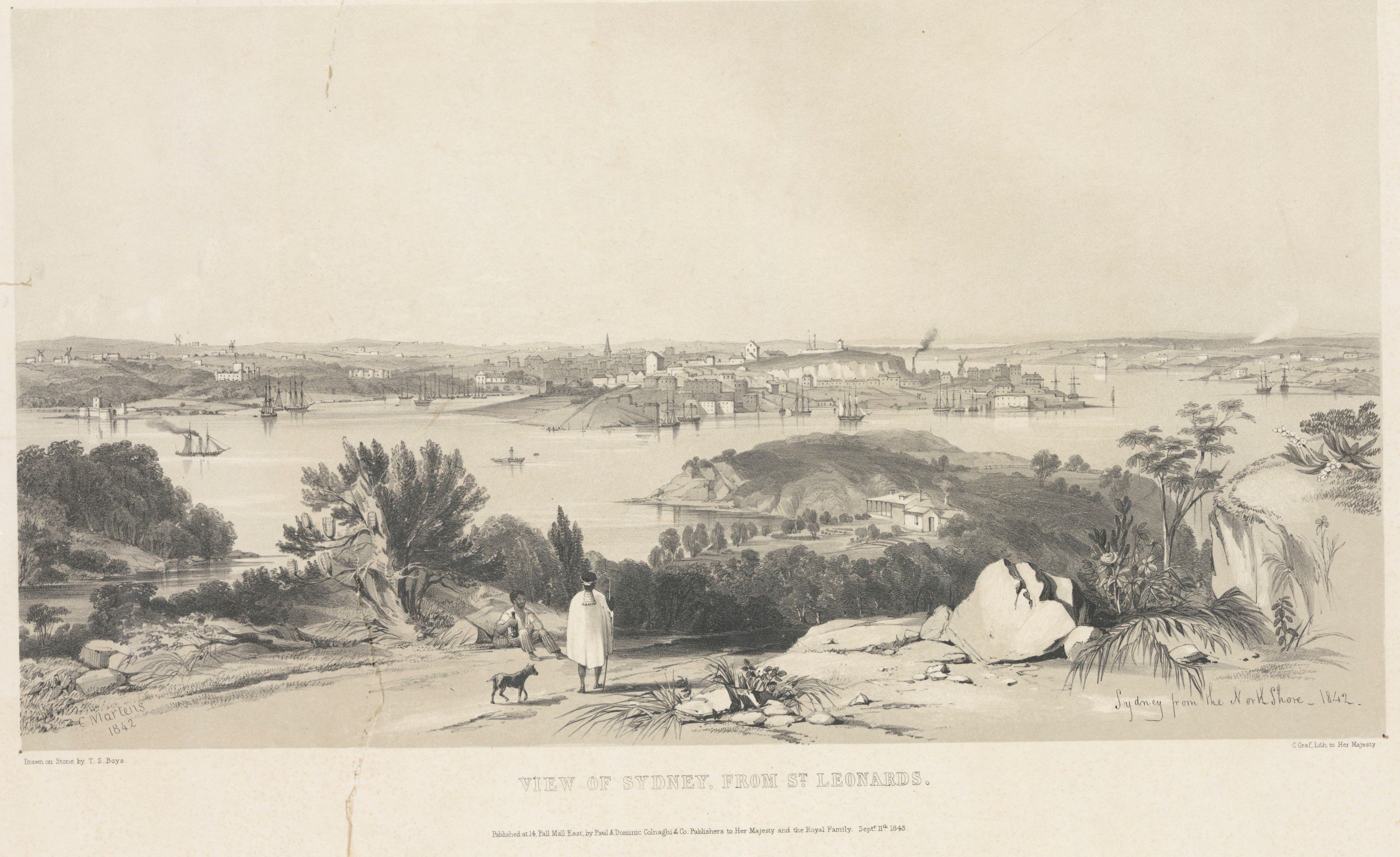
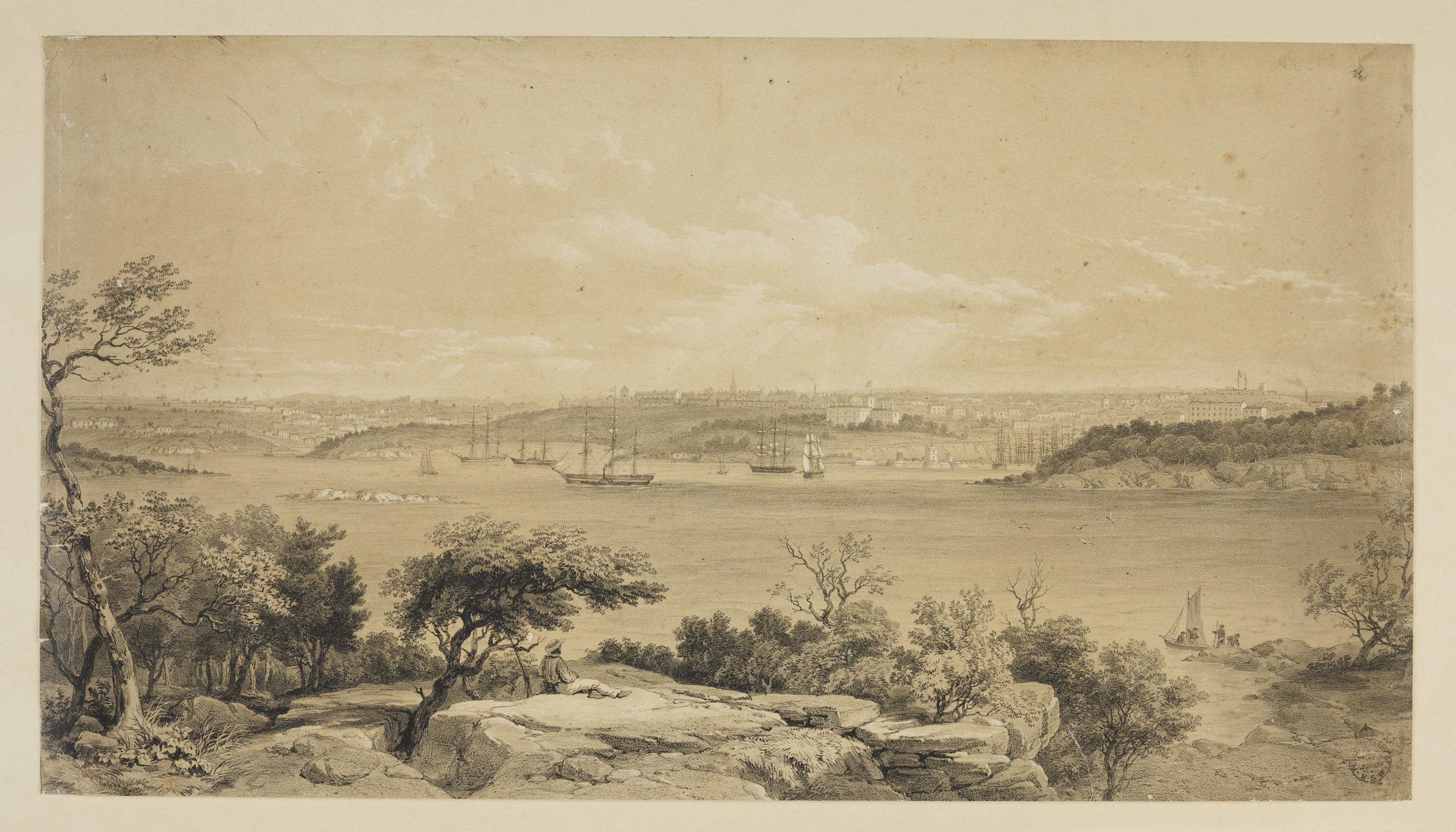
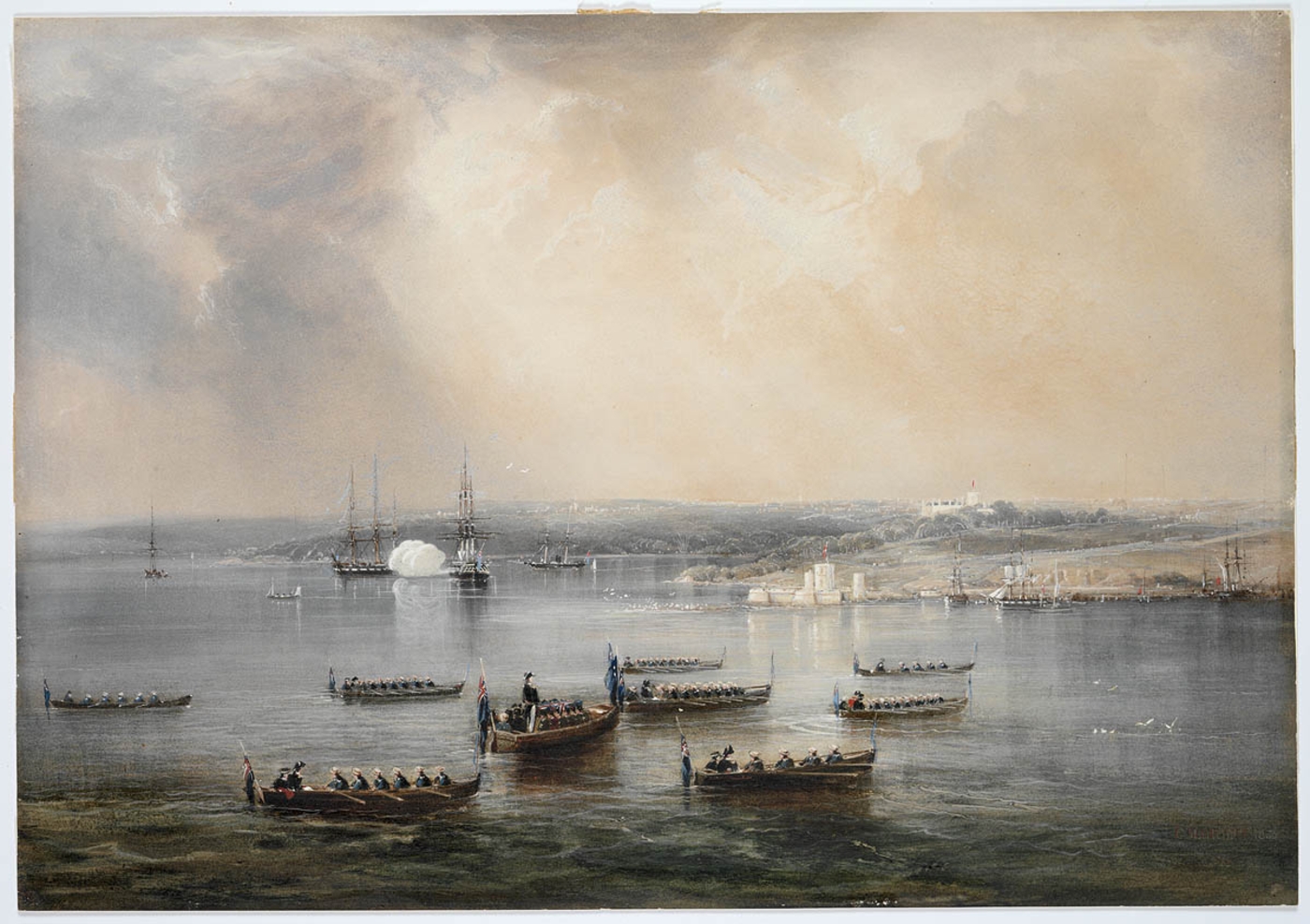
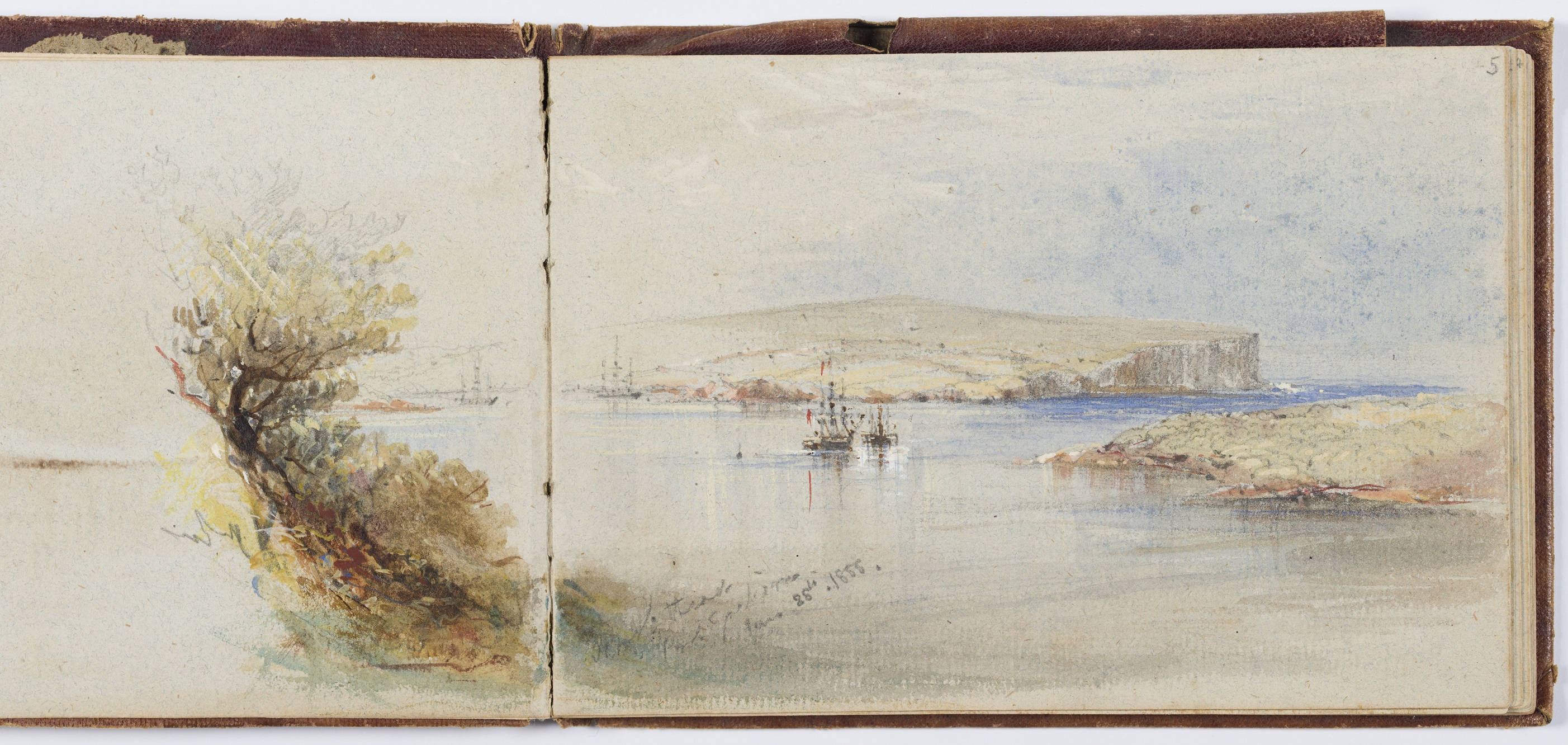
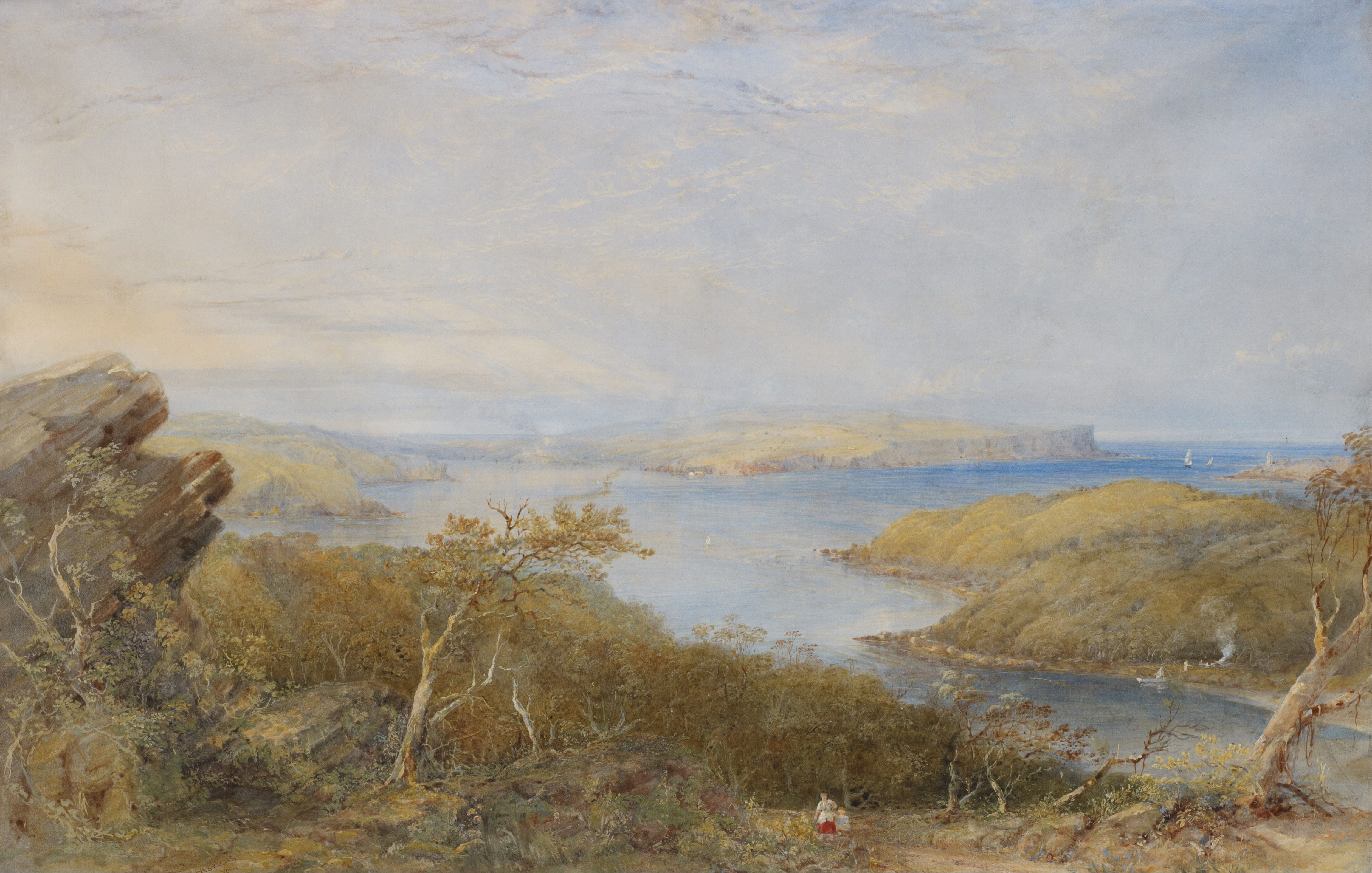
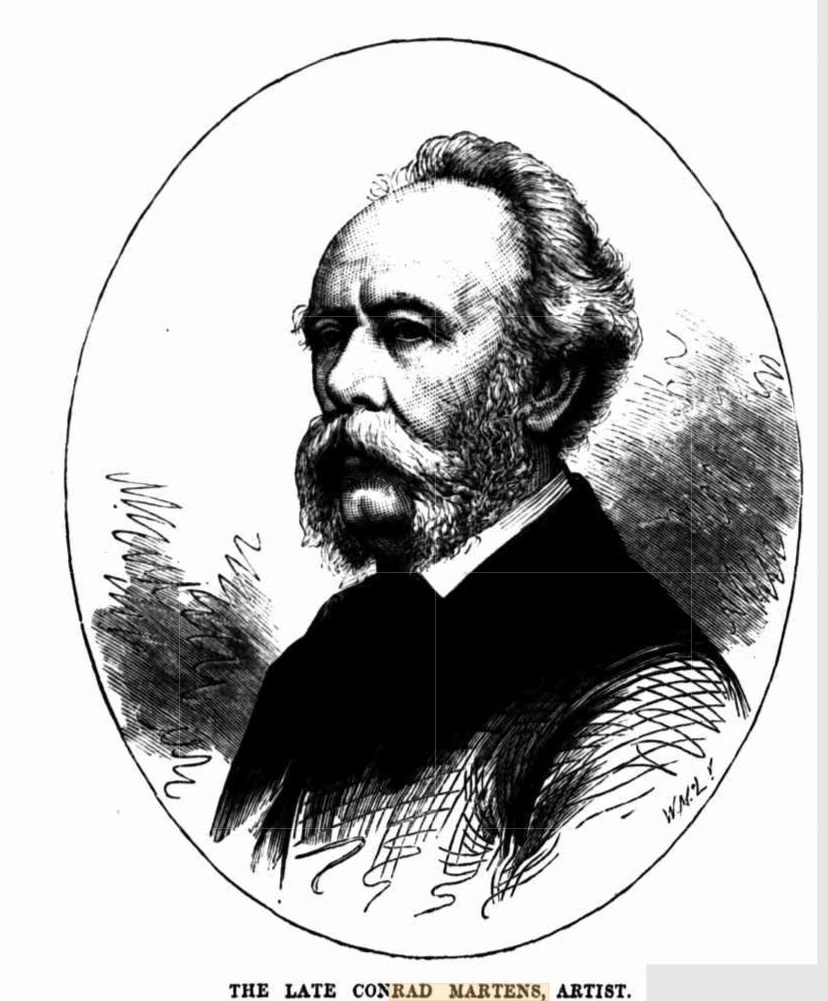
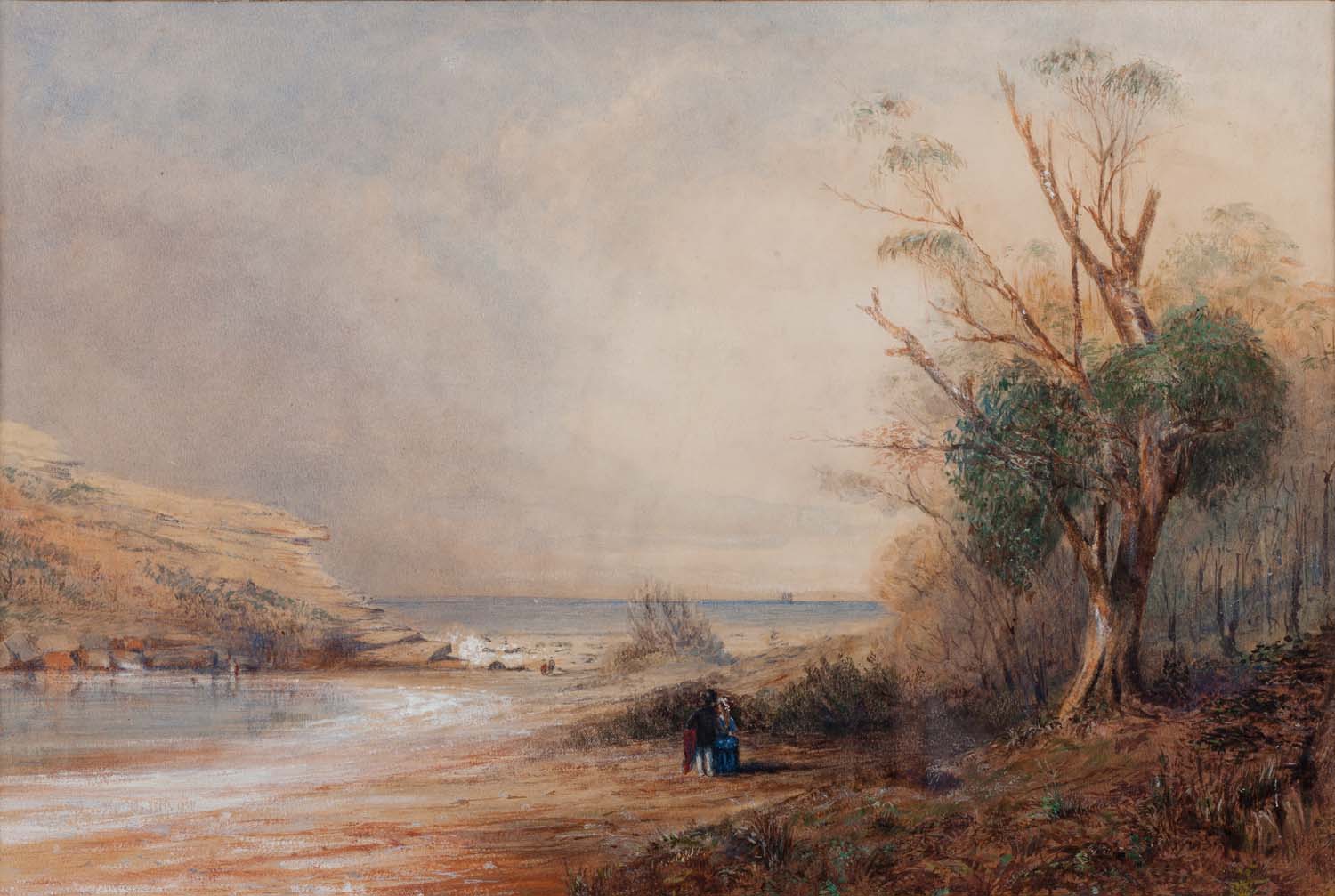
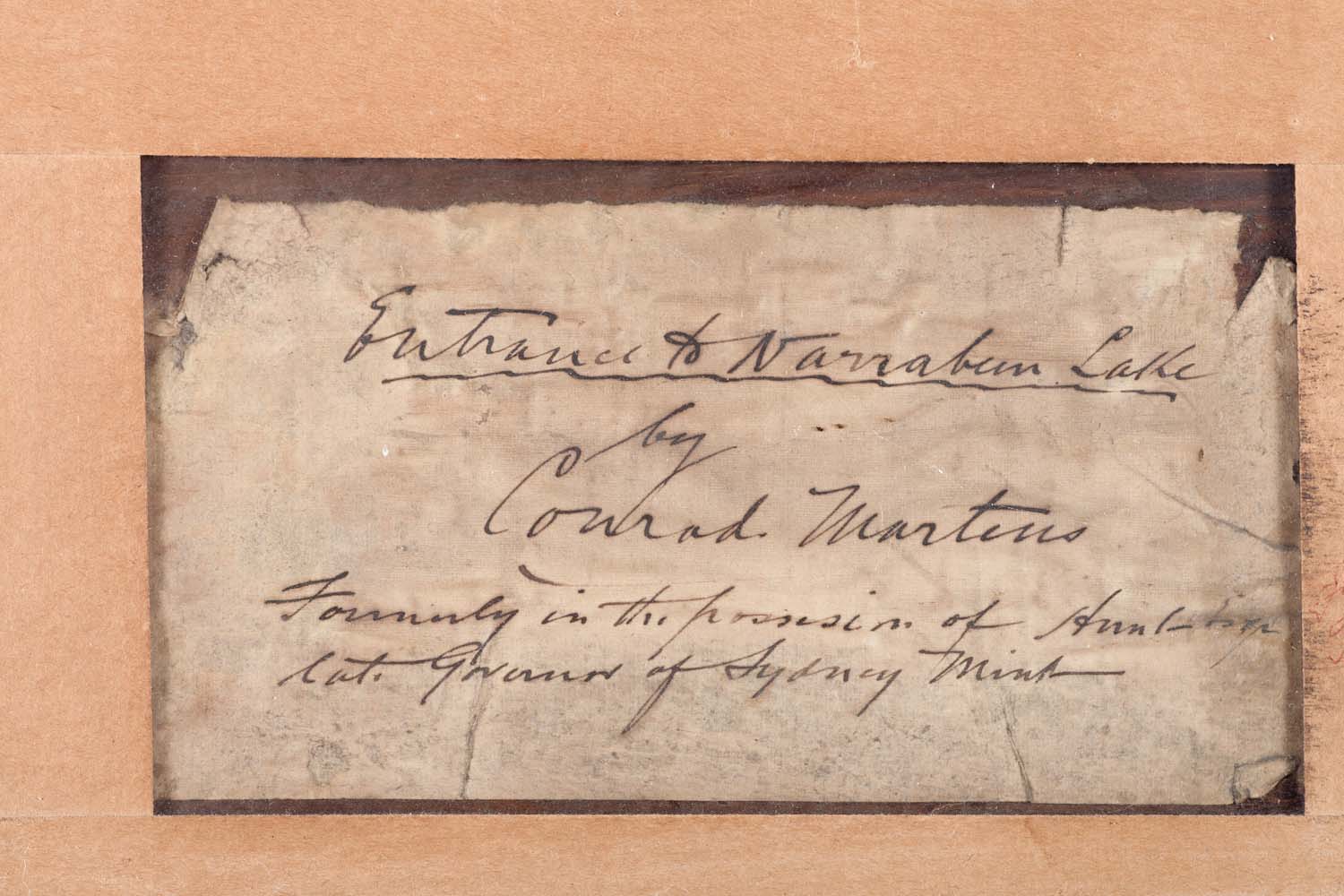
Another colonial artist, William Andrew's works depict Narrabeen and a view of Manly and this view of the road to Pittwater, possibly also towards the Manly end of the peninsula. His sketch and watercolour of Narrabeen shows a similar low tide crossing place:
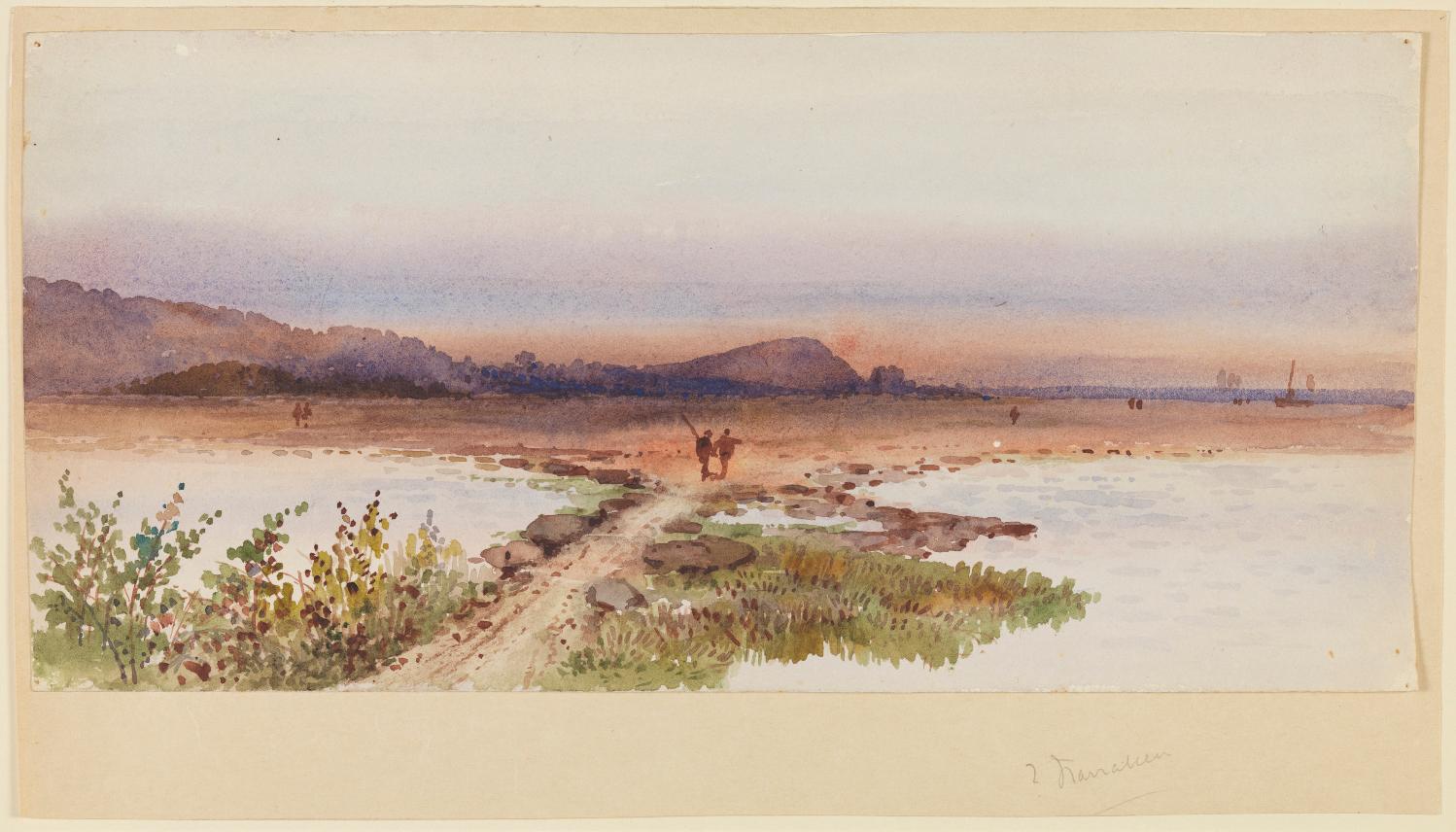
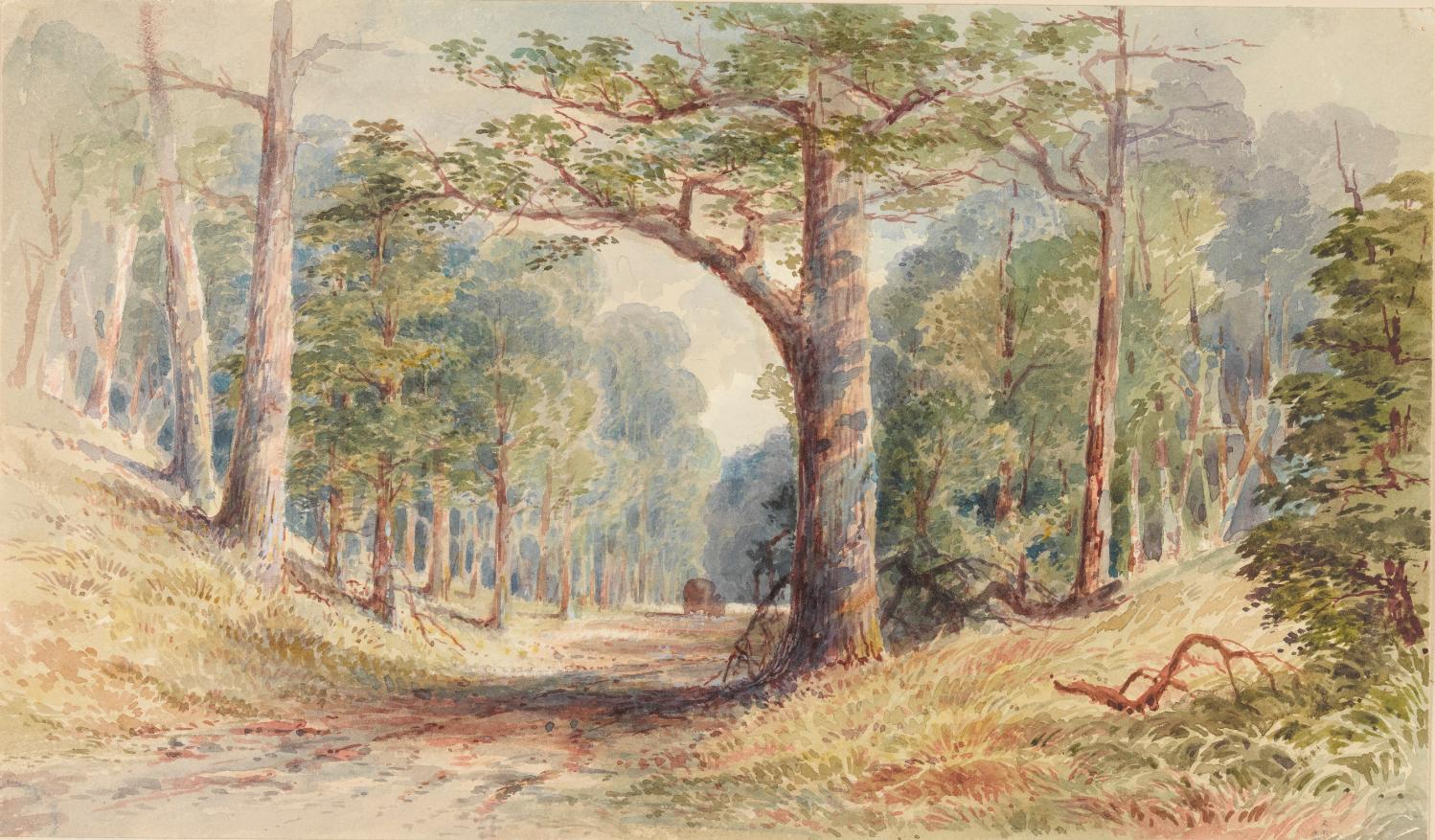
William Thomas Andrews, 1840-1887, was the only son of William Andrews Snr. who was born at Windsor NSW on August 15th 1811, son of William Andrews. He married Jane, daughter of John, and had one son and at least one daughter, Susannah Jane Gannon, nee Andrews. From 1840 to July 1841, William Andrews was the owner of the schooner Alligator. By 1852, he was in partnership with the publican James Merriman running shipping services between Sydney and New Zealand. In 1859, William Andrews, shipwright, was living at 103 Princes Street, Millers Point. His partner James Merriman was publican of the nearby Whalers Arms. In 1867, William Andrews, shipowner, is recorded at 44 Phillip Street but by 1869 he was back at Millers Point at 92 Princes Street. William Andrews was elected Alderman for Bourke Ward, May 6 1869 until November 30 1871. Their portraits were painted in 1861 by James Anderson.
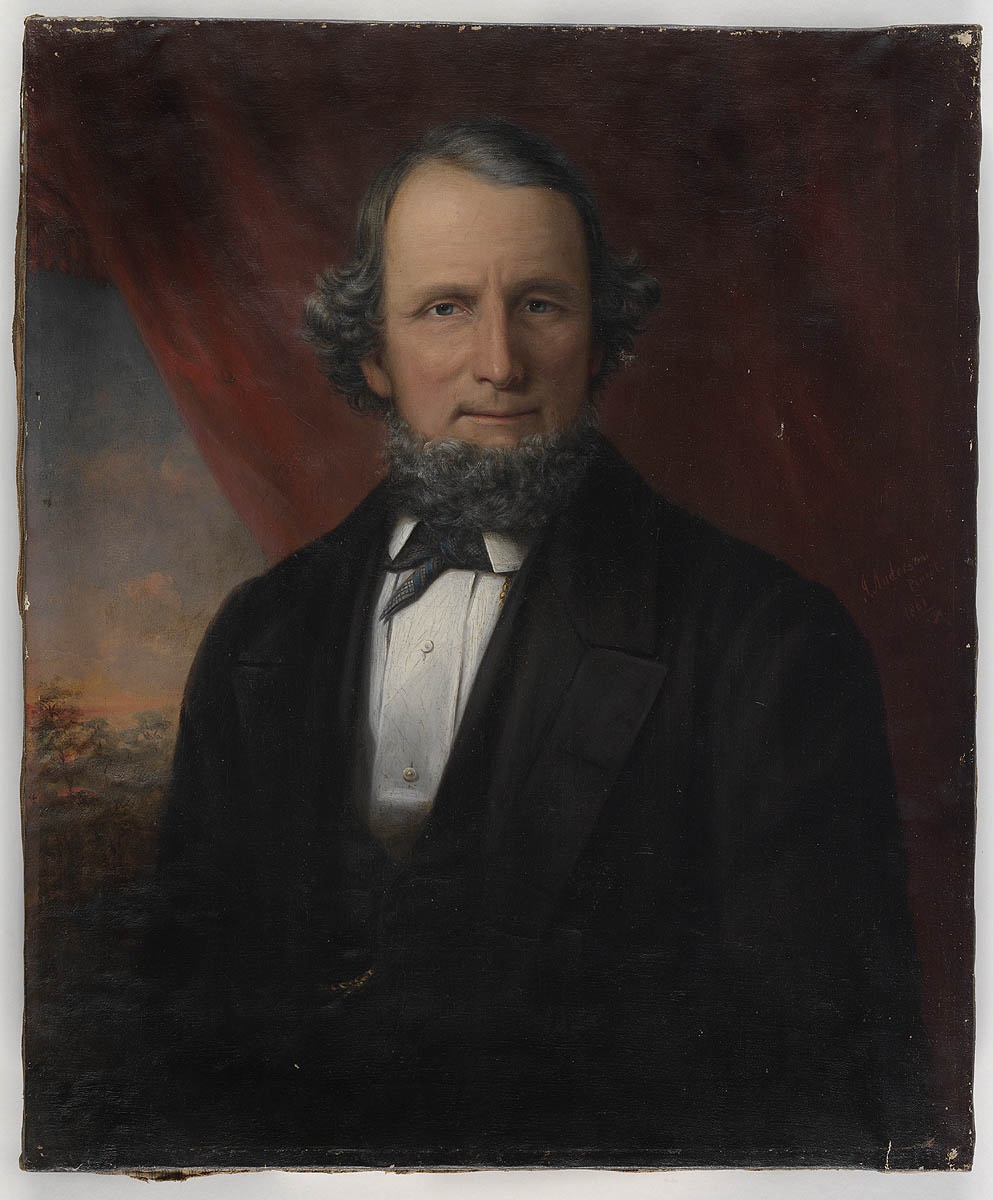
William Andrews, 1861 / painted by James Anderson, Item: SLNSW_FL3317769 courtesy Mitchell Library, State Library of New South Wales
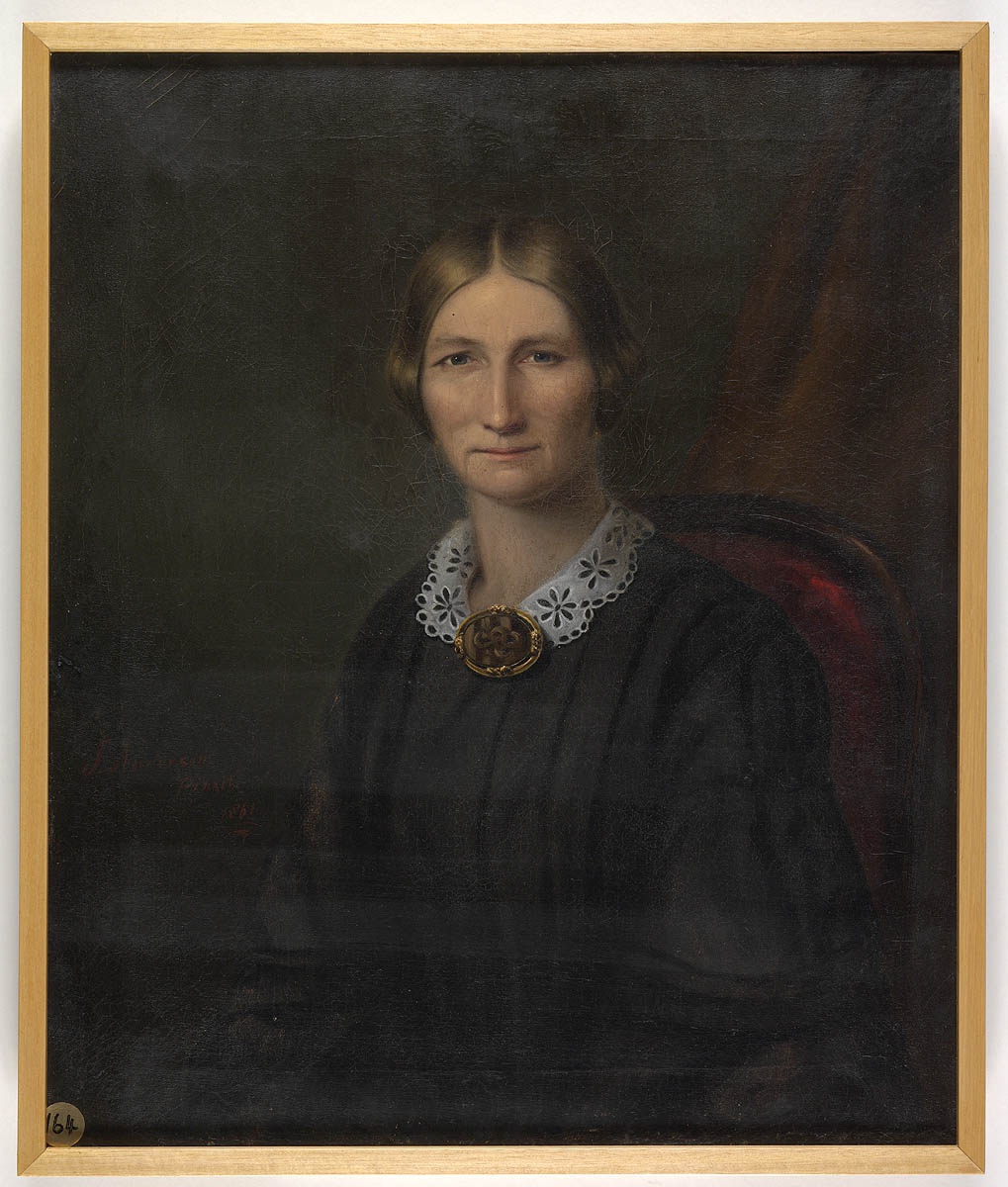
Mrs William Andrews, 1861 / painted by James Anderson Item: SLNSW_FL3311844 courtesy Mitchell Library, State Library of New South Wales
William Andrews died on April 6th 1873. His wife Jane died on 29 April 1864, aged 45. The family was buried at St Jude’s Church of England at Randwick.
His only son William Thomas Andrews (1840-1887) also became a shipowner and an acclaimed artist. As William Andrews junior, William began painting professionally around 1860; by 1868 he was listed in Sands Sydney Directory as an artist of 44 Yurong Street.
William Moore states that he received several landscape commissions when Lord Rosebery visited Australia in 1883-84, which Rosebery took back to England, but mostly he worked as an amateur, earning his living as a draughtsman in the NSW Colonial Architect’s Office.
In 1865 he married:
MARRIAGES. ANDREWS—RECH—On the 19th April, at St. Phillip's Church, by the Very Rev. Dean Cowper, William Thomas, only son of Mr. William Andrews, of Phillip-street, to Elizabeth, only daughter of Mr. Jacob Rech, of Kent-street, both natives of this city. Family Notices (1865, April 22). Empire (Sydney, NSW : 1850 - 1875), p. 1. Retrieved from http://nla.gov.au/nla.news-article60569883
NSW BDM's lists births for five children, one daughter and four sons:
ANDREWS JANE P E 2649/1867 WILLIAM ELIZABETH BALMAIN
ANDREWS WILLIAM 4561/1871 WILLIAM T ELIZABETH PADDINGTON
ANDREWS PHILIP C 2505/1872 WILLIAM ELIZABETH SYDNEY
ANDREWS HENRY JACOB 1034/1875 WILLIAM ELIZABETH SYDNEY
ANDREWS ALBERT CHRISTIAN 2850/1879 WILLIAM ELIZABETH SYDNEY
ANDREWS.-On the 24th December, at her residence, Balmain, Mrs. W. Andrews, of a daughter. Family Notices (1867, January 9). Empire (Sydney, NSW : 1850 - 1875), p. 1. Retrieved from http://nla.gov.au/nla.news-article60604564
On the 22nd instant, at her residence, No. 17, Linsley-terrace, Lower Fort-street, the wife of Mr. WILLIAM ANDREWS, Jun., of a son. Family Notices (1872, September 28). The Sydney Morning Herald (NSW : 1842 - 1954), p. 1. Retrieved from http://nla.gov.au/nla.news-article13264127
By the mid 1870s they lived at Double Bay.
In 1870 Andrews contributed an oil painting, 'Ship in Distress', to Sydney’s Intercolonial Exhibition; it was highly commended. Three other works entered in the same class (oil paintings by amateurs) were 'Raft Scene – Sunset', 'Red Riding Hood' and 'Cattle Piece'. Two years later his oils and watercolours attracted favourable attention when shown with the NSW Academy of Art: 'Of the paintings in oils’, stated the Empire on March 5 1872, 'Mr W. Andrews junior’s “Tranquility” must, one should think, bear away the palm’. A coastal landscape at sunrise with a dismantled hulk in the foreground, it was in fact awarded the medal for best exhibit by a local amateur. Andrews also showed 'Nearing the Heads' and 'The Old Hull at Cuthbert’s', the latter a moonlight scene. They received certificates of merit.
In April he showed more oil paintings, including 'A War Scene', in an exhibition held at the Pitt Street Congregational Sabbath School. The Agricultural Society’s annual exhibition in May included his 'Early Morn' and 'The Last Gleam', the latter winning a first prize. 'Morning' and 'Evening' ('two fine [oil] pictures of sea-coast scenes’) were 'decided favourites’ when exhibited with the NSW Academy of Art in 1873. 'Stranded', shown in the following year’s exhibition, would have won a silver medal, it was reported, 'but for what was thought to be a sameness in the picture to others exhibited by that talented gentleman during the last two years’. Another oil coastal scene was shown with the Academy in 1874, and Andrews donated at least two paintings as prizes in the Academy’s annual art union. A decade later, his watercolour of Darling Harbour in the 1884 Royal Art Society Exhibition was described in Once a Month as 'one of the finest works contributed’.
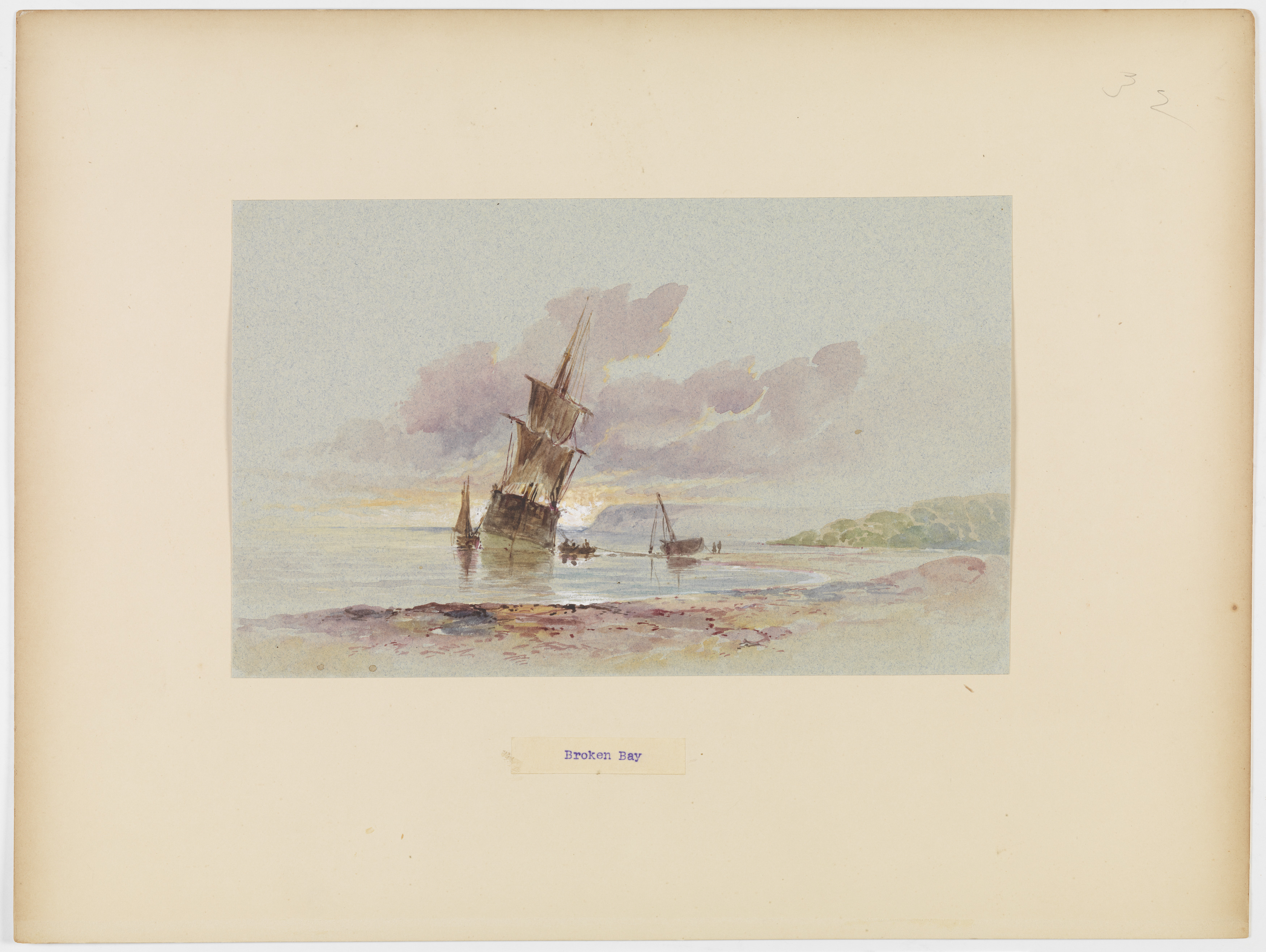
f.32 Broken Bay [a view including a sailing ship and boats] Watercolour on blue paper, 15.8 × 25.8 cm (6 1/4" × 10 1/8") Item: c12837_0044_c, courtesy State Library of NSW
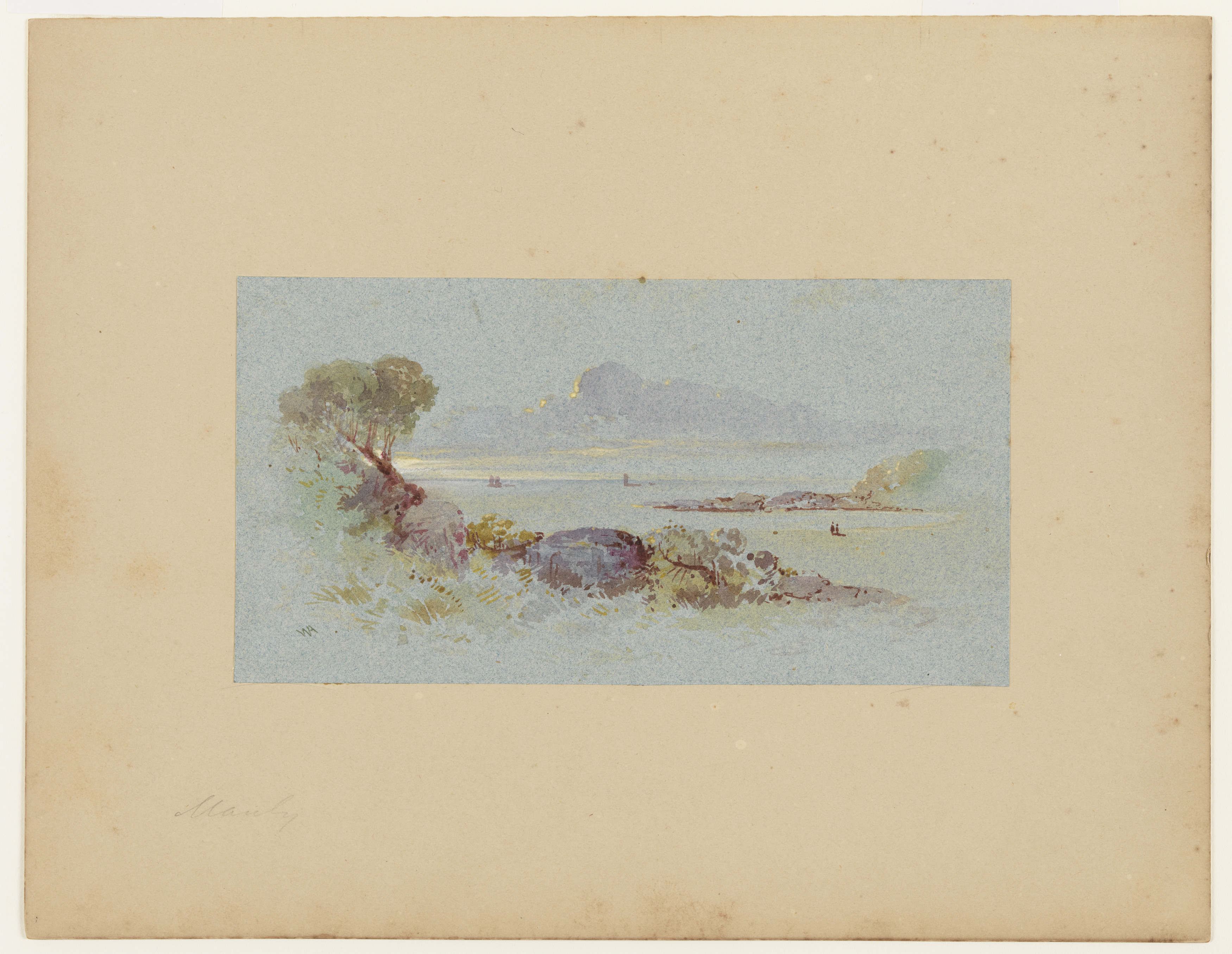
f.33 Manly [a view of the beach] Watercolour. 19.3 × 34.4 cm (7 5/8" × 13 1/2") Item: c068600001, courtesy State Library of NSW
He passed away at the very young age of 47:
Deaths. ANDREWS. — January 26, 1887, at his residence, 312, Victoria-street, Darlinghurst, William Thomas Andrews, late of the Colonial Architect's Office, formerly ship owner, of this city, in his 47th year. Thy will be done. Family Notices (1887, January 27). The Sydney Morning Herald (NSW : 1842 - 1954), p. 1. Retrieved from http://nla.gov.au/nla.news-article28353828
THE FRIENDS of the late Mr. WILLIAM THOMAS ANDREWS are informed his Funeral will leave his late residence, 312, Victoria-street, Darlinghurst, THIS (Friday) MORNING, at quarter to 9 o'clock, to family vault, Randwick, CHARLES KINSELA, 110, Oxford-street, near Crown-street.
THE FRIENDS of Mr. JACOB RECH, Sen., are informed the funeral of his late beloved SON-IN-LAW, Mr. William Thomas Andrews, will leave his late residence, 312, Victoria-st., Darlinghurst, THIS (Friday) MORNING, at quarter to 9 o'clock, to family vault. Randwick. CHARLES KINSELA, 116, Oxford-street, near Crown-street.
THE FRIENDS of Messrs. PHILIP and JACOB RECH are informed the funeral of their late beloved BROTHER-IN-LAW, Mr. William Thomas Andrews, will leave his late residence, 312, Victoria-st., Darlinghurst, THIS (Friday) MORNING, at quarter to 9 o'clock, to family vault, Randwick. CHARLES KINSELA, 116, Oxford-st., nr. Crown-st.
THE FRIENDS of Mr. JOSEPH NAPOLEON GANNON are informed that the Funeral of his late beloved BROTHER-IN-LAW Mr. William Thomas Andrews, will leave his late residence. 312, Victoria-street, Darlinghurst, THIS (Friday) MORNING, at a quarter to 9 o'clock, to family vault, Randwick. CHARLES KINSELA, 116, Oxford-street.
THE FRIENDS of WILLIAM ANDREWS, Junr., are informed the funeral of his late beloved FATHER, Mr. William Andrews, will leave his late residence, 312, Victoria -street, Darlinghurst, THIS (Friday) MORNING, at a quarter to 9 o'clock, to the family vault, Randwick. Family Notices (1887, January 28). The Sydney Morning Herald (NSW : 1842 - 1954), p. 12. Retrieved from http://nla.gov.au/nla.news-article13625728
In Memoriam.
ANDREWS.—In sad remembrance of William Thomas Andrews, late shipowner and artist, a native of Sydney, who died January 26th, 1887. Inserted by his loving wife and children. Family Notices (1888, January 26). The Sydney Morning Herald (NSW : 1842 - 1954), p. 1. Retrieved from http://nla.gov.au/nla.news-article13682166
Harold Brees
For the way Narrabeen to Newport looked around 1880 we turn to Harold Brees and the sketches and then watercolours he was commissioned to draw to sell the New Marine Township of Newport.
We have received from Messrs. Mills, Pile, and Gilchrist, (who have published it for the proprietors) an interesting pamphlet descriptive and illustrative of the beauties and attractions of Newport, Pittwater, and the celebrated Hawkesbury lakes. The work consists of about eight pages of letter-press and nine carefully lithographed drawings, depicting the more important scenes and places of interest in the locality.
The description is capably written, and the illustrations, lithographed by Messrs. S. T. Leigh and Co., from water colour drawing- by Mr. H. Brees, are very creditably executed, and give excellent ideas of the places represented. Appended is a plan and local sketch of the new marine township of Newport, and altogether the publication is one which will commend itself highly to all interested in one of the most picturesque spots on the New South Welsh coast. NEW'S OF THE DAY. (1880, August 26). The Sydney Morning Herald (NSW : 1842 - 1954), p. 5. Retrieved from http://nla.gov.au/nla.news-article13466890
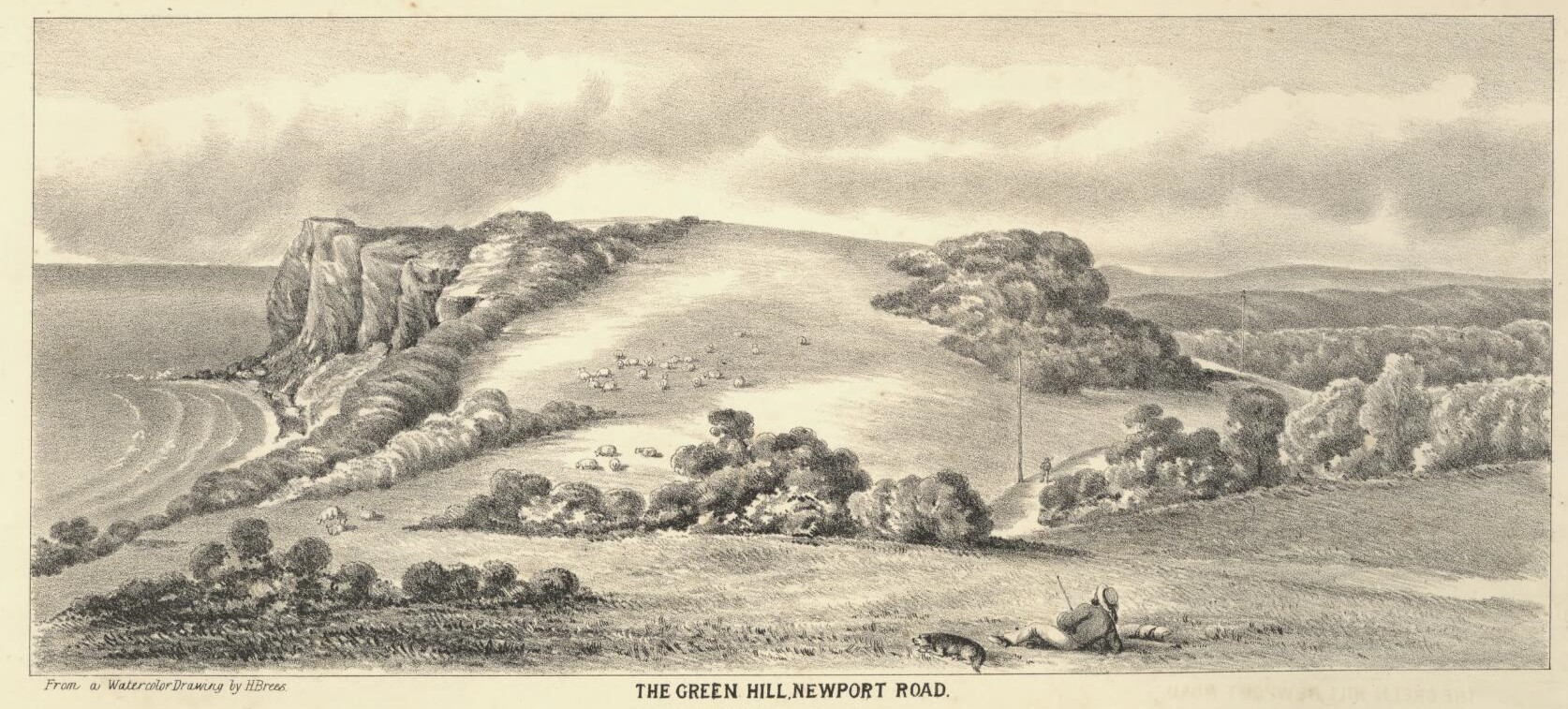
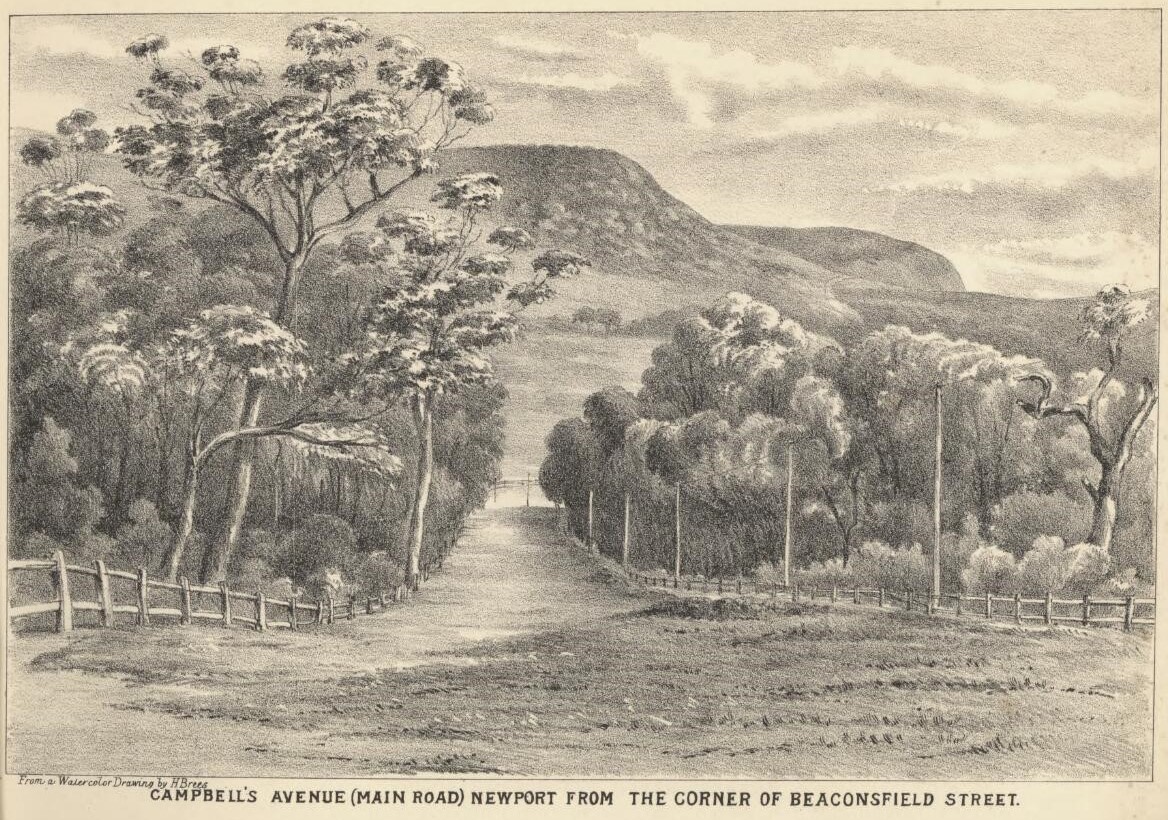
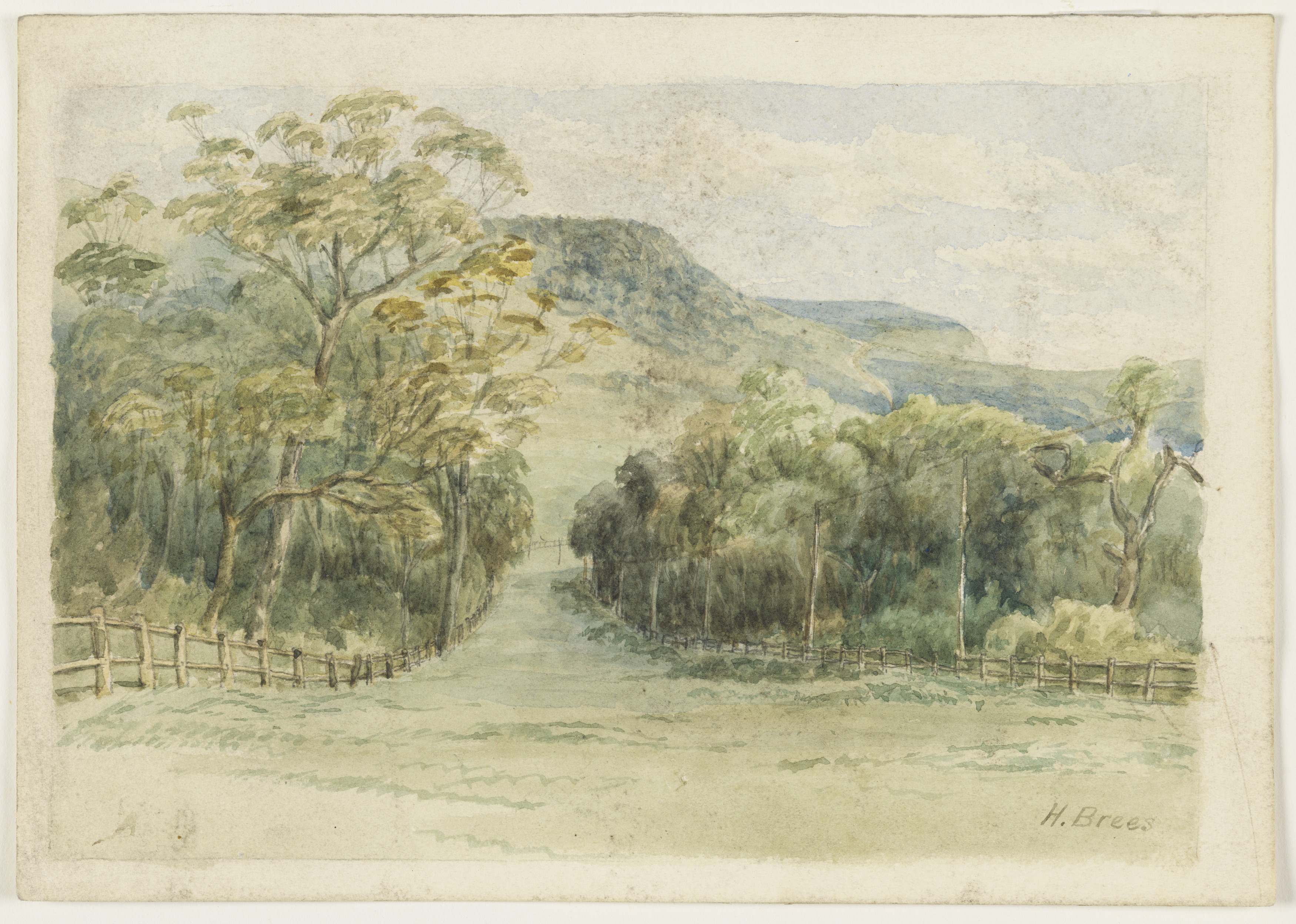
Campbell Avenue (main view) Newport, from the corner of Beaconsfield Street, from album Pittwater scenes, 1880 / Harold Brees courtesy State Library of NSW - note the Telegraph wires. The drawings appear to be the originals for six of the lithographs illustrating 'The Pittwater and Hawkesbury Lakes album'. [Sydney] : Mills, Pile & Gilchrist, 1880. (Lithographed by S.T. Leigh & Co.)
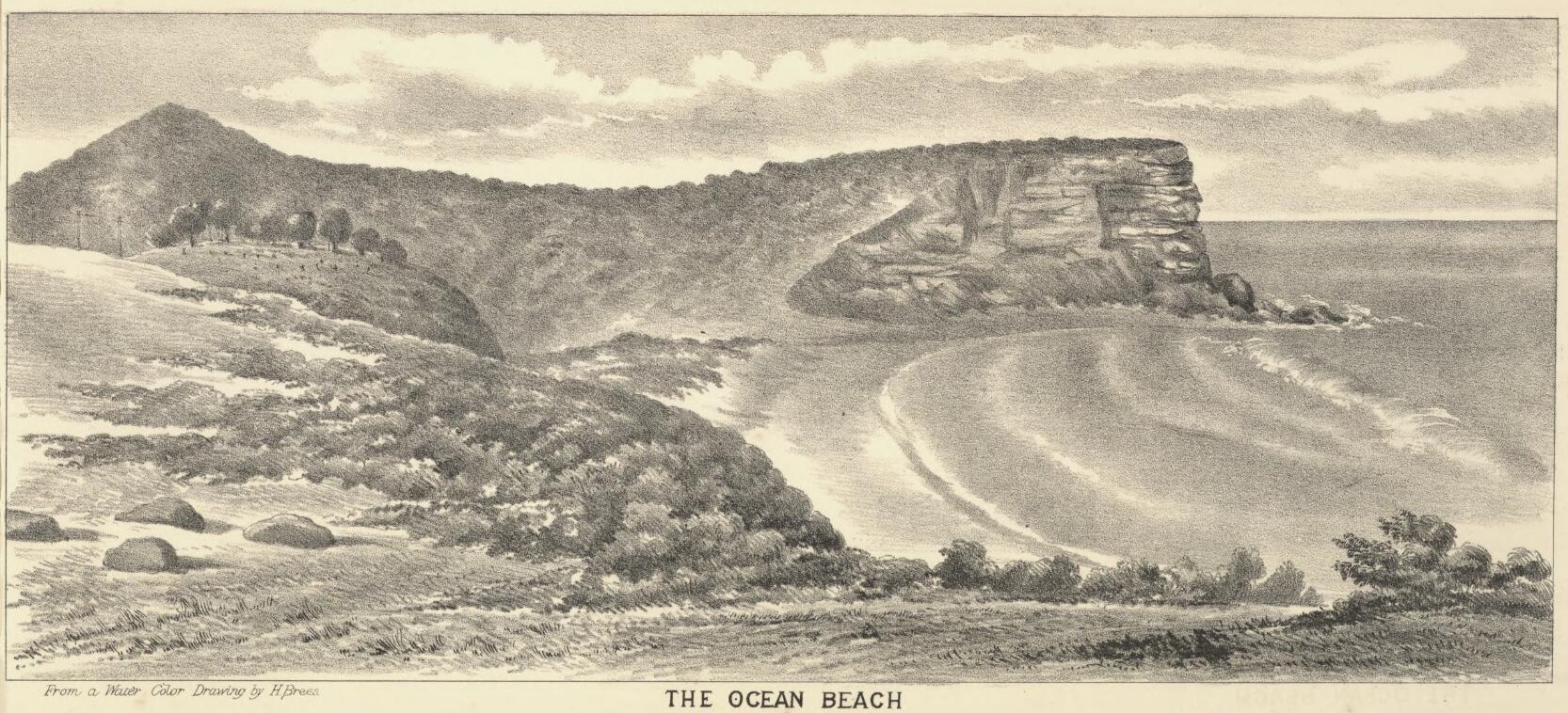
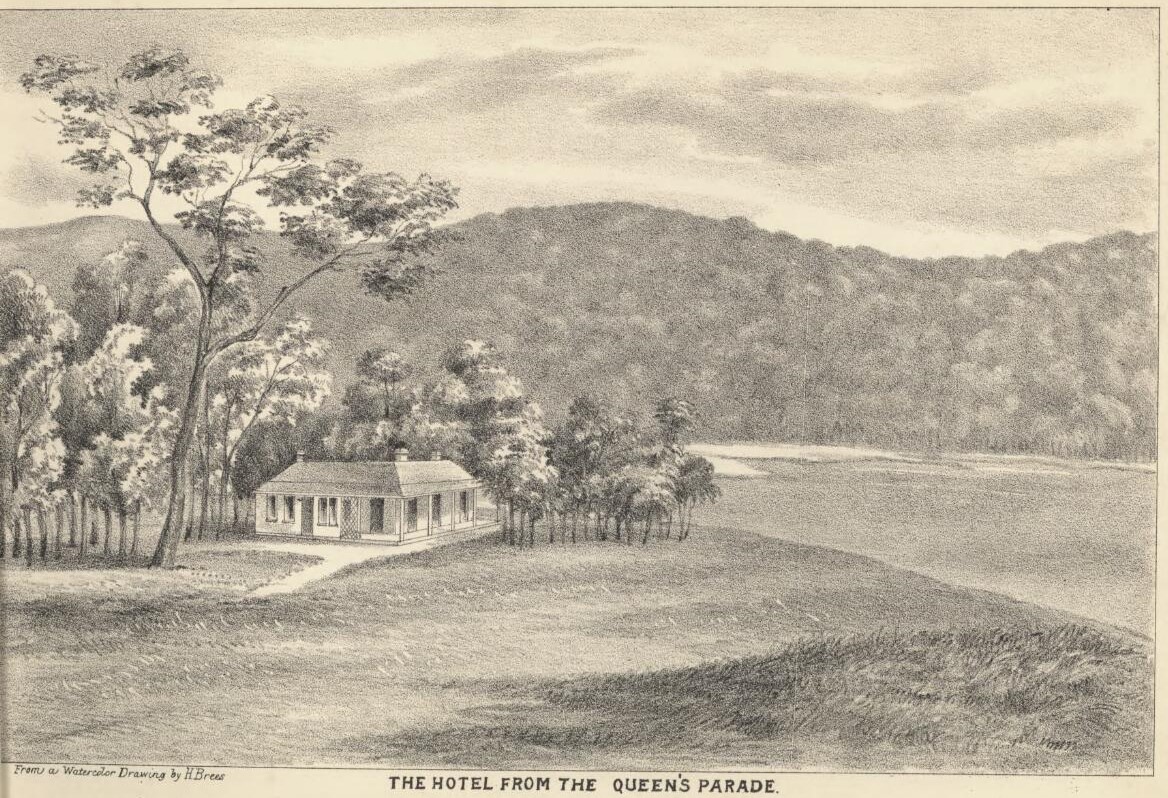
THE HOTEL FROM THE QUEENS PARADE
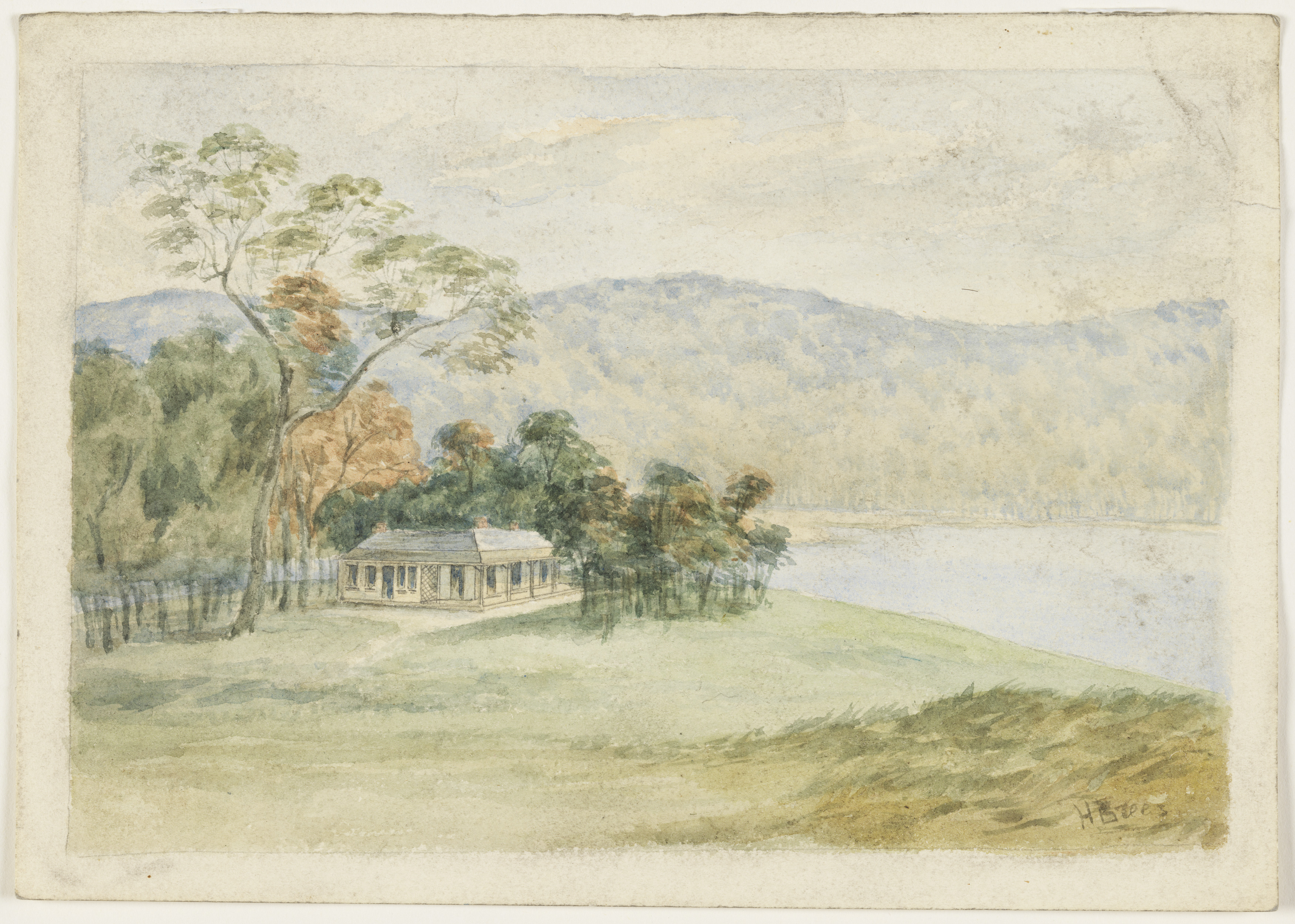
Pittwater scenes, 1880 / Harold Brees, The hotel [Newport] from the River Parade, Image No.: c13730_0007_c, courtesy State Library of New South Wales.
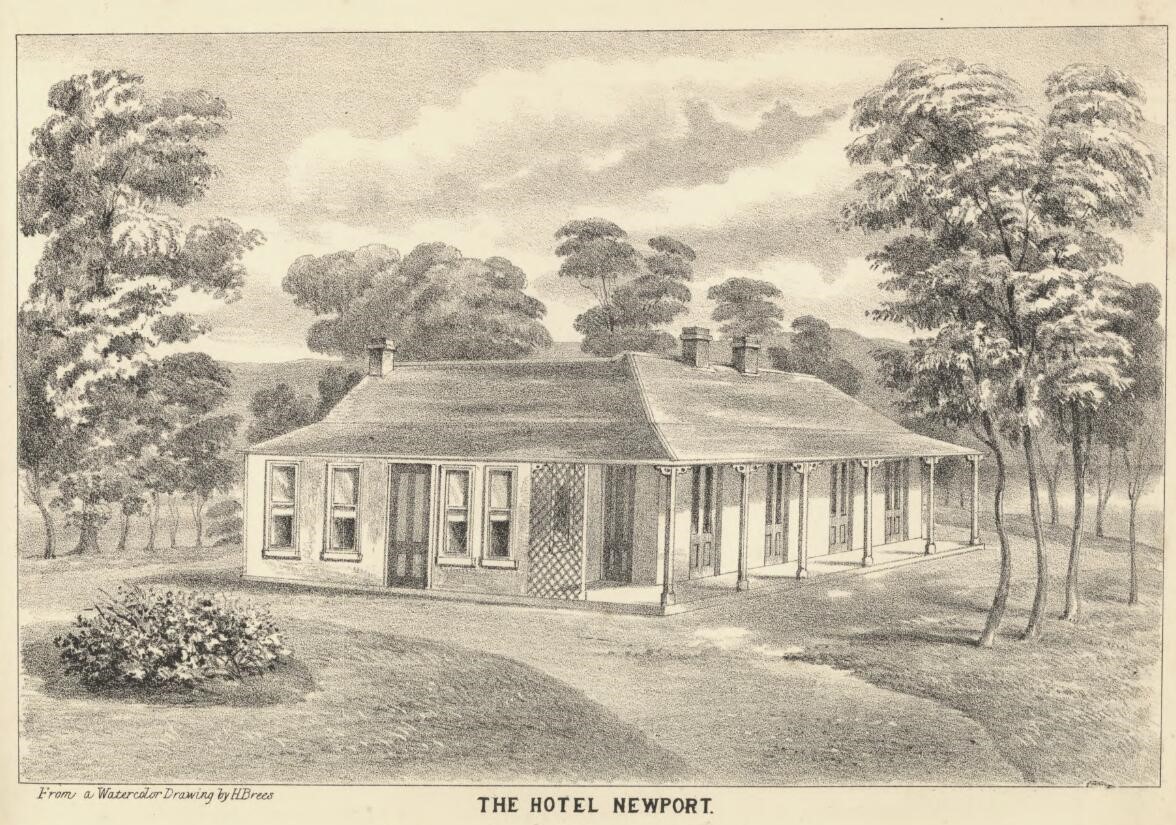
THE HOTEL NEWPORT.
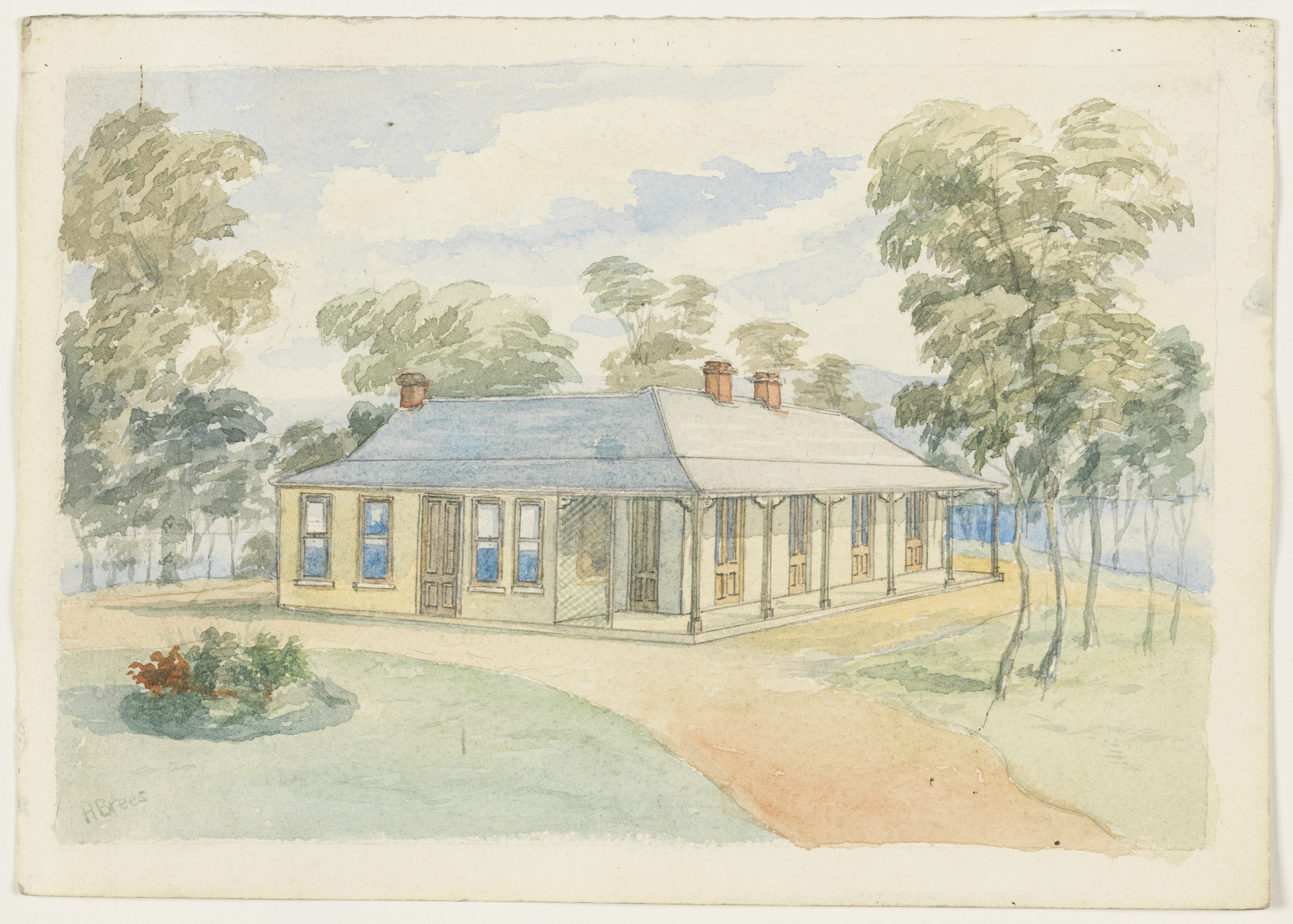
Pittwater scenes, 1880 / Harold Brees, The hotel, Newport, Image No.: c13730_0011_c, courtesy State Library of New South Wales.
PITTWATER, a splendid view of which can be obtained from Newport, is the widest arm of the Hawkesbury, and the one whence the Sydney traffic must come. It is about half a mile wide there, but below it spreads out to a width of two miles. On the eastern shore the country is hilly, but scarcely mountainous although Mount Loftus rises to an altitude of over four hundred feet; but on the western side the hills attain twice that elevation. There are numerous inlets ; some of them extending a long way among the hills, and which are almost strangers to the foot of man, and doubtless abound with wallaby and other marsupials.
SCOTLAND ISLAND is in full view from Newport, and its shores are celebrated for fine fish ; and, across the mountains, Cowan’s Creek, the next arm of the Hawkesbury, above Pittwater. This is a magnificent sheet of water, extending far up almost to the head of Lane Cove, and abounds with sport of many kinds.
MOUNT LOFTUS is the property of Mr. Farrell, of Manly. The view from its highest point is unsurpassed. The whole of the coast, from the Illawarra dittrict to Tuggerah, is spread out in full view—with the numberless promonitories, which look quite small elevations. South Head looks almost at your feet, and the houses of Woollahra, quite diminutive; to the north, Brisbane Water shows itself, and to the west peaks of precipitous mountains mark the course of the lower Hawkesbury.
LORD LOFTUS POINT was evidently in times gone by a favorite camping ground of the Pittwater aboriginals. It presents signs unmistakeable to old bushmen of having been one of the head quarters of some of our predecesssors—probably of a large tribe.
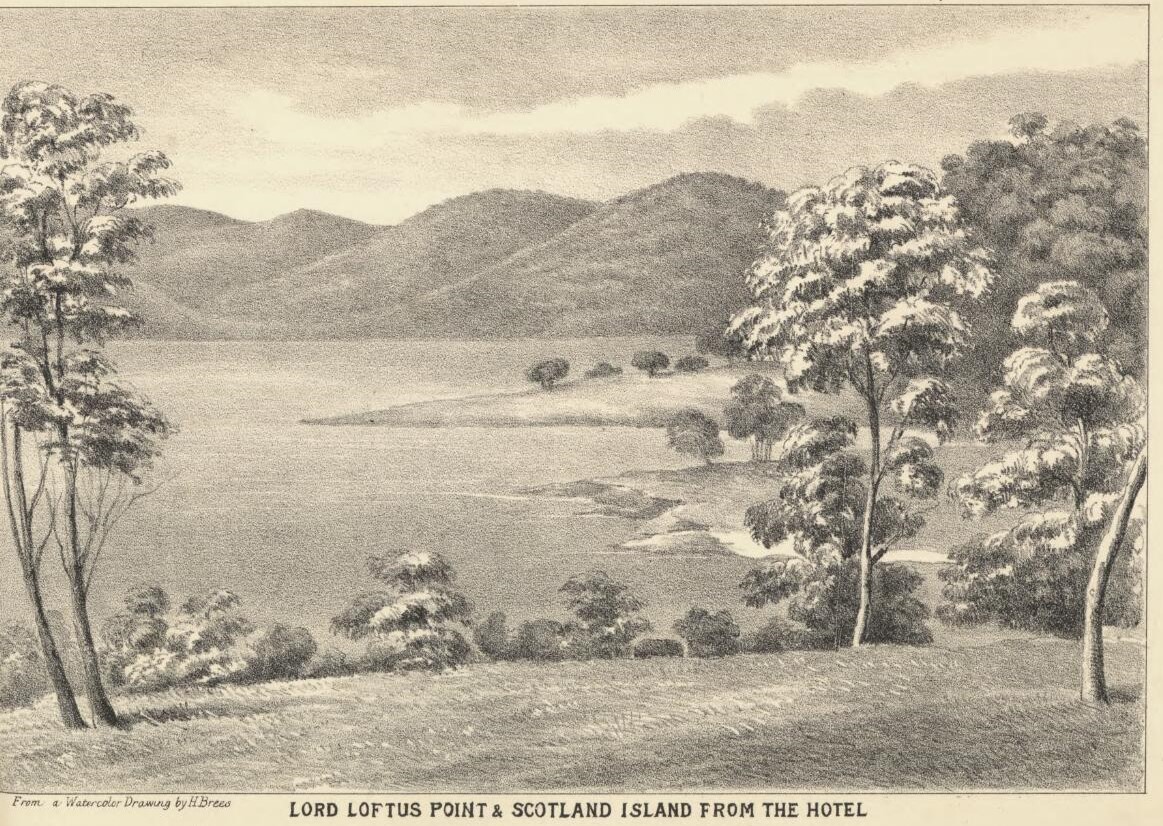
LORD LOFTUS POINT & SCOTLAND ISLAND FROM THE HOTEL
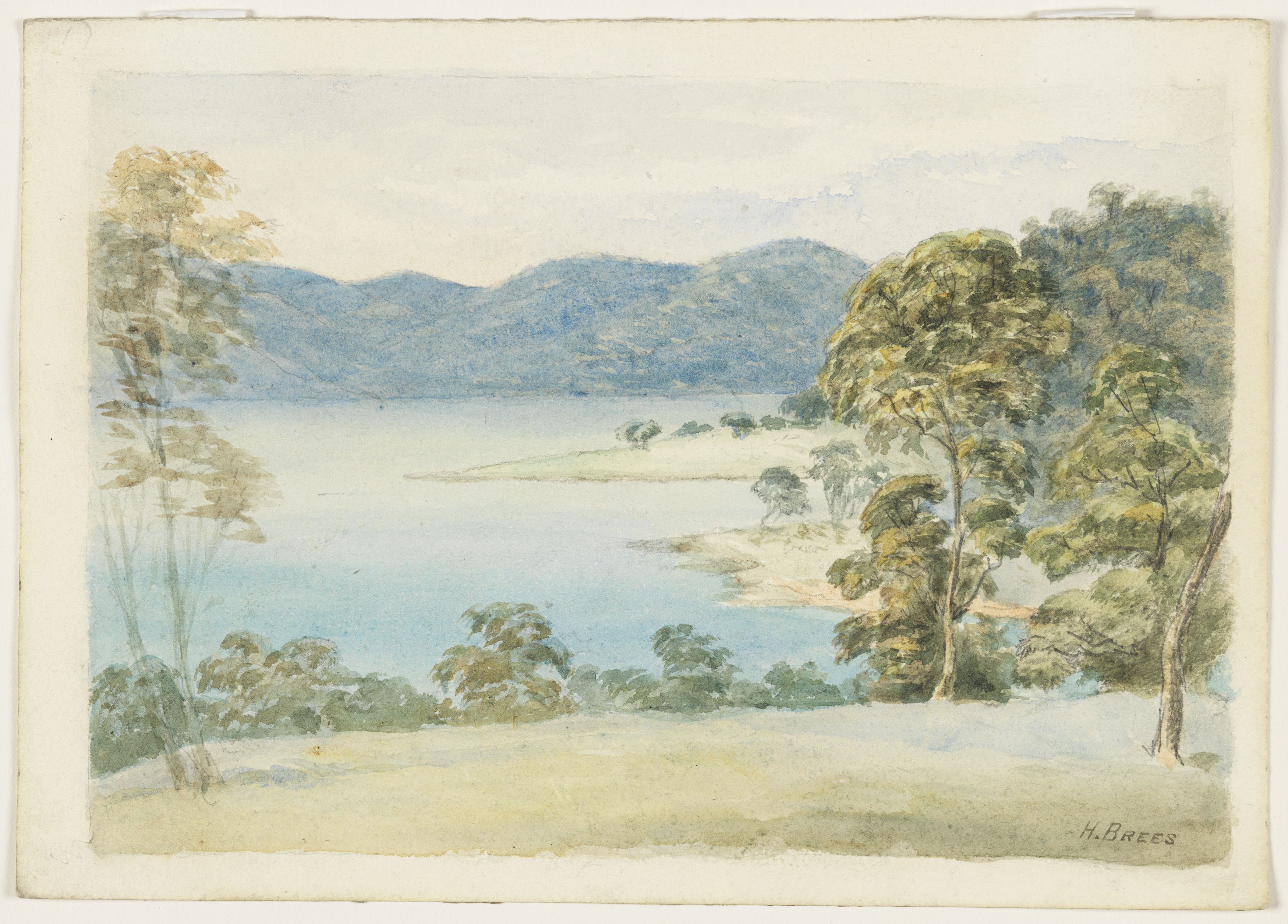
Pittwater scenes, 1880 / Harold Brees, Lord Loftus Point and Scotland Island from the hotel (Newport), Image No.: c13730_0009_c, courtesy State Library of New South Wales.
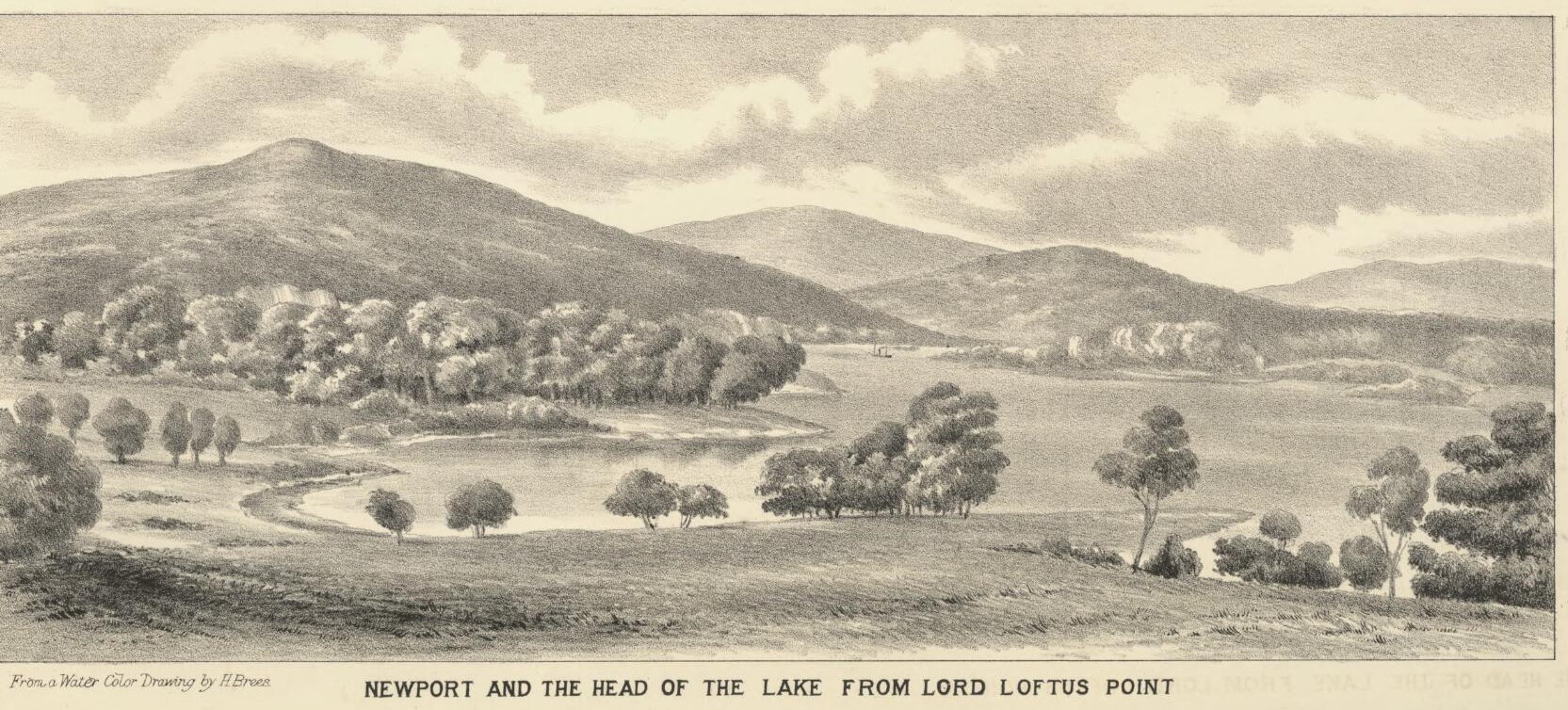
NEWPORT AND THE HEAD OF THE LAKE FROM LORD LOFTUS POINT
Known as a painter, cartoonist, lithographer, architect and surveyor, Harold Brees was born in London, son of the artist and architect Samuel Charles Brees and his wife Ann Taylor, née Jones.
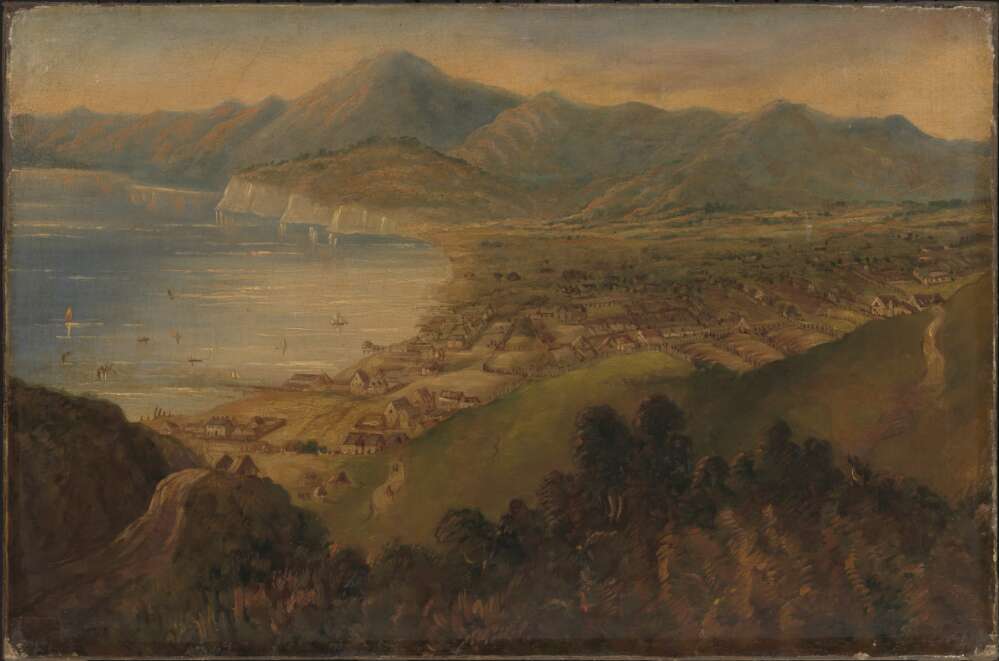
Brees, S. C. [Samuel Charles Brees](1850). Te Aro Flat near Captain Sharpe's residence, Wellington, New Zealand Retrieved from http://nla.gov.au/nla.obj-134294509
After living in New Zealand and revisiting London, Harold Brees came to Sydney in 1858. There, according to the architect J.J. Davey, he was employed for a time in the NSW Public Works and Lands Departments as an architectural draughtsman, simultaneously managing 'a little private work as they all did’ – and a considerable amount of watercolour painting.
Harold Brees was advertising his willingness to execute a wide range of work, including lithographic billheads, plans and drawings, in the Sydney Morning Herald on January 8th 1859, his address being 125 Prince Street, Church Hill. His father, engineer, architect and also an artist, Samuel Charles Brees (appointed acting colonial engineer for Victoria, remaining in charge until 1853) was also in Sydney as an Architect by 1858/59.
Within twelve months Harold Brees had moved to Cook’s River Road and was advertising 'Artistic Drawings of Residences and Views, taken for England’ for 5 guineas. On August 28th 1861, he advertised 'truly reasonable’ architectural drawing classes at his rooms in the Commercial Chambers, New Pitt Street, opposite the Sydney Exchange.
Harold Brees was practicing as an independent professional architect and surveyor in the Commercial Chambers by November 26 1862 when he invited the public to inspect a villa he had just completed in Ocean Street, Woollahra, opposite Mr Mort’s. On December 27 he promised a saving of 50 per cent if clients employed him when building his (and his father’s?) designs, then on display in the Architectural Gallery he had opened in his rooms. By March 1862 he was displaying 100 new model plans for houses, churches and public buildings, all apparently designed by S.C. Brees. Harold was clearly the active, resident architect of the firm; he took over both the promotion and authorship of the model plans when his father reverted to travelling and painting.
Harold was calling tenders for Villa Tuscana at Hunter’s Hill on April 25th 1863, while his father was penning letters to the hen newspapers:
TENSION GIRDERS.
TO THE EDITOR OF THE EMPIRE.
SAMUEL CHARLES BREES, C.E., Architect.
Opposite Exchange, October 23. In full at: TENSION GIRDERS. (1863, October 27). Empire (Sydney, NSW : 1850 - 1875), p. 5. Retrieved from http://nla.gov.au/nla.news-article60550552
OUR STREET ARCHITECTURE.
To the Editor of the Herald.
Sir,-One of your correspondents " New Pitt-street'', in this mornings' paper, makes some observations about a hideous excrescence being, placed " on a Norman or Tudor building ' next the Mutual Provident new Offices, in New Pitt-street, and exclaims that it utterly defaces both, the Norman or Tudor, and the Mutual Provident building, but he might have left out the word "Norman'', since there is nothing of that style in either of the buildings. And how can we tell what the effect of the portico " gallery ' will be before we hive seen it It is quite time enough to condemn this everescence when it is found to be a failure There is, however, one thing certain, that covered ways, or piazzas, might be advantageously adopted in this country, more frequently than they are, also that it is almost impossible to make more brutal makeshifts than are to be found attached to the fronts of some of the Norman and Italian (comic) houses of this fair city. For instance, that situated at the corner of King and Castlereagh streets, opposite Hampden s Hotel, with the " tall and thin columns, and the " short and stout " ballusters over them. But it is of no use lamenting, no one feels or believes in architecture
I am, Sir. your obedient servant,
SAMUEL CHARLES BREES, architect. 139, Pitt-street. OUR STREET ARCHITECTURE. (1863, December 25). The Sydney Morning Herald (NSW : 1842 - 1954), p. 5. Retrieved from http://nla.gov.au/nla.news-article13092585
By April 1865 his office was at Mort’s Passage in George Street; in July he was again offering savings of 50 per cent in building costs and was still advertising his large collection of varied designs for villas in all styles in November. Late in 1866 Harold published Rural Architecture, a portfolio of thirteen 'Modern Designs for Villas and residences complete, for gentlemen building without the assistance of an architect’, which cost 2 guineas. He separately offered designs for market buildings.
In 1866 he married Rosanna Mary née Connor in Sydney. The first of eight children, seven sons and a daughter, named Samuel Charles after his grandfather, was born the following year:
On the 27th May, at Victoria-street South, Darlinghurst, the wife of Mr. HAROLD BREES, of a son. Family Notices (1867, June 1). The Sydney Morning Herald (NSW : 1842 - 1954), p. 1. Retrieved from http://nla.gov.au/nla.news-article13146607
Children of the union (including twin sons on October 31st, 1869):
BREES SAMUEL C 1181/1867 HAROLD ROSANNA MSYDNEY
BREES EDGAR 43/1869 HAROLD ROSE M SYDNEY
BREES OSWALD A 2615/1869 HAROLD ROSE M SYDNEY
BREES ALFRED J 2616/1869 HAROLD ROSE M SYDNEY
BREES WILLIAM A 3125/1871 HAROLD ROSE M BALMAIN
BREES ANN E 3098/1873 HAROLD ROSANA M BALMAIN
BREES SYDNEY V 3504/1877 HAROLD ROSEANNA BALMAIN
BREES ERNEST H 4296/1879 HAROLD ROSE M BALMAIN
BIRTHS. On the 21st October, at Brougham-street, Woolloomooloo, the wife of Mr. Harold Brees, of twin sons. Family Notices (1869, November 3). Empire (Sydney, NSW : 1850 - 1875), p. 1. Retrieved from http://nla.gov.au/nla.news-article60896309
On the 12th May, at Marine Villa, Donelly-street, Balmain, the wife of Mr. Harold Brees, of a son. Family Notices (1871, May 17). Empire (Sydney, NSW : 1850 - 1875), p. 1. Retrieved from http://nla.gov.au/nla.news-article60872135
BIRTHS. BREES. –February 26, at her residence, Johnson's Bay, Balmain, the wife of Harold Brees, of a son. Family Notices (1877, February 5). The Sydney Morning Herald (NSW : 1842 - 1954), p. 1. Retrieved from http://nla.gov.au/nla.news-article13389118
He also had at least one stepchild to feed:
SPEEDING—BREES.—November 29, at St. James's Church, Sydney, by the Rev. C. F. Garnsey, William Clementenville, son of William Speeding, Esq., Poplar, London, to Emily Connor, stepdaughter of Harold Brees, Esq., Balmain. Family Notices (1877, December 28). The Sydney Morning Herald (NSW : 1842 - 1954), p. 1. Retrieved from http://nla.gov.au/nla.news-article28397142
SPEEDING—BREES—Nov. 20, at St. James's, Sydney, William Clementenville Speeding to Emily Connor Brees. Family Notices (1878, January 3). The Sydney Morning Herald (NSW : 1842 - 1954), p. 8. Retrieved from http://nla.gov.au/nla.news-article13405252
Mr. Brees appears to have then spent some time travelling. A review in the Sydney Morning Herald on April 20th 1868 noted:
A very spirited representation, in watercolours, of the town of Rockhampton is on view at Messrs F. & E. Cole’s book warehouse in George Street. We are informed that it is from the pencil of Mr Harold Brees, a gentleman favourably known in professional circles as an architect and artist of no mean skill. The present example of his aptitude for drawing shows that he has a keen eye for all the peculiarities of our scenery, as well as a happy method of committing his impressions to canvas or paper. The Messrs Cole have several other sketches by Mr Brees, including a clever cartoon of Rushcutter’s Bay.
At the 1870 Sydney Intercolonial Exhibition Harold Brees – as both a painter and architect of Hunter Street – showed a collection of architectural drawings and three watercolours: Bondi Bay (7 guineas), Botany Bay and Port Jackson (both 6 guineas). The jury commended the third and his architectural designs were awarded a bronze medal. Although primarily listed as an architect in Sydney between 1865 and 1900, Brees retained a great interest in painting, exhibiting with the NSW Academy of Art from 1871.
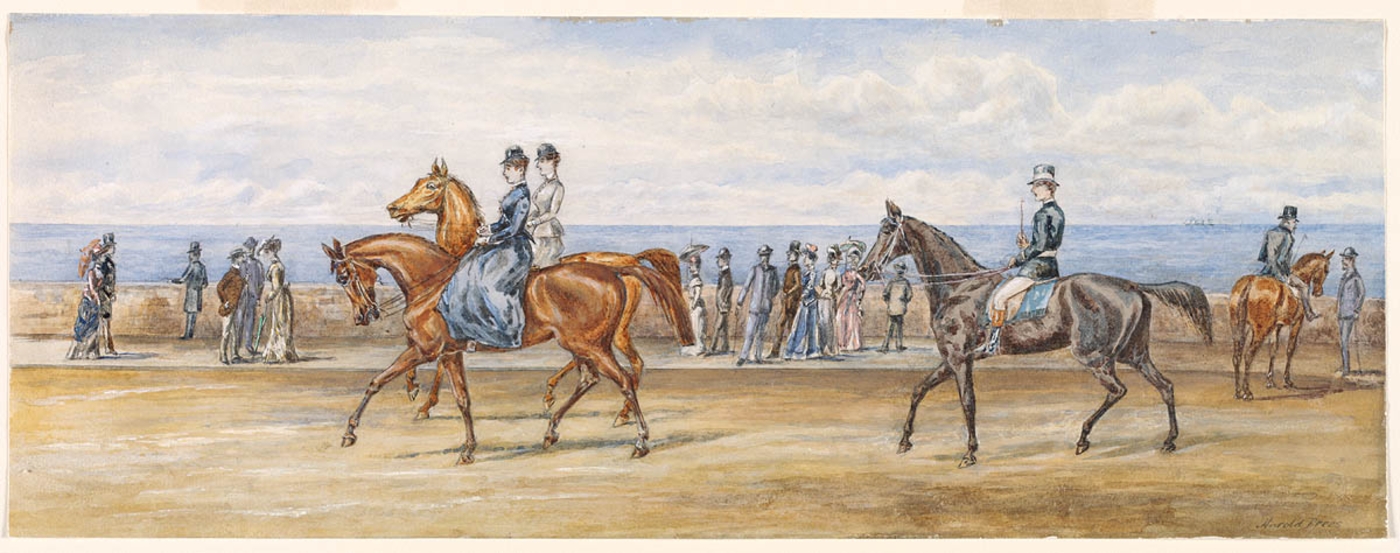
Promenade, ca. 1870-1895 / Harold Brees - In Sotheby's auction catalogue the work is entitled: The promenade Coogee beach. See: Fine Australian Colonial Furniture, Paintings Australian Pottery and Works of Art. Paddington : Sotheby's Australia, 1988. Lot 152. Item:a1528201, courtesy State Library of New South Wales.
In 1872 he showed an oil painting, Near the Araluen, 'a pretty bit of light and shade’ which was awarded an honourable mention. The Sydney Mail stated that this 'dashing little picture’ was 'in curious contrast to the style of the same artist in water-colours’ and added, 'most people think it is greatly superior’. Sponge Valley, Bondi, another oil, was also shown, along with several watercolours. His oil Sugarloaf, Middle Harbour was lent by E. Stack to the Academy’s 1874 exhibition. The three watercolours he showed in 1876 were for sale at prices ranging from 2 to 6 guineas. He showed Inward Bound (w/c, 3 guineas) in 1877.
Harold Brees was also actively involved with the Art Society of NSW from its foundation in 1880. He showed works at its annual exhibitions until 1886 and was honorary auditor from August 1881 until 1892. The paintings he showed at the society’s first exhibition were not, however, well received: 'Mr H. Brees has a number of pictures, of which those representing Mount Alexander and its vicinity are at least like the scenes they were painted from’, the Sydney Morning Herald opined in its report of December 23rd 1880.
The following year’s offerings fared somewhat better. Narrabeen Heads was damned with faint praise, only the ship being considered 'well painted’; Blackwall Cave, Lane Cove River had merit, 'but the group of campers which the artist has shown is short of its fair allowance of legs’. Rounding the Point, however, was judged a good yachting picture, one of the artist’s best: 'he evidently knows his subject thoroughly, and his boats really look as if they were going’.
At the third exhibition Brees’s three landscapes, including one of Pitcairn Island, were considered 'a decided advance in his style’ and two paintings shown the following year, Unexpected Visitors (a party of troopers at an Aboriginal camp) and another view of Mount Alexander, Victoria, were judged Brees 'at his best’.
As well as designing and supervising the erection of buildings such as St Andrew’s Lodge of Freemasons in Clarence Street (1874), Brees did the sort of commercial work that helped keep artists alive in Sydney. In 1880 a pamphlet promoting 'the beauties and attractions of Newport, Pittwater and the celebrated Hawkesbury lakes’ was published as a real estate promotional venture with nine lithographs by S.T. Leigh & Co. after watercolours by Brees. These were all to promote the New Marine Township of Newport.
Mr. Brees won seventh prize (£5) in a competition held by the printers and stationers Gibbs, Shallard & Co. in 1882 for a set of three paintings: Hiding from Pursuit, Boundary Rider and Cattle Drovers. Again they were not popular with the critics. According to the Daily Telegraph (29 April 1882), the former was 'not a success, being forced both in conception and execution’, while the other two were 'of equal merit’. Brees disposed of a large collection of his paintings by art union about this time 'together with those of other well-known artists’. Nevertheless, he was still producing watercolours in 1895 – the date on a pair of sketches of a shepherd and his sheep (p.c.).
Later in life he seems to have taken up his pen to write stories, this one being widely published in the rural newspapers of then:
Droving in the Early Days
By Harold Brees
I.
Tell you a yarn, Joe; yes, I'll tell you a true one of ages ago, at least, so it seems to me, as I think of the old days before the New Chum element appeared,' and the bushman's features became animated as his recollections of youthful excitement and pleasure stirred his mind. * * *
The weather had been assuming a threatening aspect for several days, denoting rain, before we completed mustering all the cattle intended for the Melbourne market. It was in the early spring of 1852 that we started from Muttama Station, on the Murrumbidgee River, with a mob of 800 cattle, nearly all from the mountains, and as wild as one could find them. A few days after leaving the home station the rain came down in torrents, as we expected, and kept on doing so for three weeks, so that we never had a dry shirt on our backs, day or night. Amongst the stockmen was a young man named Dickson, who came with us in order to gain a little experience, and also an old hand named Jack Small, more commonly known as ' Galloping Bungie.' The former was chosen for the easier and shorter watch at night time, and to tail the cattle immediately after nightfall. He was to remain at his post for two hours, though we could not always trust him entirely to himself. Once, I remember, at the termination of a long day, after hard riding for each of us, when the time came for Dickson to enter upon his watch, a thunderstorm broke over our heads, accompanied by rapid and vivid flashes of lightning.
The cattle were snugly camped in the fork of a creek, as yards or enclosures were unknown in those days. The other men were lying down, rolled up in their blankets, in front of a blazing log fire, against a fallen tree, sleeping only as men can who are worn out with rounding up cattle all day. One man, though, the cook, was awake, waiting for the hot ashes to accumulate, in which to bake the damper. About 10 o'clock all hands were suddenly awakened with the noise and heavy sound of 'cattle rushing.' It was known immediately that the mob had broken away, and all through Dickson's fault. The cook, who was making the damper on a log, was upset and almost trampled to death by the bullocks in their fright to get away, while we fled hurry scurrying in all directions,—no supper for us that night, nor any meal until 4 o'clock next day.
It appeared that Dickson had fallen asleep in hi6 saddle, and the lightning must have terrified some of the bullocks, causing a general panic, followed by a stampede, and then they rushed the camp fires, that being their only way out of the fork. Dickson was thrown off his horse and narrowly escaped with his life; our horses also got away in the confusion, and, instead of our night's rest, of which we all stood so much in need, we spent the time in trying to catch our runaway ' Yarramen.' All our mob were young cattle, as I have said, very wild. Nearly all of them were mustered from lone fiats and ridges, away in the back ranges, very few ever having seen the inside of a stockyard rail. About midday, after the first bolt, we were having a pot of tea and damper, and the cattle were feeding, when, suddenly, they rushed again. Nothing alarmed them, it was merely their frolic. They formed into two bodies, each rushing in opposite directions, with tails up and heads down, tearing through the black shag and close timber.
' Now, boys!' Lou Crow, the Boss, called out; 'jump on your horses and head the beasts round before they fetch those spurs '.
'My word, but they can gallop,' Bungie said; 'they won't pull up this side of five miles, but they are leaving a good track.' . We caught the horses which were grazing with the saddles and bridles on. Pat Murphy, -who was riding a 'green' colt, sent to assist in turning the mob, but, directly he was up with them, the colt; !«ok fright at the confusion and commenced bucking, throwing Patsy 'sky wards,' though one of our best roughriders; tat such accidents will occasionally happen. He was not hurt, and the 'green un' joined the cattle. Dickson, the only man with him at the time, continued the pursuit, and, to ensure more safety, held on j» the pommel of the saddle with one as he was not yet a good rider, j His horse, being an old hand in the business, knew exactly what to do, and kept at a swinging gallop, regardless of fee.. and overhanging branches, which rider must somehow avoid. With all Jackson's praiseworthy endeavours, he not come back with the cattle. He had one boxed up in some of the gullies, and so lost himself.
This necessitated Lou Crow and two other men riding over the country in search of him, otherwise he would have been lost altogether; eventually he was found some miles away. Of course, if he had allowed his horse to work the mob in the usual style, this delay would have been avoided. We had to camp this night without the aid of a creek, and counted the mob as well as we could, and, on the following day, the cook was instructed to proceed onwards and prepare supper at the most convenient bend he could find.
II.
Reaching the Yellow Holes Creek, near Tarcutta, at the end of a very wet day, our cook had made a most comfortable' camp,—including a mia-mia—and we were hoping to have the chance of sleeping in a dry blanket. The cattle were driven into a fork, of some acres in extent, with plenty of grass,—up to their knees. During supper it was the general opinion that we should have a stormy night, and must prepare a number of fires across the head of the bight, and keep a most vigilant watch.
Lou Crow went round the creek to see if there could be any 'get-away', for an inquiring-minded bullock. As expected, a terrible storm broke during the night, with heavy wind gusts and sounds, as of torrents, drenching us to the skin. The noise of the furious wind blowing through the bush, and, at intervals, loud crashes of timber falling made the night more awful. The cattle became very restless, bellowing and moving about, and would not lie down. It was a sight to see the enormous beasts through the darkness, as they wandered round the trunks of the stringy-bark trees, trying to push themselves into the centre of the mob. The weird scene, combined with the incessant noise of 800 cattle, composed a tableau on such a night never to be forgotten; as flash after flash of angry blue lightning illuminated the gaunt trunks and heavy-bending limbs of the old forest trees. Presently the loudest and most fearful clap of thunder burst, before the echoes of the last had died away, against the rugged face of the adjacent ranges, and we were aware the cattle had commenced breaking camp. We were all quickly on the move.
Tom Ridley, a native of the Murrumbidgee, who was considered to have the best eyesight, and was an expert bushman, was sent on horseback to follow the bullocks as beat he could. Fallen timber was in all directions, and the night couldn't be darker; creeks and blows of rock were all over the country, which made riding very dangerous.
Lou Grow started to intercept the cattle where he thought they would pass, but had not proceeded far when his horse fell over a bank into a creek; he was only bruised a little, but the horse had broken his shoulder. The saddle and bridle were removed and another start me. We swung in pursuit, taking advantage of every every flash—another flash—often having to wait for one. The mob were still rushing onwards, regardless of danger, galloping across the gullies, passing through the the saplings and dense undergrowth of foliage, gracefully as the bounding kangaroo, seldom breaking a twig or disturbing a leaf on the extended branches. At length the morning began to diffuse her welcome light, showing the wet dead timber scattered about, and the boggy ground.
Tom Ridley now perceived that he was at the tail end of the cattle; they were travelling as fast as they could, and been doing so for the last three hours, before he clearly discerned them, making a straight course to their own run. It was now necessary to push his horse to its utmost speed and pass the ruck of fleeing cattle.
Two hours after daylight the fast riding brought him up with the leaders of the mob, which he raced for another mile, and, ultimately with great skill, headed the beasts and turned them back, successfully rounding in the others as he met them, which formed a straggling procession, then, turning the whole crowd into the track they had made, he drove them into camp. We soon became once more hard up and returned with all haste to Muttama for another mob.
III.
Another adventure we had. Looking round the gentle slope upon which we stood, we saw in the distance a slab hut and small stockyard. Proceeding there, we discovered it to be untenanted, and just the place to suit us, with plenty of feed for our hungry horses, and a comfortable shelter for ourselves. Having had a good meal, we were soon snugly rolled up in eur blankets. Quite suddenly a noise made us "start" from out of our down beds; sometimes it sounded outside | the hut, then quickly we heard a terrible noise inside, near the chimney place, like men engaged in a fearful struggle, accompanied with awful stamping and heavy moans. None of us could understand it, as we were quite sure no other people were about the place ; we got up and began ghost-hunting, and at length sat before the fire for the remainder of the night. ' My word!' old Bungie said, after looking for some time into the smouldering ashes of the dying fire; 'I vote we make tracks for a rock gunyah, I know of, not far away.' 'No fear; I don't go on the wallaby to-night, ghosts or no ghosts;' Lou Crow said. ' Better that than listen to these fearful sounds,' Bungi* remarked. . ' Be they man or devil r ' I say, Bungie ?' Pat inquired; ' what do you know about these parts ?' ' Nothing much.' 'Are there any blacks along here?' Pat says. ' Maybe it's some of them varmints.' ' I've heard tell there used to be a pretty wild tribe down on the Minori, but this ain't blackfellers.'
We kept talking and smoking until the first streak of daylight, and we were all upset by what we had heard, and after breakfast were glad to be once more in the open, and were almost leaving our uncanny quarters had it not been for the rain. Evening found us still stationary, and we fervently hoped that we should have a spell of peaceful slumber. We had not been asleep very long, when, right in our midst, was heard the clash of something, as if thrown heavily upon the floor. We all started and sat bolt upright to listen, and could see the scared faces of our little party.
'What can it be ? Do you see anything ?' was whispered in awestruck tones. ' Is not that something creeping round by the side of the fire ?' ' Hush! be quiet! No; there's nothing there.' ' But see; it looks like a shadow stooping to pick up something!' Then came a loud thud, and we felt inclined to cover our faces with the blanket, as shriek after shriek was heard. Presently we found the billy of tea upset; how, no one knew, and then a sheet of bark was blown from the roof. By this time we all felt inclined to vacate the place, Lou Crow included. And so we left the hut in the middle of the night, through the rain and cold gusts of wind.
We found shelter under a rock until morning, when we packed the swags on the horses. Much to our satisfaction, we arrived at the Minni Minni Station, and, sitting round a cheerful fire, with plenty to eat and drink, entertained our host with an account of our ghostly experience. ' Oh, that must be Blasted Corner; the old hut is still standing, but no one from thn8e parts would care to pass it after nightfall.' ' What are the folks afraid of ?' Bungie asked: ' Oh, well, queer things are said about it, you know,' answered Mr. McKinnon. ' The story goes that three assigned men and one woman took up their quarters there, some eight or ten years ago, and during a drunken row, it is suspected that a terrible murder was committed, as the bodies of two men and a woman were found dreadfully mutilated.' SHORT STORY (1901, June 1). Cowra Guardian and Lachlan Agricultural Recorder (NSW : 1896 - 1907), p. 3. Retrieved from http://nla.gov.au/nla.news-article261806928
Harold Brees died at his home, 7 Ormond Street, Paddington, on April 28th 1904, aged sixty-six. He was survived by his wife Rosanna and three of his seven sons. His daughter Ann also predeceased him. He was buried in the Church of England Cemetery at Waverley. His wife would continue to run 'In Memorium' Notices for him for years following his passing.
BREES-In loving memory of my dear husband and our dear father Harold Brees, who died on April 28, 1904 Inserted by his loving wife and children. Family Notices (1909, April 28). The Sydney Morning Herald (NSW : 1842 - 1954), p. 8. Retrieved from http://nla.gov.au/nla.news-article15053986
In 1909 his widow presented one of his watercolours, Old Entrance to the Botanical Gardens and Site of the First Art Gallery Building, to the Art Gallery of NSW. In 1911 it was transferred to the Mitchell Library, State Library of New South Wales, which holds more of his sketches. He is also represented in the National Library of Australia. He is largely forgotten both as a painter and an architect and his work rarely appears at auction (one of his watercolour views of Sydney Harbour was sold by Deutscher Fine Art in 1985). The unsigned drawing of a 'Proposed Captain Cook Statue’ on Sow & Pigs Island published in Colonial Society in 1869 is also attributed to him.
His wife passed away in 1923, her parents listed in NSW BDM's as John and Rosa:
DEATHS. BREES.— October 21st, 1923, at her residence, Coleraine Street, Fairfield, Roseanna Mary, widow of the late Harold Brees, of Sydney, aged 87 years. R.I.P. Family Notices (1923, October 23). The Daily Telegraph (Sydney, NSW : 1883 - 1930), p. 6. Retrieved from http://nla.gov.au/nla.news-article245990925
However, it is his watercolour sketches of our area from Narrabeen to Newport that allow us to see the then landscape of these views he created as he saw them.
Description of Newport
Pittwater and the Hawkesbury Lakes
From: Brees, Harold & S.T. Leigh & Co & Mills, Pile & Gilchrist. (1880). The Pittwater and Hawkesbury Lakes album Retrieved from http://nla.gov.au/nla.obj-460123425
The road to Newport, after leaving Manly, crosses the Curl Curl Lagoon, on a solid embankment about twenty feet in width and half a mile in length. It then passes along the northern side of Curl Curl Creek for a mile or so, leaving a splendid rich country belonging to the Bassett Darley Estate, to the left. At the head of the Creek can be seen a range of steep hills—about six hundred feet in height—clothed in vegetation to their tops. The swamps between these hills contain a large and unfailing supply of water at a sufficient elevation to be easily conducted by gravitation to almost every house in Manly.
Dewhy Lagoon, a beautiful sheet of water of about 100 acres in extent, is about four miles from the Pier Hotel, and is only separated from the ocean by a narrow ridge of sand. This lagoon (like other sea-side lagoons) varies greatly in size from time to time, and like all the others its outlet is on its northern end. A succession of easterly gales heaps up the sandy barrier, and enables the rain waters from the mountains to increase to a great extent, until the accumulated water, through heavy rain, becomes too strong for the sandy barrier and bursts through to the ocean, leaving immense quantities of fish stranded on the beach.
Long Reef, a beautiful basaltic hill right on the coast, is the homestead of Miss Jenkins, whose family have been residents of this locality nearly half a century. The soil here is very beautiful, and the scenery grand beyond description, A fine vein of iron ore is exposed on the ocean beach, but it has at present no commercial value.
The Narrabeen Estate, the property of Mr. Wetherill, of Sydney, extends from Long Reef to Narrabeen Lake. It was once in cultivation, as can be seen by the plough-marks, and produced large crops of maize. The lake is a splendid sheet of water, generally about a mile in width, extending among beautifully wooded hills inland for a great distance, with wide navigable arms penetrating further into the valleys between the mountains. It is well stocked with fish, and there are some fresh water lagoons with abundance of silver eel. It is remarkable that this beautiful lake, so easily accessible, is so little known. Game abounds in the ranges to the west. As said before, fish is abundant, and being secure from sharks, and of even depth for long distances, it is the safest and in every sense the best place for a long swim near Sydney. Should Mr. Wetherill subdivide his Estate, and a good hotel be built, a new watering place will spring up on the shores of this enchanting lake, which will speedily become popular. The sketch herein is taken from the southern side, at the present crossing place, which will shortly be superseded by a bridge.
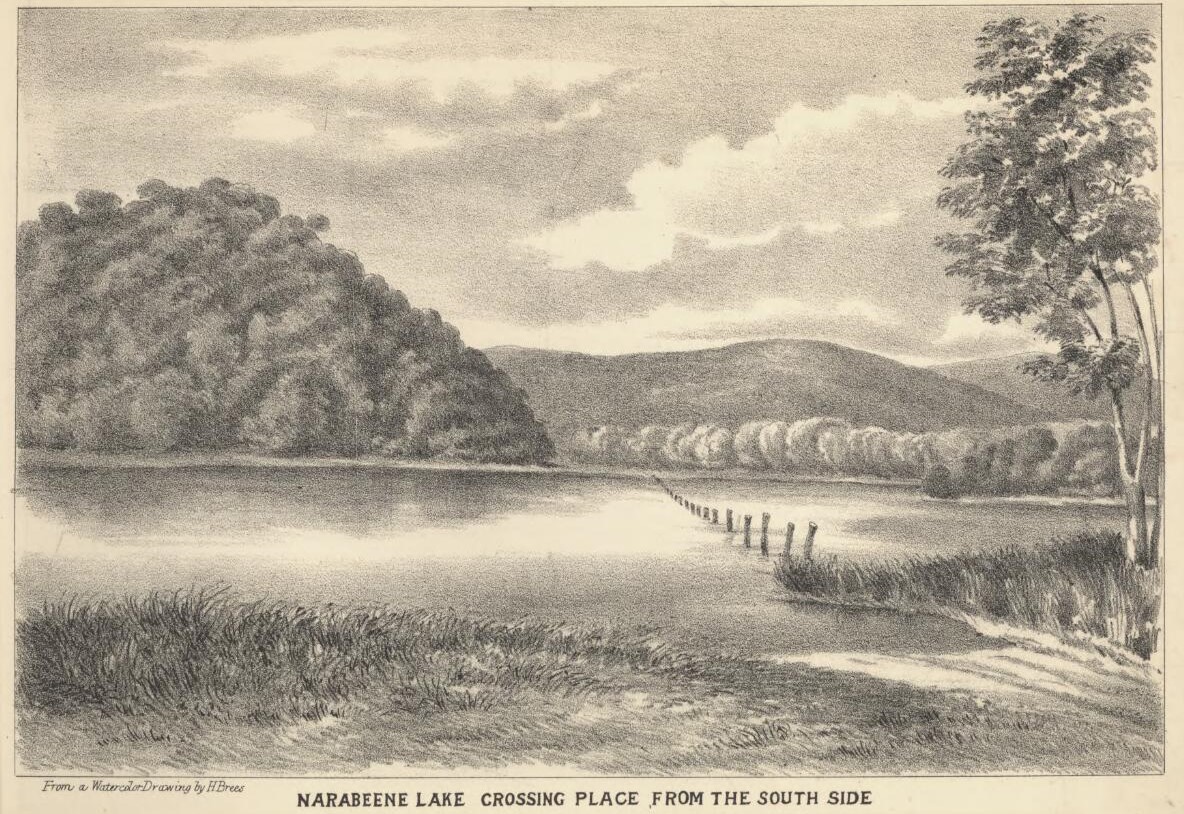
NARABEENE LAKE CROSSING PLACE FROM THE SOUTH SIDE
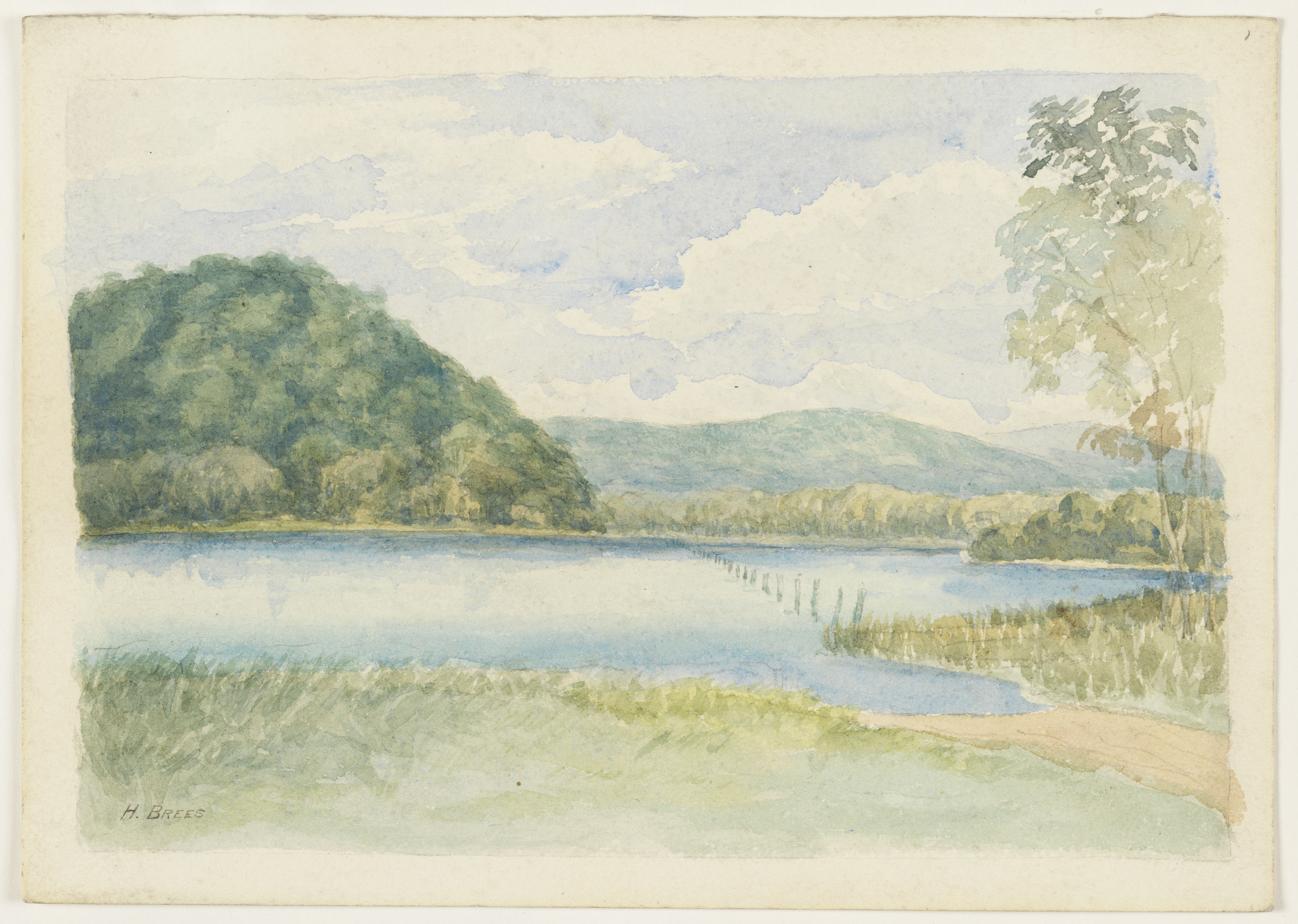
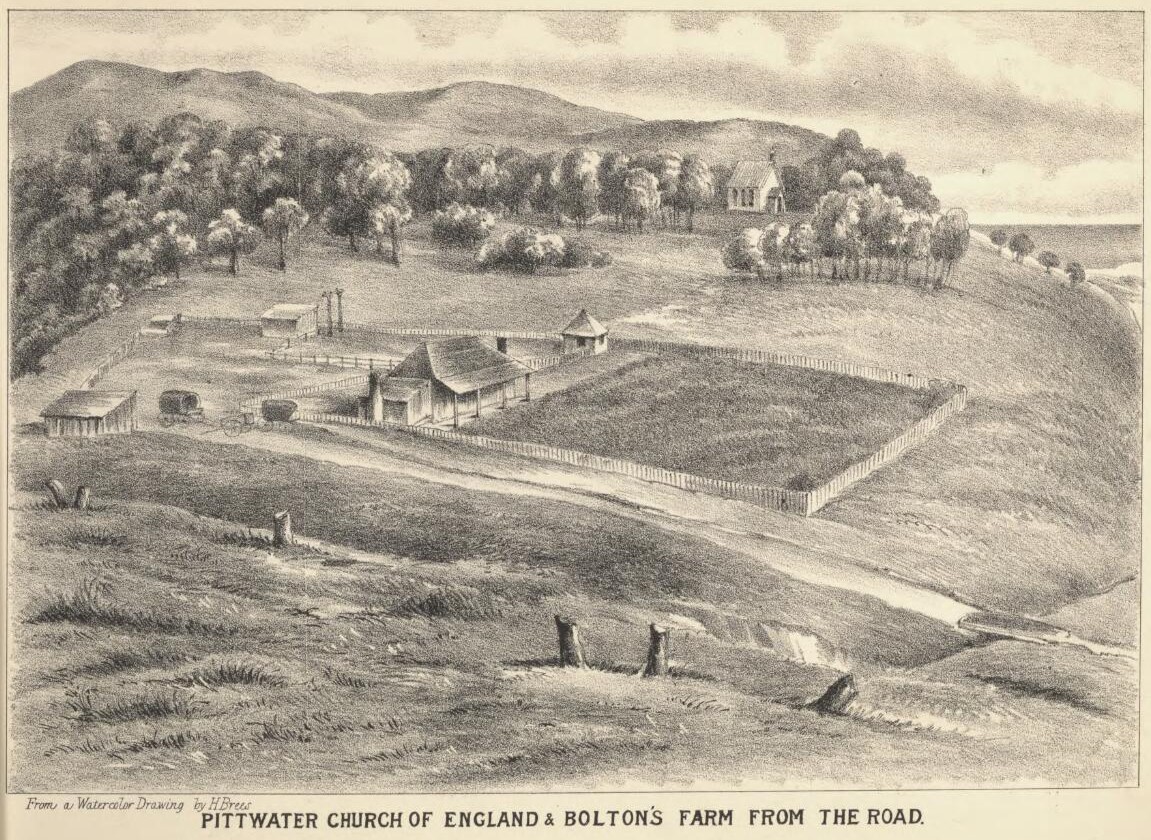
PITTWATER CHURCH OF ENGLAND. BOLTONS FARM FROM THE ROAD.
About a mile beyond Narabeen the road crosses a steep hill from the top of which the hills beyond Newport, as well as Lord Loftus Point, are distinctly visible, we next come to BOLTON’S FARM, the subject of an illustration. The soil of this locality is very rich, and it is rather strange that it is not cultivated.
All Harold Brees lithographs/sketches of Narrabeen to Newport from: Brees, Harold & S.T. Leigh & Co & Mills, Pile & Gilchrist. (1880). The Pittwater and Hawkesbury Lakes album Retrieved from http://nla.gov.au/nla.obj-460123425 and coloured versions from Collection: Pittwater scenes, 1880 / Harold Brees - The drawings appear to be the originals for six of the lithographs illustrating 'The Pittwater and Hawkesbury Lakes album'. [Sydney] : Mills, Pile & Gilchrist, 1880. (Lithographed by S.T. Leigh & Co.), courtesy the State Library of New South Wales.

To support this expansion of local art of local places by resident artists, sketchers societies and clubs were formed - one example is that established by Pilford Fletcher-Watson:
SKETCHING INSTITUTE OF NEW SOUTH WALES.
A movement, calculated in every way to stimulate art culture in New South Wales, assumed definite form last night at the studio of Mr. P. Fletcher-Watson, in Foy's chambers, Bond-street and that gentleman may be congratulated upon the success which attended the initiation of the Sketching Institute formed under his auspices. The idea has been derived from the famous Langham Sketching Club in London, which contains amongst its members many of the leading English artists. The club was founded under the direct patronage, of the Queen, who took so lively an interest in all its proceedings that artists began to regard the privilege of membership as one of the highest honours to be obtained in the profession, the sketches executed by them being invariably transmitted for the personal inspection of her Majesty.
The Sketching Institute of New South Wales, originated by Mr. Fletcher Watson, under the direct patronage of Lady Carrington, will be conducted on lines similar to those adopted by the Langham Club.
The prime object of the institute, which will in future hold meetings on the first Thursday in every month, is the promotion of good-fellowship among professional artists, but, above all, the encouragement of amateur talent and purely original work. The procedure of the institute has met with the approval of Lady Carrington, who has undertaken to supply the motif, or subject, of the evening's sketch. The motif will be communicated to artists who i enrol themselves as members about 10 days prior to the evening fixed for the monthly meeting and although artists may contribute sketches without attendance at the studio, the object of the club is that all drawings shall be purely extempore-flint is to say, executed without special preparation on the evening on which the meeting takes place.
The motif suggested last night by Lady Carrington was " Repose," and the response on the part of artists must be encouraging to the promoter of the movement. Three careful drawing- illustrative of the idea of repose were sent in by Mrs. Stoddart, Miss Devine, and Mr. A. J. Daplyn. Letters of apology for non-attendance were received from Mr. W. J. Trickett, ex-Minister for Education, and one of the patrons of the Art Gallery; also from Mr. G. C. Russell, architect, Sydney. The artists who attended and exemplified the objects of the institute by sketches on the spot were Messrs. Fletcher-Watson, W. Andrews, and J. Moore. The drawing by Mrs. Stoddart was that of a beautiful, loosely-robed female form with flowing hair, resting on a protection with a prayer-book in the hand. The face is expressive of mental repose, with perhaps a slight tinge of sadness, and the atmosphere without is also suggestive of tranquillity, a single stars being visible through the open casement. Miss Devine's drawing represents a loosely robed female figure seated on it piazza of massive masonry, gazing, with hands clasped upon the knees, upon an expanse of placid ocean. The foreground of the drawing consists of a single pillar to which jessamine is clinging, whilst at the foot of the pillar a pelican, with an air of content has taken up his quarters for the night.
The drawing by Mr. Daplyn is a view on the Hawkesbury River, where an artist with his sketchbook occupies a seat in the foreground under the shade of some overhanging rocks.
Of the three sketches executed last night in the studio, that by Mr. Fletcher-Watson was very effective. It represents a scene at Narrabeen from a recollection of an old camping ground, adjacent to a clump of high trees, and on the margin of the Narrabeen lagoon. Beneath the trees, on the left of the drawing, is a rickety fence to which a boat is moored. The background consists of mountain ranges, and the intermediate space is taken up by the placid lake and by a point of land covered with trees stretching into the water. The lights on the water are treated with great skill.
Mr. Andrews' drawing is a scene at George's River on a still evening, with an atmosphere charged with moisture. The shadows of the trees on the water, and the boat moored to a post on the beach, certainly convey an impression of deep tranquillity. The sketch by Mr. J. More is a sunset effect upon a calm lake, the main object in the foreground being a boat moored to the beach. The six drawings will be forwarded to Lady Carrington to-day. Upwards of 25 ladies and gentlemen have already taken part in the movement, and there is every reason to believe that that the Sketching Institute will become very popular amongst artists. SKETCHING INSTITUTE OF NEW SOUTE WALES. (1886, February 5). The Sydney Morning Herald (NSW : 1842 - 1954), p. 6. Retrieved from http://nla.gov.au/nla.news-article13610628
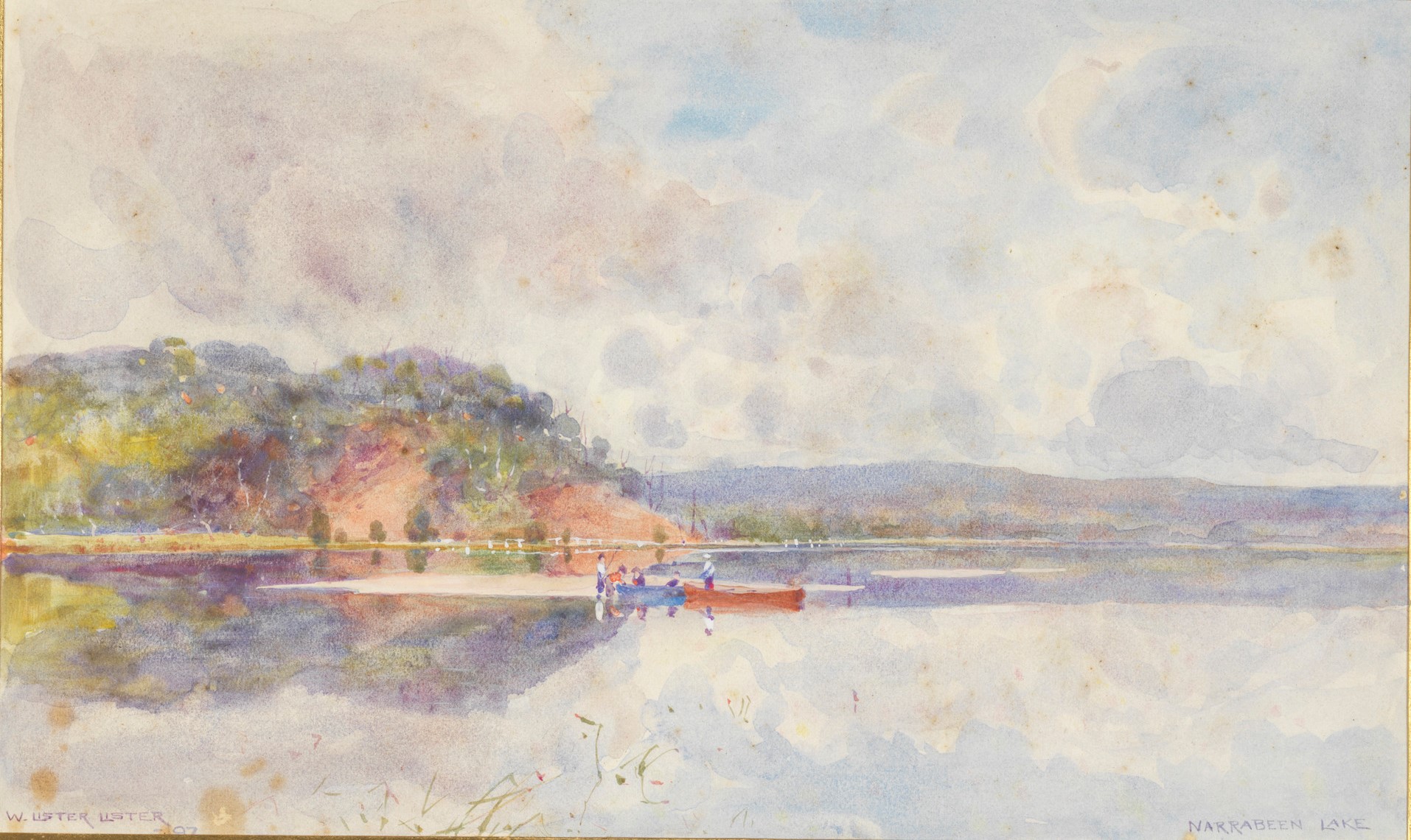
references - notes
- My Holiday - By Charles De Boos – 1861
- TROVE - National Library of Australia
- The Mitchell Library, State Library of New South Wales
- The Wild Coachmen Of Pittwater - A Long And Sometimes Bumpy Ride On Tracks Instead Of Roads
- Roads To Pittwater: The Mona Vale Road
- Henry Grant Lloyd. Writers: Turpin, Jennifer and Kerr, Joan. 1992. Design and Art Australia Online (DAAO). Retrieved from https://www.daao.org.au/bio/henry-grant-lloyd/biography/
- Profiles of the Pioneers in Manly, Warringah and Pittwater - George and Shelagh Champion, 2013 revised version.
- Pittwater Fishermen: Great Mackerel, Little Mackerel (Wilson's Beach - Currawong) And The Basin
- Broken Bay Customs Station At Barrenjoey
- The Newport School: 1888 To 2018
- Pittwater Roads II: Where The Streets Have Your Name - Newport
- Careel Bay Playing Fields Reserve - Including Hitchcock Park: Birds, Boots & Beauty
- Pittwater Roads II: Where The Streets Have Your Name - Careel Bay
- John Collins - of Avalon Pittwater Patriarchs series
- Maria Louisa Therry - Pittwater Matriarchs series
- Harold Brees biography - Design and Art Australia Online
- Samuel Brees biography - Design and Art Australia Online
EXHIBITION OF PICTURES.
To the Editors of the Sydney Morning Herald.
Gentlemen Since the writer for the Atlas has had his say about the domed toplight, perhaps you will refer to my manuscript, and inform the public and Mr. Punch where the error lies yourselves, or
Your obedient servant,
JAMES GROCOTT.
486, George-street, May 6.
[The error occurred in the mechanical department: it is domed in the M.S. - Ed..] EXHIBITION OF PICTURES. (1847, May 10). The Sydney Morning Herald (NSW : 1842 - 1954), p. 3. Retrieved from http://nla.gov.au/nla.news-article12890708
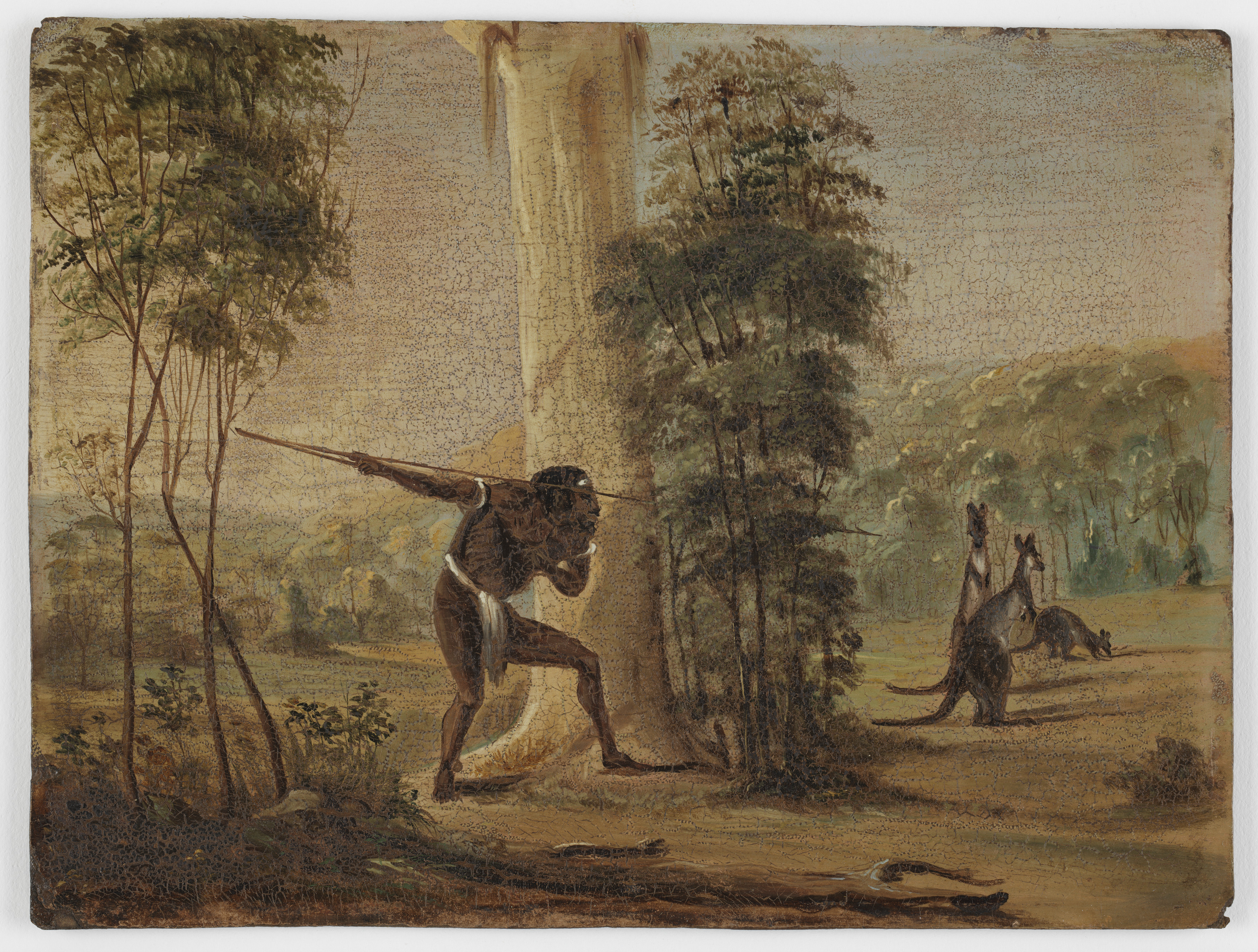
Aboriginal Hunting Kangaroos, 1840s / painted by an unknown artist. It is closely related to an aquatint titled "Charley" Spearing Kangaroo's which was published in Yarra-Guinea, ed., Frank Kennedy the Australian Settler, opp. p. 15 (Sydney: J.G. Grocott, 1847). This book includes illustrations said to be by "Tufts". The identity of Tufts is not known. This work is also closely related to an oil painting attributed to Captain Otway, RN, titled `Charley' Spearing Kangaroos, held in the National Library of Australia. It is more likely that Otway, a naval officer stationed in New Zealand in 1846, owned that work, rather than actually painting it. Item c25863_0002_c - information and copy courtesy Mitchell Library, State Library of New South Wales.
FINE ARTS.
A MEETING, pursuant to advertisement, took place on Saturday afternoon, at Mr. Grocott's Rooms, George street, for the purpose of establishing a society for the encouragement of the fine arts in New South Wales. We rejoice to say that the meeting was most numerously and most respectably attended, and the utmost and most cordial unanimity in the object to be attained was evinced.
Dr. NICHOLSON, M.C., having been called to the chair, opened the proceedings, by stating that he could have wished that some one whose station in society, and whose taste for the fine arts was more distinctly recognised, had been called to preside over them. Their motive in thus assembling was, he apprehended, to endeavour to found an institution, which in its appreciation of excellence in the works of art, should tend and cultivate the taste of the community. On that day week a meeting for a similar purpose had been called, but owing to the very unfavourable state of the weather, the attendance had been very limited ; but still a provisional committee had been formed, which Committee had formed certain resolutions, which would now be presented to them. It would be premature for him to enter into the views of the Committee ; but, he believed, the first object sought to be attained was the formation of an exhibition of pictures, which, as there were many paintings of merit in the colony, would, it was thought, excite that interest which would more than any thing else enlist public patronage in favour of the proposed society.
Mr. SUTTOR (Honorary Secretary), read the proceedings of the former meeting.
The ATTORNEY-GENERAL had, since coming into the room, been requested to move the first resolution ; and although entirely unprepared to say that which he could wish to say in support of it, still he could not decline what he felt felt to be the honour done him. Although the modesty of the Chairman might lead him to a sense of his own unworthiness, yet to believed that few would differ from him in the opinion, that the office could not be more worthily filled than by one whose life had borne practical evidence of his taste and love for the fine arts. With the exception of that gentleman's predecessor as Speaker-of the Legislative Council, he did not believe the name of any gentle-man in the community would carry so much weight with it, in such an undertaking. He had, therefore, great pleasure in proposing a resolution which had for its object the formation of a society which promised the most important results to the colony. It would give instruction in the study of the fine arts to colonial youth ; it would form and correct their taste, and draw forth talent that, as yet, has had no sphere in which to exert itself. In Ireland, his own country, he had seen the effects of such exhibitions, even so lately as the year 1828. So much had the fine arts been neglected, that it was with very considerable difficulty that the Hibernian Society had been formed. But when its exhibitions was once established, its effect was soon displayed. Taste improved, an emulation to excel in art sprung up, and the exhibitions of Ireland could now vie with those of other countries, and her artists were acknowledged, even in Italy, the seat of art, to be men of intrinsic genius. He was therefore delighted to see a meeting so numerous and influential as that now assembled ; and he believed if they only persevered they would achieve their object, and that its effects would be striking and important. The resolution he had to propose was;
" That a society be formed, to be called 'The Society for the formation of the Fine Arts in Australia ' That it consist of a patron, president, and vice-president, treasurer, and honorary secretary, committee, and members ; and that the object of the society be-first, the establishment of a periodical exhibition of paintings and other works of art; and, second, the foundation of a gallery of painting and sculpture."
Mr. M'LEAY, M.C., had much pleasure in seconding the motion, and was delighted to be in the position to congratulate the meeting and the colony, on the prospect of the establishment of so important and valuable a society.
Mr. Hipkiss, as one of the oldest, though perhaps one of the humblest amateur professors of the fine arts in the colony, could not but augur favourably for the success of the highly desirable object they had in view when he looked upon the numerous and influential meeting around him. He hoped what had been begun with so much energy and spirit would be carried out with an equal share of perseverance. He remembered a long time ago that in connection with a few others he had proposed the opening of a seminary for instruction in the arts, and many had promised to join, but few, very few came. He trusted that better fortune awaited them in their present attempt, and he was sure most important results would spring from it. He remembered the time when Birmingham, his native town, was without any such institution ; but it had since formed a society of arts second only to metropolitan institutions. Why should they not do so here. Why should they not cultivate talent, and foster genius? Why should they in New South Wales despair of being able to emulate the artists of Europe? Their climate was genial, and the colonial youth were quick enough and ingenious enough. He hoped the zeal that had been shown would not evaporate, but would continue perseveringly to carry out the great object. He would just remark that he hoped the committee would not be all artists, as dissensions would probably arise ; but that there would be a fair proportion of committee-men, not themselves artists.
The resolution was then put and carried.
Mr. COWPER should make no apology for moving the next resolution, because, like the Attorney-General, he knew not how to decline the honour thus conferred on him. The reso-lution required but little to be urged in its support. The very judicious suggestion of Mr. Hipkiss, as to the formation of the Committee, would bo found to have been attended to. The resolution appointed oifficers for the conduct of the Society, to carry out its objects. He sincerely congratulated them on the manner in which this important matter had been taken up. He agreed fully with all that had been said of the beneficial effects which would in all probability result from the formation of a Society like this. The social and moral tone of the community would be elevated by it, whilst it would lead the youth of the colony to emula-tion, in higher matters than those to which at present they directed their attention. He would also congratulate the colonists that the time had arrived when they could hope for success in their undertakingsuccess which in the depressed circumstances of the colony a few years ago, they could hardly have hoped to attain.
He would now move,
" That His Excellency Sir Charles Augustus Fitz Roy, be requested to become the Patron of the Society; that Charles Nicholson, Esq., Speaker of the Legislative Council, be the President ; and the Hon. Sir Alfred Stephen, Chief Justice -the Hon. E Deas Thomson, M.C., Colonial Secretary, - the Hon. John Hubert Plunkett, M.C., Attorney General, and Alexander M'Leay, Esq , M C, be the Vice Presidents ; and that Edwin C. Suttor, Esq., be the Honorary Treasurer and Secretary; and that the Committee consist of Charles Nicholson, Esq., M.C. ; J. H. Plunkett, Esq., M.C. ; Captain O'Connell, M.C. ; Arthur A Beckett, Esq. ; John Brown, Esq ; J. B. Darvall, Esq.. M.C. ; C. Irving, Esq ; George Miller, Esq.; A. Michie, Esq ; Robert Owen, Esq. ; A. B. Spark, Esq ; Edwin C. Suttor, Esq.; R. J. Want, Esq. ; Dr. Hill; Dr. Mitchell, Robert Lowe, Esq.; M.C; Captain Pollard, and J. Roe, Esquires ; and that George Miller, Esq., and R. O Wen, Esq., be the Auditors.
The SOLICITOR-GENERAL begged to second the motion, but not being prepared for the honour, he should not detain them except by a few very brief observations. He believed the names which they had just heard read as the officers and the committee of the Institution, would bring a great deal of taste, judgment, and information, to bear upon the subject. It appeared to him what was most wanted in the colony was amusements which the public could enjoy. The colonists had obtained, and deservedly obtained, a sufficiently high character for perseverance, aptitude, and industry, in business pursuits ; but they had stopped short there : they seemed to regard the colony as a London merchant did his counting-house, when he retired to it he expected to devote himself to business, and business alone ; and here the whole business of life was too apt to bo the making or trying to make money, He could not help thinking, when in a certain body the other day it was desired that members should be relieved from their duties in order that they might attend the Races, that the excuses made for them rested on a very bad ground. Instead of arguing that they ought to go to the races, because horse-racing encouraged the improvement of the breeding of horses, which formed an extensive branch of trade to India ; he thought it would have been better to have said at once that they ought lo go to encourage public amusements.
The motion was then put and carried.
Mr. OWEN: The resolutions which had been moved by previous speakers having formed the Society, it now became necessary to give the Committee power to act, so that its objects might be carried into effect. The first object the Committee had in view was the early formation of an exhibition of pictures, which it was believed would be more likely than other means to draw attention to the claims of art, and to excite a desire for its encouragement and promotion in this remote part of the civilized world. He believed that it would not be difficult to form such an exhibition, as there were a considerable number of pictures of very considerable merit in the colony-besides a much larger number of artists than was supposed, who would derive much benefit from the opportunities of study which such an exhibition would afford. The second higher object of the Committee was to form a gallery of art, in which the paintings, or copies of them, of the polished nations of Europe could be exhibited as models for study. If in Ireland and in Birmingham those institutions were found productive of so much benefit, where the facilities of seeing the finest works of art were so near at hand, how much more of good might be expected to result from them 'here, where they were shut out from all such advantages. Each one of them might perhaps possess a good picture ; but it was not from the contemplation of that picture alone that they could improve their taste in art. It was, therefore, necessary that funds should be provided to obtain useful and valuable specimens of art ; and not only was the study of the fine arts useful in the elevation of the community, but their influence in society was so great, that they ought be said to be almost essential to good government.
He would now move the following resolutions:
" That the Committee be entrusted with full power to make rules, regulations, and arrangements in furtherance of the objects of the Society, but that in no case is any debt to be incurred."
"That all persons paying in advance one guinea or more per annum, shall be members for the current year, and shall be entitled as such to free admission to all exhibitions of the society, and to vote at all general meetings,"
" That a general meeting of the members shall be held, and that subscriptions shall be due annually in May."
A vote of thanks was then given to the meeting, which then dispersed. FINE ARTS. (1847, May 24). The Sydney Morning Herald (NSW : 1842 - 1954), p. 2. Retrieved from http://nla.gov.au/nla.news-article12895962
DOMESTIC INTELLIGENCE.
SOCIETY FOR THE PROMOTION OF THE FINE ARTS IN AUSTRALIA.
FIRST EXHIBITION OF PAINTINGS.-
FIRST NOTICE HAVING been favoured with a look behind the scenes while the picture hanging operations have been going on at the Australian Library, we are enabled and gratified to announce that the exhibition will be opened, as advertised, this day, Tuesday, at 12 o'clock. We have also the pleasure to announce that His Excellency the Governor, the Patron, has consented to honour the Society (and we may add do honour to himself by being present at the opening. We cannot help congratulating ourselves and the public that our desire to estab-lish such an institution, which we have expressed in our columns from time to time for several years, is about to be gratified at lastand gratified, too, in a manner which we fairly confess exceeds our most sanguine expectations We have urged on the public repeatedly that there was abundant material in this colony for the purpose, and we shall leave the people to judge, this day, whether we have been mis-taken in our opinion. We rejoice to see that the matter has been taken up so warmly by the Committee, and their wishes so liberally responded to by the community. We look to this exhibition as something of much deeper importance than the mere gratification of the moment : it will read a great moral lesson to the colonists and the mother country.
It will show us that notwithstanding their distance from the centre of refinement, and science, and art, and notwithstanding the nature of the pursuits to which necessity may reduce them, the sons of Britain still carry with them the tastes and the habits of their fathers, preserve their pictures like he he hold gods, and submit to any privations rather than part with these treasured relics of their fatherland and it will show our friends in the other hemisphere, more than our largest amount of exports and imports, that our city has advanced with a giant's strides to the, proud position which she holds as the Queen of the Southern SBB the metropolis of a new world This day we are sure the eyes of the Australians who have never left the land of their birth, and open on a scene more pleasing and more magnificent, than it has ever been their lot to w>tness and even those who have recently left the shores of England, will be proud to confess that the first exhibition of paintings in Sydney would do no discredit to London Itself. We owe a debt of gratitude to the Committee for their gratuitous labours in forwarding the objects of the society. As is usual in all similar cases, we have heard of some grumbling against the selection made at the public meeting. It was supposed that the drones of the Committee would outnumber the working bees. Has it been so? The general Committee wisely left the whole of the arrangements to be made by a few of their number, including the Secretary, whose labours have been herculean and when we remind our readers, that from the day of starting the subject to the day of opening the exhibition exactly one month has elapsed, we think we, have given a most triumphant refutation to, the croakers' complaints. The hanging Committee have had a difficult, a delicate, and an, invidious task to perform. To satisfy all parties it would be necessary to make a good light out of an indifferent one and to place each person's picture in the best possible position, without reference to all other pictures exhibited. Now, as all these conditions cannot possibly be complied with, the Committee wisely determined, without respect of persons, to hang the pictures where they considered they would best suit the general arrangement of the room and we think any one who has not sent pictures to the exhibition, and unprejudiced persons who have will confess that the Committee have done their duty in a very straightforward and business-like manner.
To show how nobly the exertions of the Committee have been seconded by the public, we have only to state that, although numerous beautiful and valuable engravings were sent for exhibition, the Committee have been reluctantly compelled to lay them all aside, as well as several drawings and paintings of merit, for sheer want of room and we can only hope, nay, we are sure that this valuable institution, will be extensively supported, and that every one who has the slightest taste for the fine arts, and who can afford a guinea, will enrol himself as a member. A member's ticket will admit the member and family at all times, while the exhibition is open and we should imagine when the institution is firmly established, that there will be more than one exhibition during the twelve months. After the present exhibition is over, why should there not be an exhibition of engravings. We are satisfied there is a sufficient number in the colony to form a collection well worth the inspection of the public. We at least throw out the suggestion to the Committee. True, it may be said that it would be wrong to trapose on the good nature of the Australian Library Committee, by extending their been beyond reasonable points. The objection is reasonable, but we trust the day is not far distant when the Institution for the promotion of the Fine Arts in Australia will have a building of its own.
After feasting our eyes on the rare treat to be exhibited before them this day at the Australian Library, we shall endeavour from time to time to record our opinion of some of the most prominent of the works of art offered for exhibition. DOMESTIC INTELLIGENCE. (1847, June 22). The Sydney Morning Herald (NSW : 1842 - 1954), p. 2. Retrieved from http://nla.gov.au/nla.news-article12891416
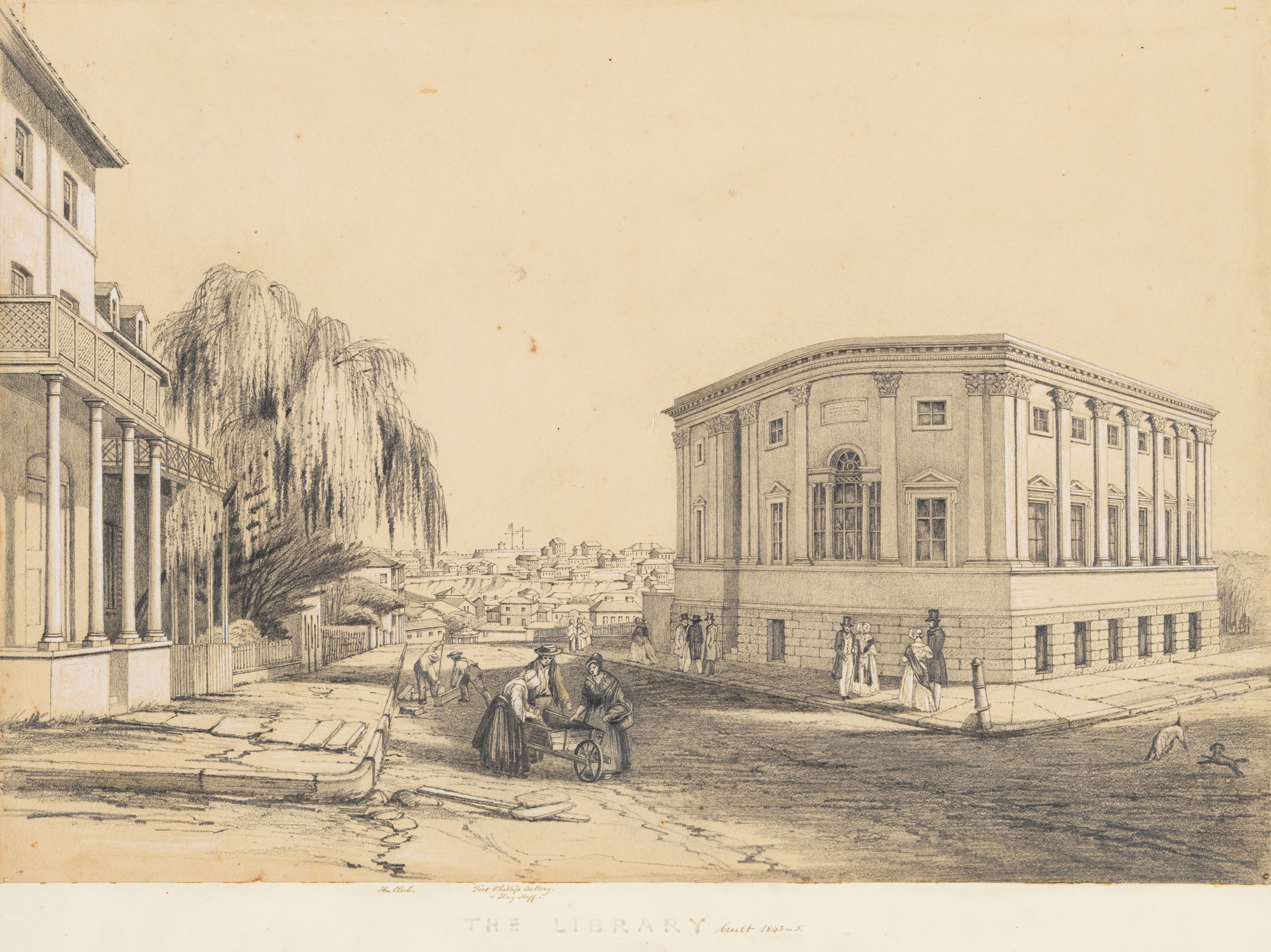
The Subscription Library, Bent Street, 1843-1847 BY JACOB WILLIAM JONES. Item: c11898_0003_h, courtesy the State Library of New South Wales. Find out more about the origins of this and The State Library of New south Wales at: www.sl.nsw.gov.au/stories/origins-state-library-new-south-wales-1826-1869
SOCIETY FOR THE PROMOTION OF THE FINE ARTS IN AUSTRALIA.
FIRST EXHIBITION.
(Concluded from Tuesday)
WE come now to a more difficult and invidious part of our labours, to speak of the works of our colonial artists and amateurs— hoc irritabile genus omne. We would gladly decline the task, but this would be leaving out the character of Hamlet from the play : for the improvement of our artists is one great object of the Society. Their works in the present exhibition number upwards of 100, but on account of the short notice which was given of the day of opening, very few of these were painted for the occasion. Instead, therefore, of alluding to their works seriatim, we shall give our opi-nion briefly of the ability and style of the artists, hoping that the examples of excellence which have been shown in the present exhibition may not be lost on our artists' pro-ductions in the next. We shall as usual follow the order in the catalogue, and first on the list stands the name of Felton, deceased. His works are—
3. Portrait of a distinguished Member of the Ilumine Society
341. Portrait of the Queen (after Tully).
Both in oils. They are both copies, but exhibit fair specimens of the artist's agreeable manner. Of the first we have already spoken. The second is a very correct and pleasing copy from a print. The likeness is good, and the colours clear and harmonious. Mr. Felton was one of our best portrait painters-as many of his works in the colony will attest.
The next in order is Mr. J. S. Prout, now of Hobart Town. The works of this artist exhibited by their proprietors are as follows, viz. :
19. South Head Reef, New South Wales.
40. Tempe, the Scat of A. B. Spark, Esq.
136. Macquarie Fort
137. The Weatherboard Inn on the Bathurst Road Road,
153. Spring Cove, Port Jackson.
154. The Valley of the Weatherboard, Bathurst Road.
160. View in Cornwall.
109. View on the Parramatta River.
172. A Winter Scene.
181. The Albion Mills on Fire, by Moonlight.
187. Cudgee Bay in a Storm.
191. Jamieson's Valley.
207. Winter Scene.
2?9. A Bush Scene.
250. Moonlight.
251. Sunset.
255. Neutral Bay.
256. Quarantine Ground.
257. Willoughby Falls.
260. Goat Island.
3?7. Moonlight Scene.
Three of these, Nos. 19, 40, and 257, are oil paintings, and have been formerly noticed ; the rest are water colour drawings. Of Prout's abilities as a landscape painter in water colours, we have repeatedly spoken with admiration, and we think that his works above enumerated arc sufficient to bear us out in the assertion that he is the best landscape painter who has appeared among us. We deem it unnecessary to particularise, or select from his works. They arc all of a class. They all partake largely of his peculiar manner. He is an admirable painter of skies and distances-has a great facility in tree's, though he sometimes carries this facility to extravagance, and Prout's trees become as well known as his signature. His sketches arc correct, free, and full of detail-and he has a practical knowledge of aerial perspective, light and shade and effect, from the contrast and harmony- of colours. He is often less happy in his foregrounds, and we might expect more figures to be introduced to animate his landscapes. His water colours have often the force and effect of oil colours. On the whole he is an artist that does honour to the colony.
The next name in the catalogue is that of Mr. Conrad Martens, another colonial landscape painter, and one who still labours at his profession in Sydney. The works in the exhibition which acknowledge him as master are;
98. View on the M'Donald River above Wiseman's Ferry.
129. Landscape.
140. A View at Tahiti.
178. View of Rio Janeiro-British Cruisers making sail after a suspected Slaver.
261. View of Sydney.
268. Travalleyn, on the Paterson-the Seat of George Townsend, Esq.
273. The Valley of the M'Donald.
276. Landscape.
277. View of Sydney, from Waverly.
281. Landscape.
283. Landscape.
291. Landscape.
Of these-Nos. 98,273, 276, and 277, are oil paintings. The rest are water colour drawings. Mr. Martens' mannerism is very perceptible in all his works. His oil paintings are remarkable for the want of that strength and depth of tone-of that power in short which it is the property of oil colours to give. They are pure and clear in colouring and tone, but they look like water colour drawings. His sketches are free, bold, and artistical. In his water colours there is great purity of colouring ; and he possesses a very good knowledge of composition and effect. No one knows better how to select a scene for a picturesque drawing. His distances and aerial perspective are good, but we do not so much admire his skies ; his trees are too much of repetitions. They want variety. His foregrounds are somewhat deficient in power and detail, though they are often happily arranged. Martens on the whole is a pleasing painter, and one of our standard artists. Of his oil paintings we prefer Nos. 98 and 273, and of his water colour drawings No. 283. His style in 178 is considerably altered ; but we do not like this so well as some of his other works.
The works of Mr. Fowles are:
127. The Wreck of the Edward Loome, off the Middle Head, Harbour of Port Jackson.
166. H.M.S. Carysfort. .
184. Kangaroos.
226. The Steamer Sovereign.
227. Ditto, another view.
235. The Ship Sir George Seymour.
236. H. M. Steamer Inflexible.
342. Shipping at the Mouth of the Thames.
They are all in oil colours. Mr. Fowles, we believe, is a professed marine painter, and succeeds very well in seizing ' the likeness of the ships. He has improved considerably since we first knew his works ; but he still wants correctness in his drawing in some points. His colouring has on the whole too much greenness for our eyes, and he has not much knowledge of effect ; in fact, if we might presume to say so, we think Mr. Fowles sometimes attempts too much for a young artist. His quiet scenes are much better than his attempts to represent "the hell of waters," howling and hissing in a tempest.
There are four works by Mr. Griffiths, viz. :
132.' Portrait of George Suttor, Esq.
119. Portrait of a Lady
204. Portrait of Mr. Justice Burton.
319. Portrait of the late Thomas Moore, Esq., of Liverpool.
Two of these, 132 and 149, are in crayons, and two in oil, 206 and 319, and we need hardly say that we much prefer the former to the latter ; the chalk drawings are really good in drawing and effect; the oil paintings, on the contrary, are deficient in both. If the likenesses be correct, the painting remind us of the solitary virtue in the character of Conrad the Corsair. We forbear to say more.
The next on the list is Mr. Garling. His works are—
135. A Wharf in Darling Harbour.
165. The Britomart off Sydney Heads, signalling for a pilot.
185. A View of Sydney from the North Shore.
Garling we look upon as one of our best marine painters, though he has still some lessons to learn. He understands the build of a ship well, and he gives us something more than a bare likeness of a ship—he paints a picture—he has some knowledge of breadth of effect, but there is a stiffness in the water, and a want of toning in his pictures, which he ought to struggle against ; and he has some noble examples in the exhibition for educating his eye on these points. His landscapes are not to be compared with his marine views.
The works by Mr. Rhodius, are:
143. A Water Colour Sketch.
240. Sketch from MiichelVt Past-View of Emu Plains.
312. Church of Cologne, on the Rhine.
All water colours, and all in the ancient style. We like Mr. Rhodius's drawing better than his colouring and effect. The architectural style of drawing in the church (312) does not harmonise with, the rough handling of the trees which surround it. Mr. Rhodius is a professed painter of heads, and his outline sketches, such as the head of Leichhardt, are excellent. How is it that he has exhibited nothing but landscapes ?
The works in the catalogue which claim the paternity of Mr. O. W. Brierly, are:
154. Sea-piece-A Sketch.
177. The Shamrock on her Passage to Port Phillp, speaking the packet-ship St. George.
282. Amateur Whaling, or a Tail of the Pacific.
292. The Yacht Wanderer, H.Y.S., running between the Cape of Good Hope and the Bellows and Anvil Rocks, in the gale of the 14th April 1842.
Mr. Brierly should disown the first mentioned one, 145 ; the remaining three are sufficient for his fame. He is undoubtedly at the head of our colonial marine painters. He has an elegant and graceful as well as effective and powerful pencil. For elegance and lightness of sketching, let our artists and'amateurs look at No. 177; and for the union of grace with sublimity-' ' love watching madness, " - let them study No. 292, which we prefer to any water colour painting in the Exhibition. Mr. Brierly's ships are studies, and he has a wonderful art of giving fluidity of motion to his seas.
The next in order are the works of Mr. Peacock, consisting of
161. Government House, Sydney, from the Botanic Gardens.
167. Government House.
180. View of Sydney.
182. View in the Harbour of Port Jackson.
228. View in Port Jackson.
287. Landscape.
306. View of Sydney.
307. View of the North Head, Port Jackson.
They are all oil paintings, and all appear to be members of the same family. Mr. Peacock's drawings are praiseworthy for their correctness and attention to details ; but we cannot discover to what school his system of colouring belongs. Mr. Peacock must look at nature through warm-coloured spectacles. His pictures have not the force nor the transparency which we expect to find in oil colours. To satisfy himself of the singularity of his style of Colouring, we would advise him to place one of his pictures beside one of the good paintings of the Dutch school. The contrast will teach him a lesson which may be turned to advantage in his future works. The Italian Landscape by Wilson would be an admirable subject for him to copy from.
Mr. Winstanley's name is attached to two pictures:
170. Race Horses. -A water-colour drawing ; and
288. A Hunting Scene-in oil colours.
The former is neatly coloured, and drawn with some spirit, in the style of the coloured engravings of similar subjects in England. The latter betrays much more genius, and if we be correct in stating that it is painted by Winstanley, we can only advise him to stick to colours in future.
The next name oh the catalogue is that of Mr. W. Nicolas, portrait painter. His works are -
171. Portrait of a Lady.
179. Portrait of a Lady.
186. Portrait of Lieut. Piggott, of the Mounted Police, 99th Regiment.
195. A Study from Nature.
197. The Morning Walk.
203. Portrait of Miss Fairbrother, as Abdallah, in the Forty Thieves.
252. A Study from Nature.
No. 186 is a beautiful pencil drawing; the rest are water colour drawings. Mr. Nicolas has been practising his profession for a good many years in Sydney, without making much noise about it. He is one of those quiet unobtrusive men of genius who work their way into notice and distinction without any assistance from the newspapers. His fame is now established in Sydney as the best portrait painter in water colours in the colony, and the consequence is that there are more heads offered to him for decapitation than he is able to take off. He possesses a thorough knowledge of the theory and practice of his art. Ho accordingly does not confine himself to heads with unmeaning back-grounds. Ile endeavours to make his back-grounds harmonise with Ids figures, and is generally successful in the snatches of scenery which he occasionally throws in. His works are remarkable for correctness in drawing, and with occasional exceptions, freedom in action and position, for their clearness of tone, and high finish. Instead of laying on his tints in washes, he adopts the stipling style of colouring even when painting on card-board, which is his usual practice. We cannot say that he is always correct in his likenesses ; but that is a weakness to which most portrait painters must plead guilty. We don't think lie has made a very judicious selection in the works exhibited ; at least wo have seen many of his works which we prefer to any in the present exhibition. 179, 186, and 252 are our favourites. Probably before the next exhibition, Mr. Nicolas will be known as a painter in oil colours.
175. Flowers and Fruit-Mr. Jacob Jansen.- This is a creditable performance for a colonial artist ; the composition is good, but the colouring is raw and inharmonious. Mr. Jansen may take a valuable lesson from several of the fruit pieces exhibited, some of which are so natural that birds might be excused for pecking at them.
176. Mounted Policeman-D'Arcy.-Rather a clever sketch ; the mounted policeman's horse is too much of a Rosinante for active service, but there is character about the picture which we like. The colouring might have been better.
188. Sydney Aborigines-Tomarrah, the Chief ; and Kaaroo, alias Old Gooseberry, widow of Bungaree-G. F. Angas.-Characteristic sketches in the agreeable manner of Mr. Angas, who is better knonw in England than in the colony.
Mr. W. Davis is the painter of three oil paintings in the exhibition, viz, ;
189. Scene from Byron's Giaour, after B. Vertief.
289. Portrait of a Gentleman.
344. The Grecian Sisters.
No. 289 is a fair likeness, but a poor painting. The subjects of the other two, we fear, are rather beyond the artist's abilities. Many young artists' retard their progress by attempting too much. If Mr. Davis will condescend to study some of the fine works exhibited on the present occasion, we shall not be surprised to find a great improvement in his style at the next exhibition. Portrait painting seems to be his forte, though he has much to learn in it still.
16. Portrait of Sir James Dowling, late Chief Justice—Dennis.—An excellent painting, and good likeness. Mr. Dennis, we believe, is an eccentric genius. What profession he is now following we know not ; but this we know, that he is the best painter in oil colours among us ; and if he were to practise his profession in Sydney, we have no doubt that he would receive ample support.
279. Portrait of Mr. Councillor Iredale, Backler -And as far as features and expression are concerned, a correct representation of the worthy gentleman. The painting itself is poor enough, and we would offer to Mr. Backler the same advice as we tendered to Mr. Davis to study good paintings, if he wishes to excel as a painter of good portraits.
330. Rocky Scenery-Ellis.-A fair performance ; his style of colouring is of a different school from Mr. Peacock's, but wo would respectfully refer him to the same models for improvement.
By a letter from Mr. H. A. Melville, published in our paper of Saturday, we are glad to be able to include him in the list of our colonial artists. He will rank high in the list.
From our ignorance of the exact line of demarcation between artists and amateurs, we may be wrong in our classification of the amateurs which follows. Some of them, we believe, sell their productions ; but whether this be sufficient to constitute them artists, we are not aware.
Mr. S. Elyard exhibits four drawings by himself. They are as follows:
1. View of Miller's Point, Sydney.
157. Elgin in Scotland.
173. Sketch of Darling Hatbour.
269. Pencil Drawing.
We like Mr. Elyard's pencil drawings better than his sepia or China ink sketches.' 259 is an elaborate and minute copy after Turner, but we have seen better pencil drawings by him than this. His drawings exhibit great patience, arid minuteness, and delicacy of touch, but they are deficient in power and effect. He possesses one good quality for an artist, viz.-a devoted love for the art.
Miss Bray's drawings are four in number, viz.
138. A Pen and Ink Drawing;
139. Ditto ditto.
210. Spaniels.
349. Head.
Miss Bray shows a decided taste for drawing, but a few lessons under a good master, or a careful study of some of the pictures exhibited, would enable her to produce more striking effects, with half the amount of labour which she now bestows on her drawings.
The drawings by Mr. J. Rae are as follows, viz.:
144. View of the Domain Gate.
206. Macquarie-street, Sydney.
208 Sunset.
234. landscape.
253. The Porteus Mob-The Heart of Mid-lothian.
They are all in water colours. The first two are sketches from nature. The next two are after Prout, and the last is from a print. Mr. Rae has studied under a good master, and may now take les-sons from nature-the best teacher after all, we would advise him and all our amateurs and artists to spend some hours in the exhibition room, and drink deeply of the beauties of art which arc there exposed to public view.
Miss Lucy Havens exhibits five drawings, viz, :
249. Hawker and Hawks.
353. Dead Game.
354. Ditto.
355. Pen and Ink Sketch- Rubens;
356. Ditto, of Henry, Prince of Wales.
Our remarks on Miss Bray's drawings will apply to Miss Haven's productions. Another piece of advice that we would give these young ladies and all who are equally far advanced in the art of drawing is not to content themselves with copying from copies, but to go to the fountain head and copy from nature.
270. Head of Christ in pencil-Miss Jones. An excellent chalk drawing-good in all respects-drawing, toning, and effect.
315. A Frigate at Anchor in Plymouth Sound - S. Prout Hill. - Not by any means a favourable specimen of Mr. Hill's abilities as a marine painter. We have seen many of his sketches far superior to this. We would advise Mr. Hill and our other ship painters to study the works of Brierly-for " to study nature is to study them."
Mr. C. Delohery's paintings are two in number, viz. :
346. Portrait of Cornelius Prout, Esq.
347. Portrait of a Young Lady.
Fair productions for an amateur, but timid and ineffective. We shall hope for something better from Mr. Delohery, and all our amateurs, at our second exhibition of paintings.
337. The Laughing Girl-an enamel-Bone. We cannot speak in too high terms of this beautiful production. It is an excellent copy from one of Sir Joshua Reynolds's most admired works. The reflection of the light is cleverly managed ; and the work is faultless in all respects.
There are two engravings in the catalogue.
4. The Last Supper- R Morgen.
298. The Waterloo Heroes-Glover.
They are both fine engravings, particularly the former ; but as engravings do not form part of the present exhibition, we shall reserve our remarks on them till another opportunity.
360. The Last Supper-From an Engraving by Morgen.-This is an iron cast from No. 4 ; cleverly executed, and well polished with black lead, reminding us of an ornamental portion of a register stove.
The rest of the exhibition consists of statuary and plaster costs, and wax models.
Mr. Abraham's works are as follow :
361. Bust of Leichhardt.
363. The Graces-after Canova-a Cast.
364. Child's Head-a Cast.
365. Bust of George Suttor, Esq.
367. Bailey's Eve al the Fountain-a Cast
368. Bust of the Queen-a Cost.
369. The Virgin-a Cast.
372. Bust of Sir George Gipps.
We have spoken of Mr. Abraham's abilities on former occasions. His busts are free and natural, the likenesses in general good, and the drapery well disposed. His casts are well executed, but do not require so much artistical skill.
362. The Gladiators-From the Antique, in alabaster. - An admirable little group ; the chiselling, arrangement, and action good.
366. Canova's Bacchus and Ariadne-a Cast. -Beautiful in design and composition, and executed with the wonted grace of the sculptor.
370. The Laocoon-A. cast from the antique ; a miniature, but excellent copy from the glorious original.
371. The Infant Samuel-o Statue in marble, -Prayer personified ; an admirable embodying of Montgomery's lines.
Prayer is the simplest form of speech
That infant lips can try :
Prayer, the sublimest straius that reach
The Majesty on high.
Prayer Is the burden of a sigh,
The falling of a tear :
The upward glancing of an eye,
When none but God is near.
The reverential expression of the child's features, attitude, and modelling of the figure, are all excellent. It seems to breathe an atmosphere of purity around it. We gaze on the kneeling form of the beautiful child and almost fancy we hear the lisping of his tongue in prayer.
373. Cupid and Psyche-a cast from the antique.-A poetical fiction, most gracefully told : the most elegant group of the exhibition,-a design of a higher order than the Samuel, and very superior both in design and execution to Canova's group, 366. The undents are worthy of all their honours, which
''With increase of ages grow,
As streams roll down enlarging as they flow."
371. Cupids fighting for a Heart.-A pretty conceit, prettily designed and executed.
375. Ruins of the Temple at Poestum.-All elegant little model, betraying considerable minuteness and neatness of handling.
376. Sleeping Child, in marble.-A beautiful statuette, gracefully designed and executed.
377. Wax Models-Mrs. Walker.- Neat, and in some instances successful in the likeness, though in the majority of the heads exhibited, the resemblance is not by any means striking.
278. Medallions from Rome,showing the succès sion of the Popes.
379. Medallions, Works of Art at Home.
380. Medallions, Landscape.
A large, curious, and beautiful collection.
We have now completed our running commentary on the catalogue, winch notwithstanding our attempt at brevity, has extended beyond our prescribed limits. That we have been correct in our judgment of the works of art in all cases, can hardly be expected ; but wo have at least endeavoured to speak without prejudice, to forget the names of the proprietors and artists, and think only of the works of art. We should be sorry to feel we had made a single remark that would give offence to any one. But should any artist or proprietor of a painting imagine that we have treated him with injustice, let him console himself with the reflection-that
'Tis hard to say; if greater want of skill,
Appear In "painting," or In judging ill;
Some few in that, but numbers err in this,
Ten censure wrong, for one who paints amiss.
If we have done nothing more, however, we have at least disseminated a catalogue of the works exhibited among thousands who could not otherwise have seen it, and have thus given to the colonists and our friends in the mother country, some idea, however imperfect, of the character and extent of the first exhibition of paintings in New South Wales. May it be followed by a long series of exhibitions equally creditable to the colony. May our artists strive to emulate each other in the improvement of their works before the next exhibition ; and may the time soon come when the Society for the Promotion of the Fine Arts in Australia, may be in possession of a building to be devoted exclusively to the improvement of artists, and the furtherance of art in the colony. SOCIETY FOR THE PROMOTION OF THE FINE ARTS IN AUSTRALIA. (1847, July 26). The Sydney Morning Herald (NSW : 1842 - 1954), p. 2. Retrieved from http://nla.gov.au/nla.news-article12899093
BRISBANE WATER.
Noticing an advertisement in the Sydney Morning Herald, that Mr. Edye Manning had placed the Swan steamer, to ply between Sydney and this district, and being tired with the counting-house, casting up figures and poking into books, I determined to throw business to the winds, take portmanteau in hand, and enjoy a few days relaxation from the bustle of the metropolis.
We left the Pheonix Wharf at 1 p.m., the Swan putting out her wings in first-rate style. We speedily passed the Heads, and then a few of my fellow-voyag-eurs began to find that although the Swan " walked the waters like a thing of life," they could not walk her decks, and that, despite every effort to keep their "sea legs" and to overcome certain disagreeable internal rumblings, they were forced to yield to the sea's strong emetic properties.
After a passage of four hours against a strong wind, we came to the Heads of Brisbane Water. It is a bar harbour, like the generality of harbours in this colony. The buoyant Swan, however, floated over the shallows-the passengers being insensible that a bar had been passed. Upon enquiry, we found that the bar is passable at all times of tide for vessels drawing five feet of water.
Proceeding up the inlet, new scenery opened to the view. The eucalypti-those magnificent trees-were dressed in their glorious apparel, adorning the moun-tains as we passed gaily by. The scene becomes truly sublime as you advance - the rocky sides of the mountains are in larger masses, woody ravines burst upon the sight, and we exclaimed here might be trod the fallentis semitos vitæ. We had viewed the romantic scenery of the Rhine, sailed on the lakes of Cumberland, climbed the mountains of Switzerland, but the scenery of this district surpasses all. We would invite the lovers of the picturesque to spare a few days and look at this neglected district.
After many windings of the river, a broad expanse of water suddenly bursts upon the view, the horizon being bounded by the township of East Gosford, beautifully situated on a hill,
Where smiling spring its earliest visit paid.
We arrived at the wharf. Hail Brisbane Water ! We are landed. We intended to return the same trip by the steamer, but we must stop a few days to enquire into the capabilities of this favoured spot. We were introduced by the agent of the steamer, Mr. George Venteman, to the landlord of the Sawyers' Arms, where visitors fond of good cheer would do well to give a call. Having refreshed the inner man, we set forth on our wanderings. Our attention was particularly taken by the gigantic trees growing within as it were a stone's throw from the township, some of the leviathans of the forest when fallen and sawn would produce twelve thousand feet of timber. The supply is almost inexhaustible ; any Sydney capitalist could not do better than employ a little of his stock in this branch of commerce. The district also abounds in brick clay, and we saw one of the finest kilns that we have met with in the colony. Shells also form an important item for export.
As yet, cultivation on an extensive scale has not been, introduced here, but the banana plantation of Mr. Scott, the orangery of Mr. Hovenden Hely, and other gardens, show the capabilities of the soil. In fact it abounds in fertile valleys, which in skilful hands would produce no end of luxuries for the table, and its proximity to Sydney (four hours' steaming) might well engage the attention of market and fruit gardeners. To show the value attached to land by the inhabitants, I mention that at the last Government land sale numerous allotments were put up, and every lot sold, some at an advance of 25s. per acre on the upset price ; the total sum realised being above £1000.
The salubrity of the district is astonishing. It can boast of three medical men, who, we are glad to say are at a discount, whilst butchers are at a premium.
After spending a week in the happy spot-a week we shall always recal with pleasure, we returned to town. If any of our Sydney friends wish a few days of recreation, let them take a run to Brisbane Water. If sportsmen, game and fish are to be had there in abundance ; if invalids, their health will be recruited ; if capitalists, there is a wide field for speculation. BRISBANE WATER. (1855, October 22). The Sydney Morning Herald (NSW : 1842 - 1954), p. 5. Retrieved from http://nla.gov.au/nla.news-article12973614
GOSFORD. — BRISBANE WATER
from a correspondent
: " O er the glad waters of the dark bhie sea,,
My thoughts as boundless, and my soul as free," :
"was I induced to make a visit to this rural district on Saturday, the 13th instant. by means of a steam vessel, the "Black Swan," which, it would appear, is regularly laid out for a weekly transit 'twixt Gosford and Sydney: — to leave the metropolis each succeeding Saturday morning, and return on the following Mondays — of which vessel, Mr. George Venteman — an enterprising resident of long-standing, who, as I am verily informed, has done more to develop the resources of the place, than any of his neighbours — is Agent. In - almost every beneficial manner, has Mr.- Y. devoted his, indefatigable energies amd labours to the service of this his adopted " local, habitation." Mr. V has not only had built and chartered vessels, to ply "'twixt this and Sydney, hut he has erected several commodious and comfortable houses— established first-class brick-kilns, at considerable outlay and expenditure — not to speak of his stores, which are supplied with every requisite commodity, from the >sacks of flour, sugar, and tea, to the most inviting articles of male and female apparel. Would that, parties in other colonial townships, applied their time and attention to the advancement of their respective neighbourhoods, as Mr. Venteman seems to -have done his; On reaching: 'the i harbour of Brisbane Water, . I was truly (surprised to find myself in a portion of New Holland— not1 more than forty miles distant from Sydney -surrounded by a panorama of varied and magnificent scenery. Thomson, the Poet, T think; it is who says, that " 'Tis distance lends enchantment to the view." Without daring to dispute the genius of 'the " Author of the Seasons," I needed hot the aid of a telescope 'to behold with admiration the glorious woodland scenery, of "variegated picturesqueness, exhibiting the beauties of " hill and dale," contrasted with the steep and frowning Bolgas, hearing on their rugged ridges the lofty and stately Ironbark and Gum trees — the shingle-yielding Oak together with a host of other (Sorts of wood, nearly all of them productive of fair profits-— both to the Sawyers in the district, as well as to a number of 'timber dealers in the metropolis. The beauty of this magnificent scenery is enhanced by several inland lakes and creeks of easy access to sailing crafts, from 30 to 40 tons : nearly all of which, are engaged in the remunerative trade of conveying .sawn timber,, shingles, .&c., to the Sydney mart. ' Another profitable article of commerce is the shell-gathering pursuit for lime-burning purposes, from .which those engaged in it, are , ?said to earn, a good living. The harbour and inland waters, abound, with fish. The schanapper, mullet, brame. perch,- et hoc genus ortme, frequent those retreats in such numbers,, that three men, with their hooks and lines, contrive .to realize a .'comfortable subsistence from their fishing labours, among the surrounding occupants This ought to be R hint to those of our Sydney fishermen, who, provided with a few quick sailing , boats, could, under favourable circumstances, make a run down to those fine fishing grounds ; and. within a few hours, return . laden with a ready marketable supply of that . favourite article ' of food. " Fish 01" at early morning in Sydney, is not altogether a very uninviting cry. " to the lovers of an unctuous mullet, or a fresh ten-pound schanapper, flavoured with a dash of anchovy sauce, or any other desired condiment. To enumerate the many resources of this locality, would occupy more space, than might be disposable of at at present. But this I must say, that though hut a few days in it, I have seen sufficient from the several excursions I have made in the company of a few old acquaintances,, to convince me that Brisbane Water is a kind of "unknown land " to nine-tenths of the .Sydneyites. I shall, with as little prolixity as possible, enumerate a few of the advantages it holds out, even to persons 'of small capital desirous of forming little homesteads for themselves. In the first place, with respect to the soil : — Throughout the length and breadth of the land, thousands of richly timbered acres are to he had of the richest alluvial loam. The vegetable products furnish' a demonstrative proof of what I have just mentioned. The potatoe, cabbage, turnip — both white and Swedish — French and English bean, parsnip, carrot, lettuce, radish, pumpkins, and a legion of other culinary esculents, flourish most luxuriantly. Indeed, the yield of the vegetable products, from which not a few hard-toiling women, mothers of families, derive a good weekly income by the disposal of the superfluous growth of their little gardens, while .their husbands and sons are earning good wages .at the paw, are matters pf notoriety here.
As for fruit, Brisbane Water is a most prolific garden in that respect. The grape, with its rich vinous clusters, fructifies to perfection in any part of the country, wherein industrious persons may choose to plant it. The peach, lemon, apricot, loquat, orange, and banana, prosper as if they grew under the encouraging atmosphere of an English nobleman's hot-house. Of two of the above-named fruits— the orange and banana— three or four gentlemen here, furnish the Sydney market with a continued and never failing supply. The banana gardens of Mr. Scott and Mr. Coghlan, are not to be surpassed by any other district in the colony. In fact, both these gentlemen devote a large portion of their time to the due cultivation, of that nutritious fruit. The orangery of Mr. Hely, together with that of Mr. Coghlan, yield very profitable returns The maize crop, too, is another, not unimportant, item, in the products of Gosford. n some parts of the neighbourhood, it is better attended to, than in others. But whenever properly looked after, it amply repays any labour bestowed on its culture. Labour, too, is another matter, perhaps, I should not overlook. From what I can learn, two steady hard-working sawyers, can easily command at their pit. at least sixteen shillings per cwt. for their work It is supposed that two such men can saw a thousand feet weekly. That would, at the above-named standard, leave each the earner of £4 of a Saturday evening. And such earnings cannot he considered indifferent wages, where the men have neither house-rent, firewood. water rates, or any other kind of expense to encounter, beyond the requisite supply of provisions for themselves and families. The condition of a sawyer in Sydney, appears to me to be very different indeed. Other kinds of labour also pay well. The blacksmith and shoemaker are never , kept idle. Though there are here, three Knights of the ''Last," and two of the '' Anvil," it would appear, that they have much more work on hands, than they can accomplish in sufficient time to suit the requirements of their customers. With regard to Hostelrie accommodation, Brisbane Water is not wanting in that respect. Presenting two townships-East and West Gosford — within little more than a mile of ; each other — yet, within that extremely limited range, it would seem to sustain no less, than five public-houses, without much risk of profit and advantage Whether all of them, can meet with such support as to enable them to supply their frequenters with "Drinkables" of pure and unadulterated material, is more than I can undertake to .pronounce upon. Suffice it "for me to state that within a few minutes after my landing, ' I found myself snugly ensconced in a well-Stuffed, arm-chair, - in Mr. Joseph Lloyd, junr's— " The Sawyer's Arms." Possessed of a greedy appetite, after our sea excursion, myself, and a few worthy fellow- passengers, were in a state of anxious expectancy to behold some inviting viands before us.. We had not long to wait, however, ere we were invited, by the Host to. take our. seats at a festive hoard, whereon roast and boiled, and mixed vegetables — the offspring of a well cultivated garden— tempted each of us, according to his fancy, to nourish his "inwardmatu" As for our liquors; none of us felt occasion to complain of a headache, the next morning, or the want of a relish for a. dish of good rump stakes. Just as I was about concluding, I have been informed by an old standard; that the Lobster Fishery at (the North Head entrance to Brisbane Water, has been, and is at present, the chief fishing ground for -(he supply of Sydney, with that splendid sliell-marine animal! Not' being precisely aware of the season for that line of fishing, I cannot avouch for more than those acquainted with that pursuit, assure me,— that a little regularity of attention on the part of the metropolitan fishermen, would not only bring abundance of " grist to their mills " but would also keep the Sydney markets well stocked. . . I am, Sir,
A. VISITOR. (My First Appearance.) Country news. (1855, October 27). The People's Advocate and New South Wales Vindicator (Sydney, NSW : 1848-1856), p. 7. Retrieved from http://nla.gov.au/nla.news-article251548405
James Turner Grocott: Notes
James Turner Grocott, unmarried male immigrant, arrived by the ship Margaret. Brought out by A. B. Smith & Co. Native of Manchester; Son of James Turner Grocott, a Timber merchant, dead & Marry (Mary) Dorrington his wife there. Calling was listed as 'Copper plate printer'. Age 20 years in March 1841. His brother Alonzo (Alonzo GROCOTT; Mr. A. GROCOTT) Music lithographer, printer, engraver, newspaper proprietor, Born Manchester, England, August 1819; baptised St. Michael, Flixton, Manchester, 24 June 1821; son of James Turner GROCOTT (1791-1832) and Mary DORRINGTON (1791-1848), arrived Sydney, NSW, 28 March 1841 (immigrant per Margaret, from Liverpool, 25 October 1840, via the Cape of Good Hope, 29 January 1841).
Alonzo Married (1) Frances Ann JOHNSTONE (c. 1826-1852), Christ Church, Sydney, NSW, 27 December 1845, Married (2) Jane DAVIES, Christ Church, Sydney, NSW, 22 August 1853. Died Parramatta Asylum, NSW, 14 August 1893 [NSW/BDM 1893/11945]
James Turner Grocott, a "writer's clerk", was first declared insolvent in March 1842. He and his elder brother Alonzo were then in partnership as stationers, engravers, and printers in 1845-46.
By September 1846, if not earlier, Grocott had also begun to sell sheet music. That month Spencer Wellington Wallace was advertising his brother's balled In happy moments from Maritana: "copies got up under his inspection will bear his signature, S. W. Wallace" to be had of a range of booksellers including Grocott, Moffitt, and Hudson. That Wallace's cousin Francis Ellard, who had also just issued an edition of In happy moments, was probably around this time experiencing business difficulties perhaps explains this duplication, and Grocott would go on to issue another Maritana song, Scenes that are brightest, under his own imprint.
In mid-February Ellard was newly insolvent, and in March Grocott took over his premises - the music saloon at 485-486 George Street - and purchased at auction his entire stock, including printing plates of Ellard's sheet music editions. Thereafter Grocott reissued copies of much of Ellard's original stock under his own imprint.
On 10 March 1848, rival retailer Abraham Emanuel issued a caution in the Herald, as a "professor of music", warning the public against an edition of: the "Jenny Lind polka," incorrect from first to last, in fact a perfect disgrace as a musical colonial production, published by a certain printer in George-street.
A day later, Grocott responded by advertising his entire stock "N.B. 10,700 pieces of new MUSIC at HALF PRICE". But by July he too was insolvent, as he explained:
The cause of my insolvency is occasioned by my having purchased the stock of F. Ellard's estate . . . the which subsequently proved to be of such an unsaleable nature that the major portion of them could not be sold except at a great sacrifice. The sale for twelve months amounting to £82, and for which I agreed to pay £600.
Apart from variously trading on and suffering under Ellard's legacy, Grocott also published a few new colonial works, including John Howson's song The brides farewell to her mother in January 1848; William Stanley's song Tell him I love him yet in June 1850; and J. H. Anderson's dance set The Fitzroy quadrilles in September 1850.
The catalogue he published in the Herald in August 1850 probably represented his complete stock. In March 1851 he also advertised:
J. T. Grocott would add that he has determined on establishing a Musical Library, from which can be copied at any time any piece enumerated - the catalogue of which will appear in to-morrow's Herald, when a copy should be retained as a reference for those who may require a manuscript copy of the same. The Work itself will not be sold, but kept for the purpose specified above.
WANTED, two Music Copiers, who will be liberally paid.
However, the promised catalogue did not appear, and, his musical interests apparently waning, in April 1851 he launched a new venture "Grocott's Dissolving Views", with the disgraced George W. Worgan billed his pianist), before finally relinquishing his George-street premises in May. Thereafter Grocott took his "Dissolving Views" to the NSW goldfields, as a Herald correspondent on "A Trip to the Diggings" reported:
A spring van! Why, surely the diggings are not yet sufficiently civilized to admit of the harmonious sounds of the pianoforte? Well! well! who could have thought it, the van is truly enough a pianoforte van; but not loaded with music exactly; and that strange looking being at the wheel, in the red nightcap, varigated woollen shirt, and beard of enormous length, is no less than the polite and natty Mr. Grocott, of George-street, who was wending his weary way to the land of Ophir. He recognized us long before we did him, and when asked if his views were now dissolving, he replied it was not likely to prove so profitable, or be so easily earned. ORIGINAL CORRESPONDENCE. (1851, June 27). The Sydney Morning Herald (NSW : 1842 - 1954), p. 3. Retrieved from http://nla.gov.au/nla.news-article12928226
It is unclear what happened to Grocott's stock immediately after May 1851, though some or all of it was ultimately acquired by Woolcott and Clarke, and perhaps also by George Hudson and Henry Marsh.
James Turner Grocott himself appears to have had no further contact with the music trade (although his brother Alonzo did). As his two later insolvencies testify, Grocott was a storekeeper (in his father's trade of wines and spirits) in Pitt Street in 1855, and a hotelkeeper in Manly in September 1860. Summary from -;
Graeme Skinner (University of Sydney), "Grocott brothers (James and Alonzo Grocott)", Australharmony (an online resource toward the early history of music in colonial Australia): https://sydney.edu.au/paradisec/australharmony/grocott-brothers.php
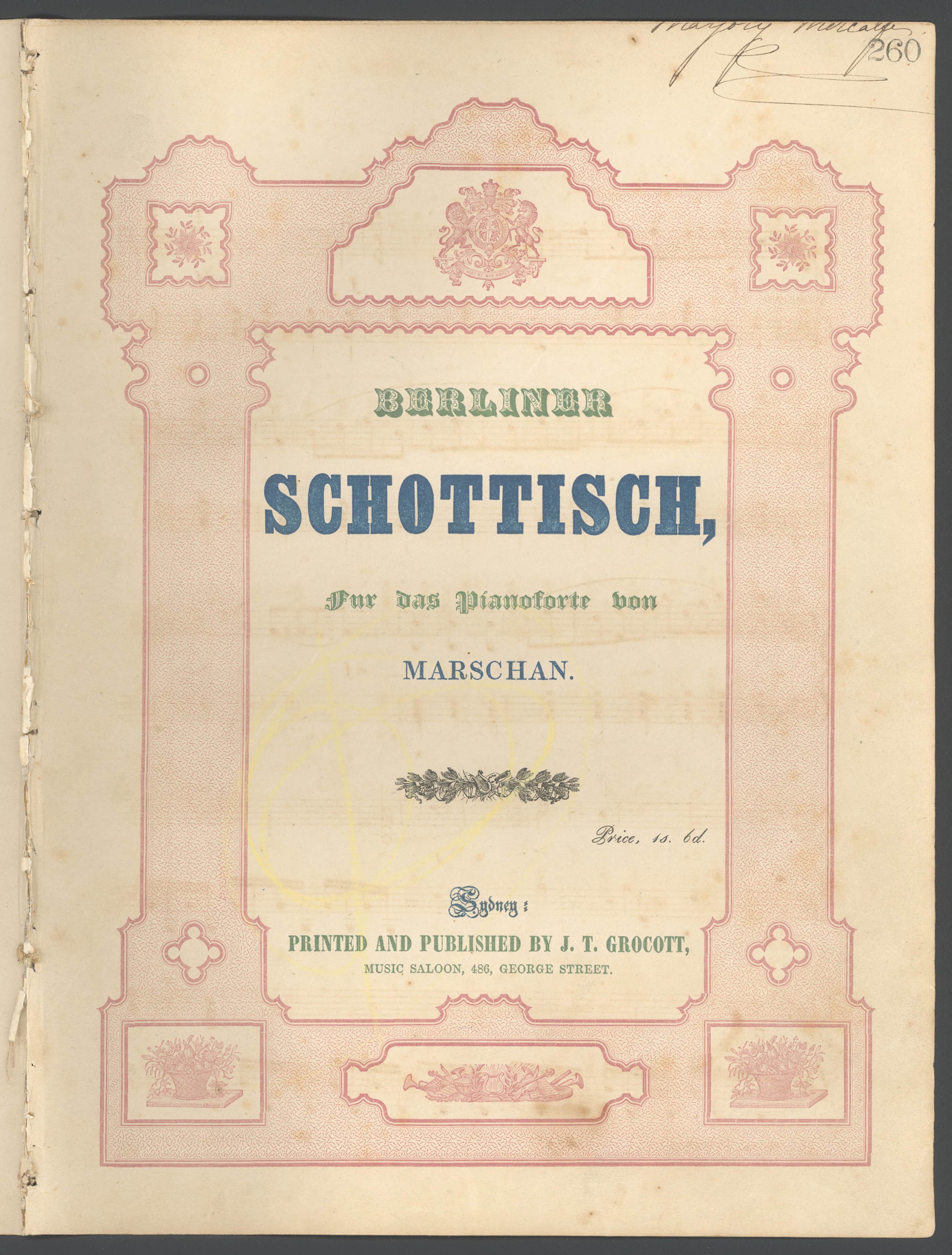
Marschan. ([185-?]). Berliner schottisch fur das pianoforte Sydney : printed and published by J.T. Grocott, Music Saloon, 486 George Street [185-?] Retrieved from http://nla.gov.au/nla.obj-169292632

Jullien, Louis Antoine. (1847). The Nightingale polka. Sydney : J.T. Grocott, [between 1847 and 1851]Retrieved from http://nla.gov.au/nla.obj-687288446
TROVE - James Turner Grocott and Colonial Arts and Artists:
In the Insolvent Estate of James Turner Grocott, of Elizabeth-street, Sydney, Clerk.
WHEREAS the Estate of James Turner Grocott was, on the 16th day of March, 1842, placed under Sequestration in my hands, by order or His Honor Mr. Justice Stepheta, I hereby appoint a Meeting of the Creditors of the said James Turner Grocott to be holden at the Supreme Court House, Sydney, on the 26th day of March instant, at Ten o'clock in the Forenoon^ for proof of Debts, and election of a Trustee or Trustees, and for direction of distribution of proceeds of Insolvent's Estate, the same not exceeding £100; and unless at the said Meeting it shall be shewn that the goods and effects of the Insolvent exceed £100, the said Commissioner will summarily proceed to rank the Debts which shall be thereto proved, and to direct the proceeds to be distributed by the Trustees accordingly.—Dated this 17th day of March, 1842. WILLIAM H. KERR, Chief Commissioner of Insolvent Estates. - New South Wales Government Gazette (Sydney, NSW : 1832 - 1900), Friday 18 March 1842 (No.22), page 440
COMPLAINTS AGAINST TRUSTEES.
In the case of Grocott v. Platt, a rule nisi had issued on the preceding Wednesday, calling on Mr. R. T. Platt to show cause why the estate of the complainant should not be released from sequestration, and why the moneys in Mr. Platt's hands should not be paid over to the said complainant. The case was called on yesterday, but neither party appeared. LAW INTELLIGENCE. (1843, April 20). The Sydney Morning Herald (NSW : 1842 - 1954), p. 2. Retrieved from http://nla.gov.au/nla.news-article12413494
ESTATE RELEASED FROM SEQUESTRATION.
The Court having been satisfied that the preliminary steps had been gone through, directed the estate of James Turner Grocott to be released from sequestration. LAW INTELLIGENCE. (1843, April 27). The Sydney Morning Herald (NSW : 1842 - 1954), p. 2. Retrieved from http://nla.gov.au/nla.news-article12423789
MARRIED.
At Christ Church, on Thursday last, the 18th instant, by the Rev. W. H. Walsh, James T. Grocott, third son of the late James T. Grocott, Esq., of Dali-street, Manchester, England, to Anne, eldest daughter of Mr. Charles Lucas, of County of Clare, Ireland. Family Notices (1845, December 19). The Sydney Morning Herald (NSW : 1842 - 1954), p. 3. Retrieved from http://nla.gov.au/nla.news-article12884192
On Saturday last, the 27th instant, at Christ Church, by the Rev. R. K. Skonce, Alonso, second son of James T. Grocott, Esq., of Dale Street, Manchester, England, to Frances Ann, youngest daughter of Mr. John Johnstone, County of Fermanah, Ireland. Family Notices (1845, December 30). The Sydney Morning Herald (NSW : 1842 - 1954), p. 4. Retrieved from http://nla.gov.au/nla.news-article12884392
BIRTH. On the 2nd instant, at her residence, Hunter-street, Mrs. James T. Grocott, of a son. Family Notices (1846, November 3). The Sydney Morning Herald (NSW : 1842 - 1954), p. 3. Retrieved from http://nla.gov.au/nla.news-article12897079
Other Children [NSW BDM's]:
GROCOTT LOUISA M2224/1848 V18482224 33A JAMES T ANNE
GROCOTT FRANCIS A856/1848 V1848856 31AJAMES T ANNE
GROCOTT ANNA M831/1850 V1850831 35 JAMES T ANN
GROCOTT MARCUS A3694/1852 V18523694 40 JAMES T ANNE
GROCOTT MARCUS A3684/1854 V18543684 40JAMES T ANNE
EXHIBITION OF PICTURES.
To the Editors of the Sydney Morning Herald.
'GENTLEMEN, I perceive in your journal of yesterday, a letter signed A.B., relative to the above exhibition, and I fully agree with the writer of that letter. A collection of works for exhibition would cultivate a more refined taste, I know from experience that good pictures will meet with purchasers, and at a tolerably remunerative price ; as a testimony of what I assert I shipped per Royal Saxon a month ago, six cases of pictures, 120 in number, for Captains Apperley and Dallas, nearly the whole of which were the production of artists in the colony in fact I have actually sold during the last three years 957 pictures, 830 being executed in the colony.
In allusion to the remark made by A.B., I beg to assure him that I shall be most happy to lend for a period of three months, gratuitously the use of my long room at the rear of the shop, 115 feet long, which is admirably adapted for displaying pictures, having a doomed tonight, I am Convinced I can collect at least fifty, among my friends and patrons of the arts. My proposition is simply this-let there be an exhibition held for a given period (annually), visitors paying 1s. each, but giving a free ticket to contributors, the funds so raised to be devoted to the purchase of a silver medal or cup to the first best prize, the balance to be divided in proportion between the second and third best prizes, of course of colonial production. Trusting this letter will meet with your usual attention and courtesy, being for the credit of the colony,
I am, Gentlemen,
Your obedient servant,
JAMES T. GROCOTT'. ."486,-George-strect, May 6. EXHIBITION OF PICTURES. (1847, May 7). The Sydney Morning Herald (NSW : 1842 - 1954), p. 3. Retrieved from http://nla.gov.au/nla.news-article12895305
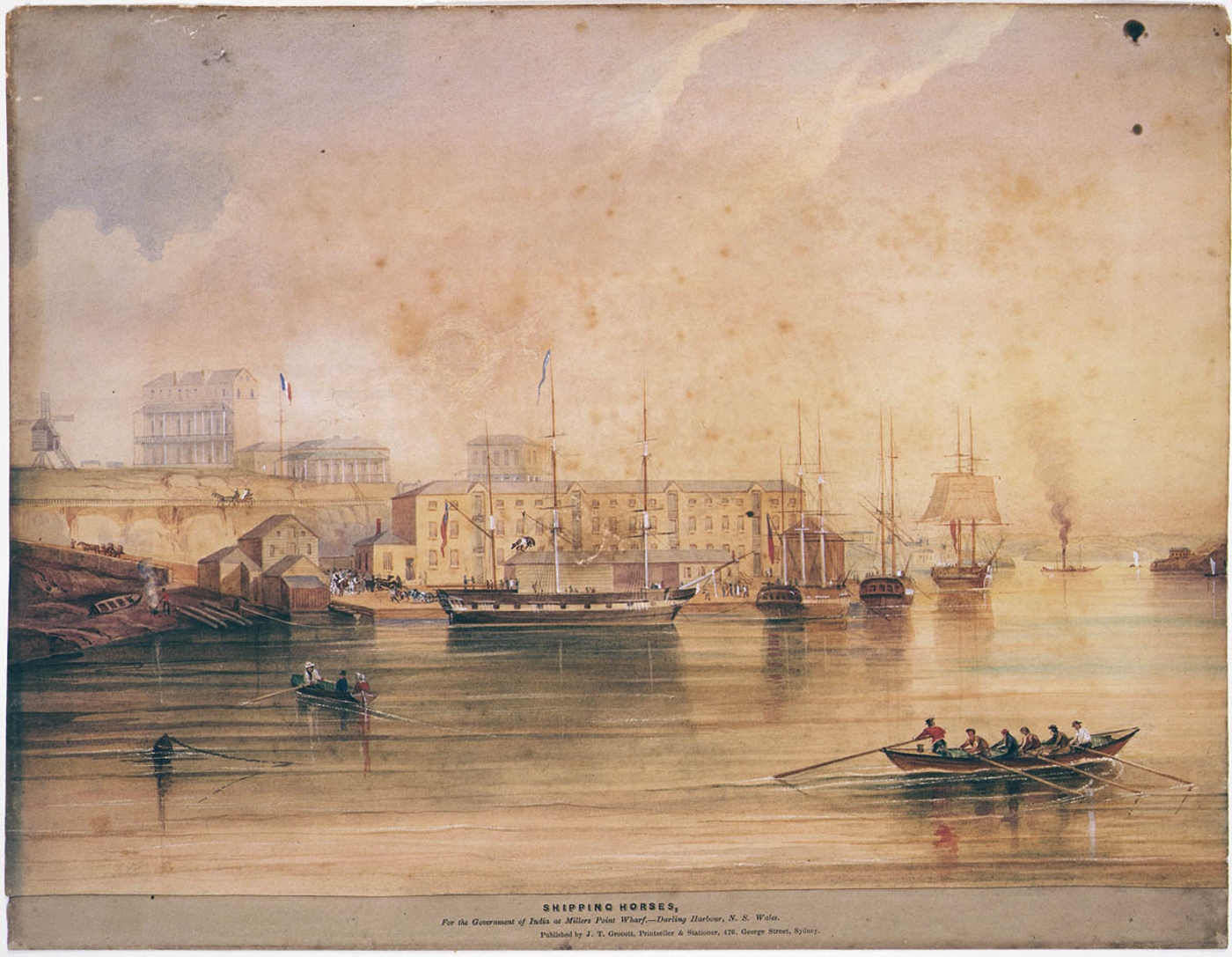
Shipping Horses / For the Government of India at Millers Point Wharf - Darling Harbour N.S. Wales, circa 1847- watercolour by Frederick Garling. During the 1840s an important trade developed exporting Australian horses to India. This watercolour depicts them being loaded into a ship at Moores Wharf at Millers Point. Above the wharf can be seen the Victoria Terraces and the offices of the French Consul M. Farramond. Garling appears to have painted the watercolour for James Grocott, an art dealer, whose printed label has been fixed to its bottom edge -- Curator Notes, Frederick Garling exhibition, State Library of NSW, 2003.Titled on printed label stuck to bottom of drawing; imprint reads "Published by J. T. Grocott, Printseller & Stationer, 476, George Street, Sydney". The view however is a watercolour and not a print. Item a128239h - information and copy courtesy Mitchell Library, State Library of New South Wales.
Mr. Grocott's Art Union. — If any of our readers who admire the Fine Arts, and have not yet seen the splendid exhibition of Paintings, Engravings, and other works of Art, now on view at the Music Saloon, have any curiosity to gratify by an inspection of the valuable collection of prizes, we would recommend them immediately to wait on Mr. Grocott. We were really highly delighted with our visit. In addition to the recommendations which many of the paintings and engravings possess as elaborate performances, we had our recollections of the mother country greatly freshened by several beautiful engravings of the principal cities of England and Scotland, and the arrangement of the pictures is such as is well calculated to
exhibit the whole to advantage. Mr. Grocott, who was here among the first to encourage the exhibition and production of pictures, deserves praise at the hands of our citizens, and we trust that his exertions on the present experiment will prove successful. A painting of the Peak of Teneritle by R. A. Smith, will stand inspection, and deserves credit; and we hope that Mr. Grocott's design of lodging £100, to be awarded as prizes for artistical works, will be the means of producing many colonial artists who are now unknown. Domestic Intelligence. (1849, November 24). The People's Advocate and New South Wales Vindicator (Sydney, NSW : 1848-1856), p. 2. Retrieved from http://nla.gov.au/nla.news-article251537249
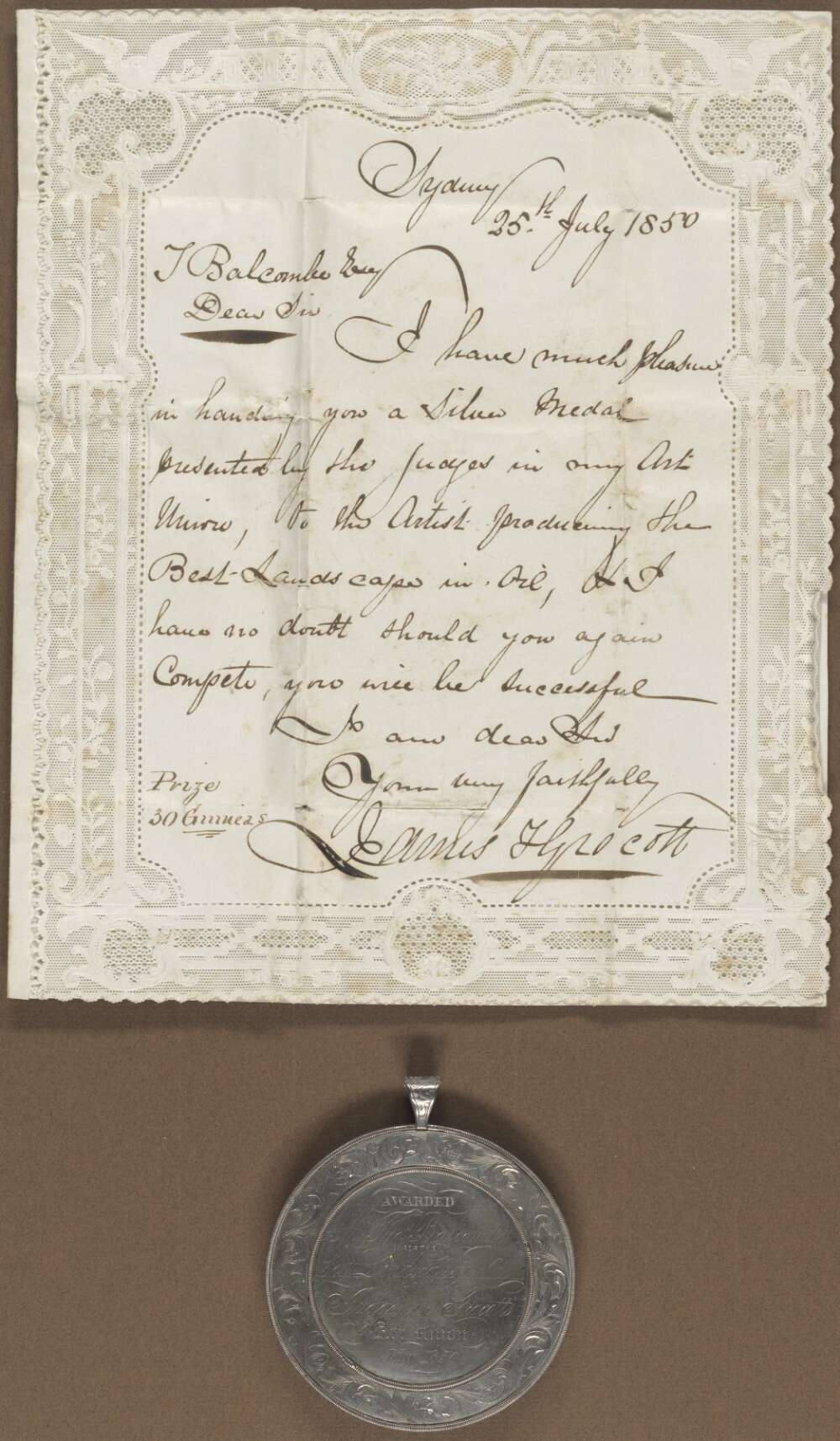
Grocott Art Award, silver medal, 25 July 1850 Retrieved from http://nla.gov.au/nla.obj-2079904991 Part of the collection: Thomas Tyrwhitt Balcombe family collection, 1850-1857. Inscriptions: "Awarded to Mr Thos. Balcombe for the best landscape in oil by the judges in Grocott's Art Union, July 1850"
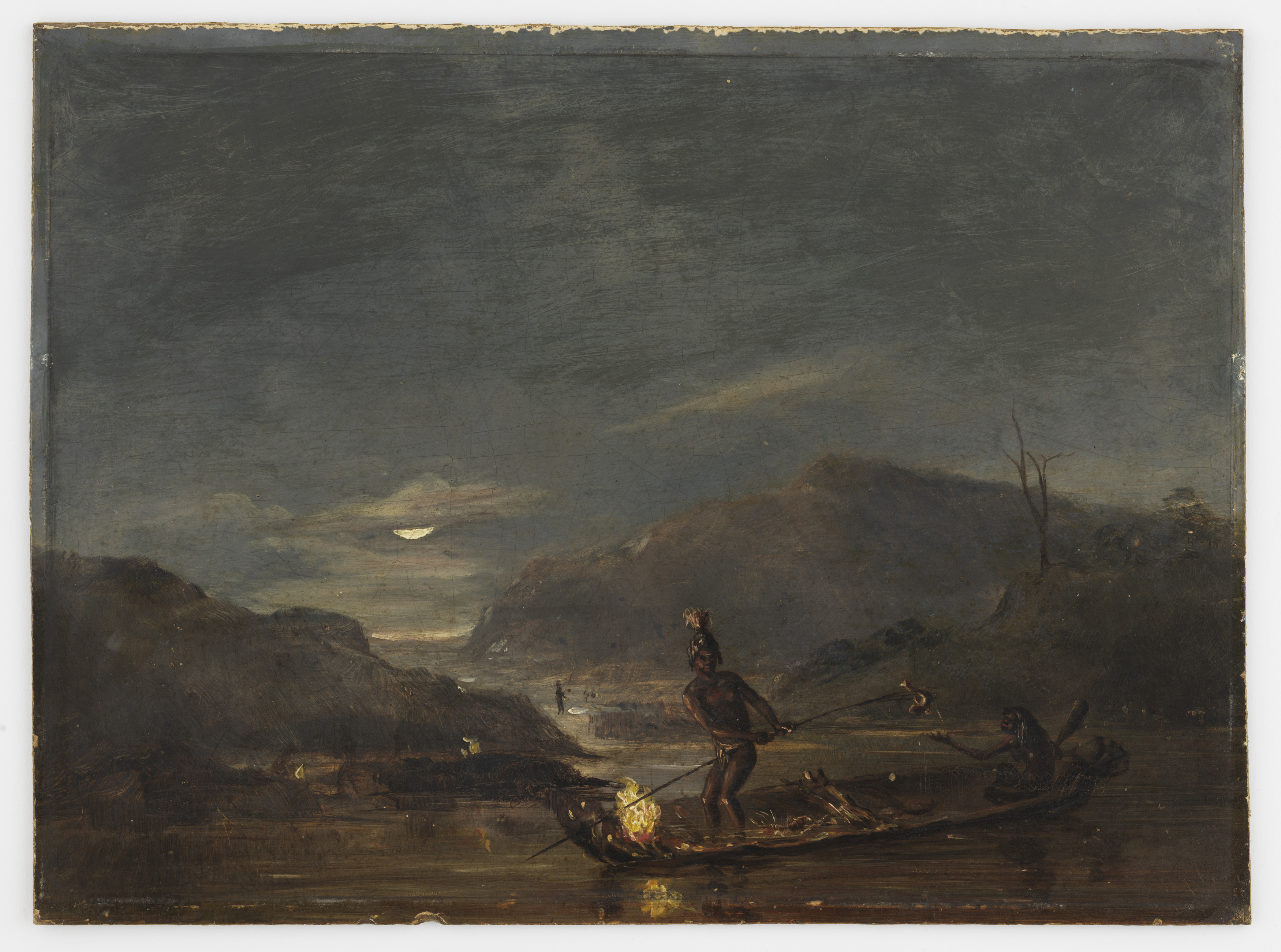
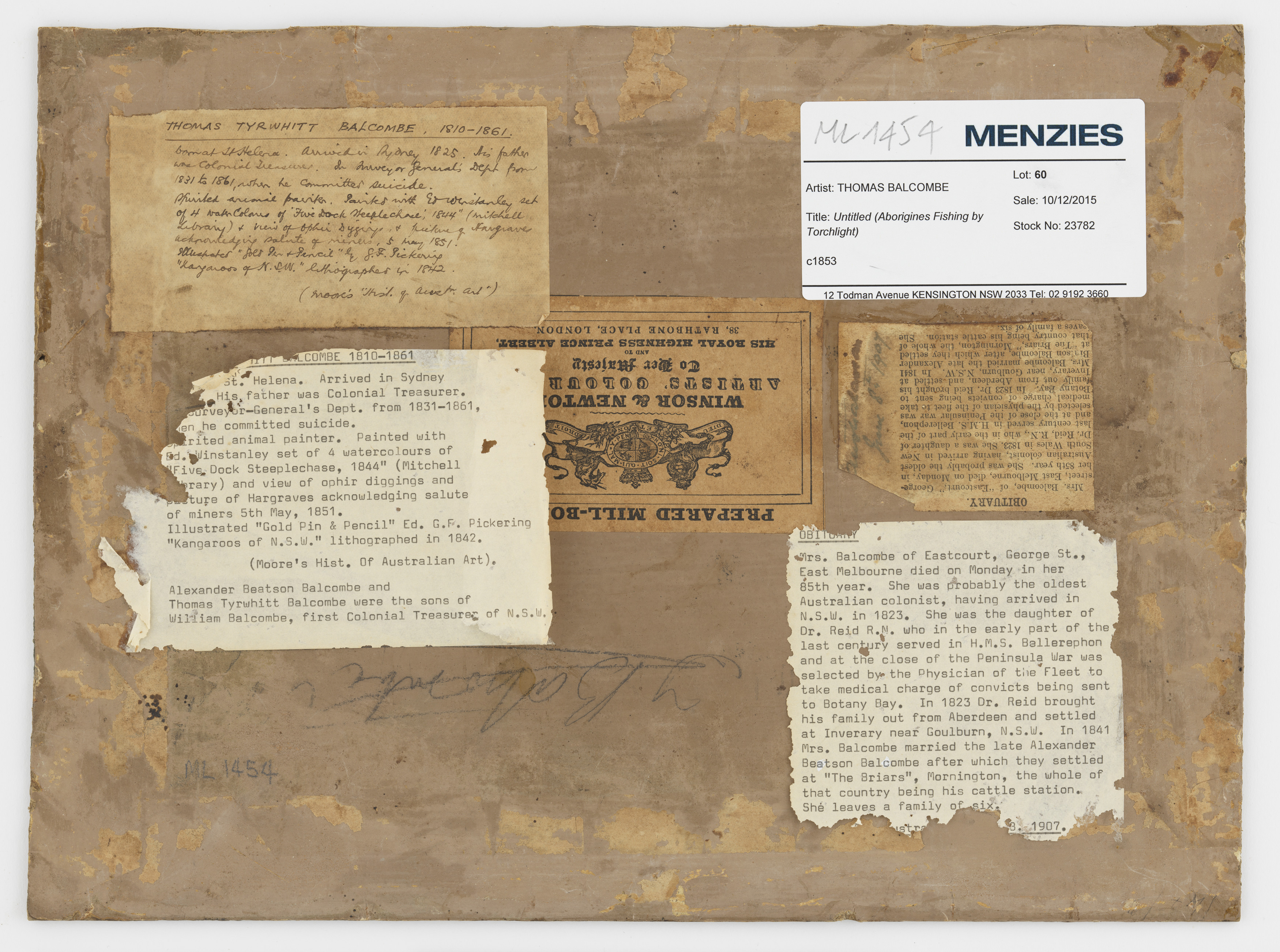
Aborigines fishing by torchlight, ca. 1853 - Signed on verso: T. Balcombe. Pasted on back of frame: Handwritten and typescript clippings of biographical notes on Thomas Balcombe (1810-1861) and obituary of Mrs Balcombe ; framing label of Winsor & Newtown, London ; Menzie's auction sticker, 2015 ; '23782'. Items: c37267_0002_c and c37267_0003_c, courtesy Mitchell Library, State Library of New South Wales
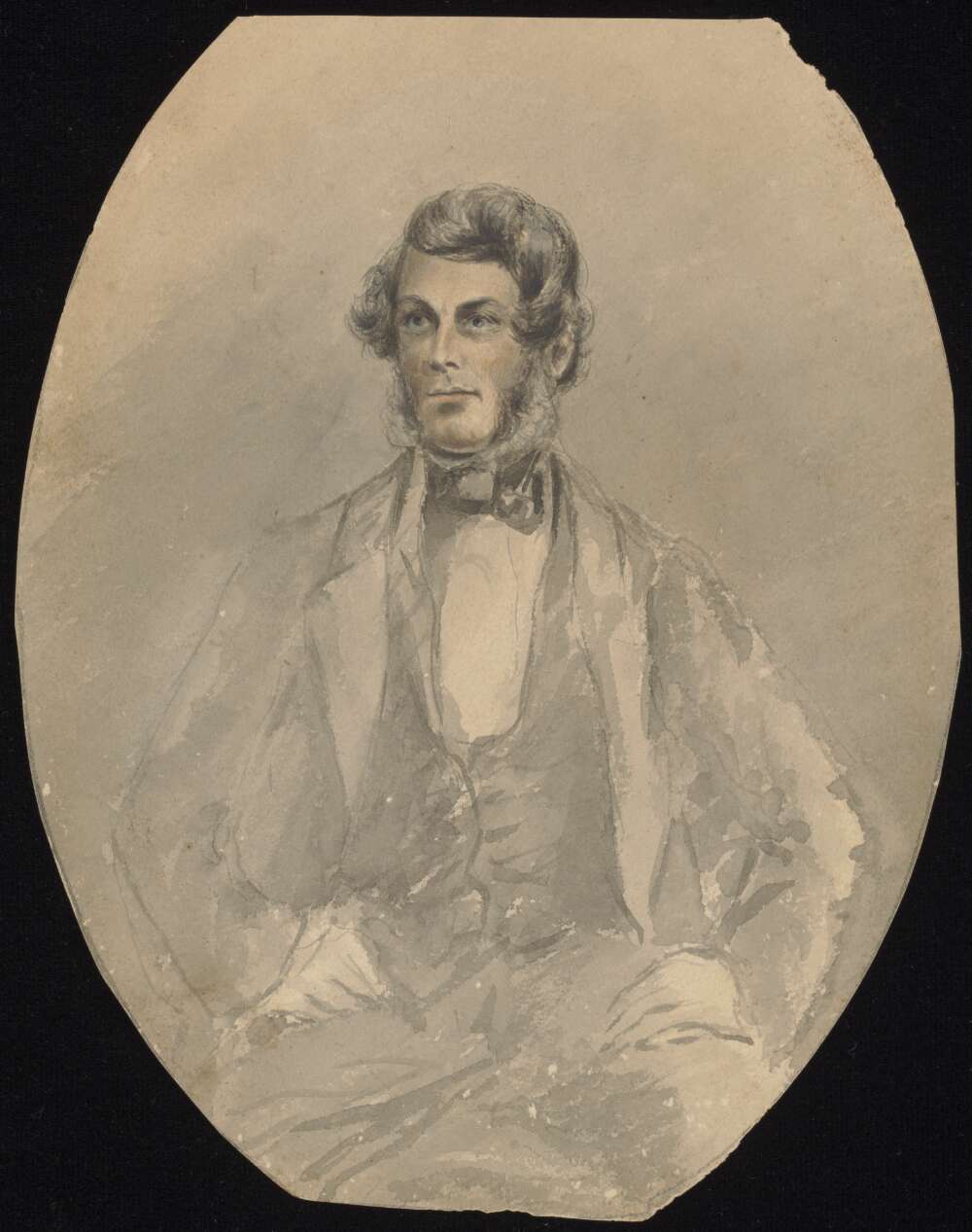
Balcombe, T. (). Self portrait of Thomas Balcombe, 1855 Retrieved from http://nla.gov.au/nla.obj-2079747463
Thomas Tyrwhitt Balcombe family collection, 1850-1857 / Thomas Balcombe. Colonial artist Thomas Balcombe was born and raised in the family home on Saint Helena. Balcombe's family relocated to Sydney in 1824 when his father took up a post as Colonial Treasurer of New South Wales. After completing his schooling, Balcombe began a career at the Australian Agricultural Company, until a head injury from a riding accident forced his resignation. Following his recovery he joined the Surveyor-General's Department as a surveyor, under Thomas Mitchell, and remained with the department for the rest of his life. Balcombe's work as a field surveyor afforded him the opportunity to sketch and paint the variety of people and places he visited. Following his marriage to Lydia Stuckey in 1840, Balcombe began to produce work as a professional artist. Balcombe received numerous accolades, including at the Grocott's third art union in 1850, where he received an award for his figure study 'Aboriginal Native in Pursuit of Game'.--Information from acquisition documentation.
In the Supreme Court of New South Wales.
IN INSOLVENCY.
In the Insolvent Estate of James Turner Grocott, of George-street, Sydney, stationer.
WHEREAS the Estate of James Turner Grocott was, on the 11th day of July, 1848, placed under sequestration by order of His Honor Mr. J ustice Manning, I hereby appoint a first meeting of the Creditors of the said Insolvent to be holden before me, at my Office, Supreme Court House, Sydney, on Tuesday, the eighteenth day of July instant, to commence at 10, a. ra., for the proof of debts against the said Estate ; and a second meeting to be holden before me, at the same place, on Monday, the twenty-fourth day of July instant, for the like purpose, and for the election of a Creditor's assignee if required.—Sydney, 13th July, 1848.
WILLIAM A. PUREFOY,
Chief Commissioner of Insolvent Estates, Official Assignee—George King. 4s. IN INSOLVENCY. (1848, July 14). New South Wales Government Gazette (Sydney, NSW : 1832 - 1900), p. 870. Retrieved from http://nla.gov.au/nla.news-article230148915
In the Insolvent Estate of James Turner Grocott, of George-street, in the City of Sydney, in the Colony of New South Wales, stationer.
NOTICE TO CREDITORS.
TAKE notice, that I, James Turner Grocott, the abovenamed Insolvent, intend on Thursday, the 9th day of November next, to apply to the Chief Commissioner of Insolvent Estates, at Sydney, that a certificate under the Act of the Governor and Council, 7 Victoria, No. 19, be granted to me.— Sydney, 4th October, 1848. JAMES TURNER GROCOTT. NOTICE TO CREDITORS. (1848, October 6). New South Wales Government Gazette (Sydney, NSW : 1832 - 1900), p. 1434. Retrieved from http://nla.gov.au/nla.news-article230150118
At the Music Saloon, 486, George-street, on the 16th instant, the lady of Mr. James T. Grocott, of a daughter. Family Notices (1848, October 18). The Sydney Morning Herald (NSW : 1842 - 1954), p. 4. Retrieved from http://nla.gov.au/nla.news-article12905341
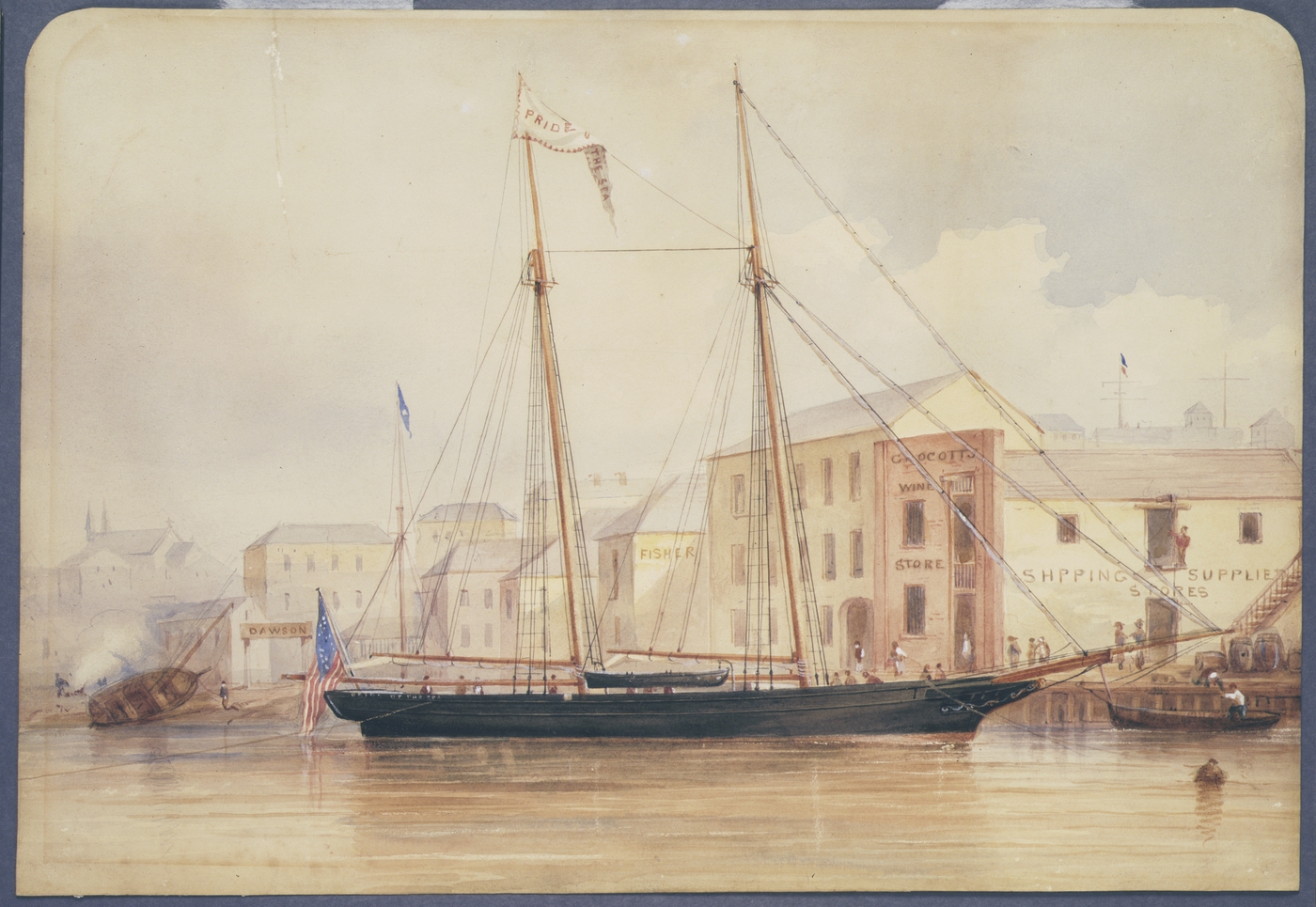
Circular Quay, circa 1854, watercolour by Frederick Garling (1806-1873)- In the foreground is shown the 'Pride of the Sea', an American ship, tied up at the wharf in front of James Grocott's Wholesale, Wine and Spirit warehouse, which is listed in "Waugh & Cox's directory of Sydney and its suburbs" for 1855 as being in New Pitt Street, or Circular Quay. The 'Pride of the Sea' was in the Harbour in 1854.'Pride of the Sea' was built by the designer of the first yacht to win the America's Cup. It's revolutionary bow and sails attracted considerable interest on her Sydney visit. information and copy courtesy Mitchell Library, State Library of New South Wales
ART UNIONS
To the Editor of Bell's Life in Sydney
Gentlemen- In the People'* Advocate of Saturday last a long and very clever letter appeared on the above subject ; but I can only, agree with the first psragraph as all the others evince a display of feeling evidently arising from a disappointed and envious spirit, which is indeed unworthy of the writer. Now, Gentlemen, I have not, certainly positive proof, but I can clearly detect the writer : and I am sure I only echo the voice of the artists generally, with whom I was present at one meeting at Grocott's last evening, when I assert that they know our friend " Colonna'* who, by the bye, mentions Blue Fires and Red Fires; but I would ask him, as an honest man, has he not felt the scorching and withering heat of the Green Fire of jealousy, I shall, not here enter into the detail of his letter, but simply, take one or two objections, and I pledge myself to treat them with fair and open candour, as one artist should another ; for I have a presentiment that "Colonna" can exclaim, " And I, too, am an artist "
First.-As relates to the individual exertions of Mr. Grocott in promoting the Arts, I remember his requesting my attendance at a meeting of gentlemen who intended assembling at his house, for the purpose of creating a gallery of colonial and other works. I did attend that meeting, and the result was that a very large sum was subscribed on the spot, and an exhibition took place In the Bent-street Library. But what was the issue? After a year and a half had elapsed, the money accumulated from the charge made for admission was frittered away in a manner most disgraceful to the parties concerned. A second attempt was made about two years ago, and a miserable one it was. I know for a fact that one of its first and warmest supporters declared that nothing should again indure bim to take part in any proceeding which had for its object an exhibition; nor has he ever distinguished himself since that time. If " Colonna" were a resident of the colony in the year 1843, he must be aware that the second exhibition was a signal failure : so much for a national protection to Art.
Second.-The writer does not know or care who the judges Were? If he had known them, he would lind that one at least of those judges could possibly give him a quiet hint or two as regards his darling " Lot and Daughters.'' Although I agree with '' Colonna" as relates to the conception of the picture, yet there is about it a brick dust and brown timbre appearance, which is so very Unlike -the artist's usual productions, that his best and Warmest friends declared their astonishment at his venturing to submit his picture to public gaze. The production has never been a favourite with the public, and never will. The conception Is the only redeeming point, as the colouring, drawing, effect, and site, are all much against it. " Colonna" will never have airain to complain about the judges, as the artists have hit upon a plan which must give satisfaction to all.
Third, and Lastly-The writer asserts that Mr. Grocott's pecuniary arrangements so materially interfere with the liberality expected to be given to the undertaking, that the toil of the artist's brain, and the work of his hands, are subject to the caprice of one individual ; but I cannot, for the life of me, see how the £ 100 paid to the artists on the day of the judgment being given, and the picture instantly marked at the same price, can possibly be any thing in Mr. Grocott's pocket. It may be possible that the artists in return make up a purse of 30 or 40 guineas as a present to Mr. Grocott ; but if they do so, thank God I have not been let into the secret.
In conclusion, I would sincerely beg of "Colonna" again to review the position Mr. Grocott holds to the artists, and remember that they have already had upwards of £400 from the public, and are evidently to receive more, so long only as they endeavour to please the public by their future, and, I hope, better productions.
I am, Gentlemen. '
Your obedient servant.
AN ARTIST. Original Correspondence. (1850, September 21). Bell's Life in Sydney and Sporting Reviewer (NSW : 1845 - 1860), p. 3. Retrieved from http://nla.gov.au/nla.news-article59771230
ART UNIONS.
To the Editor of the People's Advocate.
Sir- It was not my intention to have intruded upon you on this subject for some weeks, until my plans, yet in embryo, would have been more systematically arranged, and better fitted to meet the eyes of others ; but I am forced from my retirement, to reply to a letter which appeared in last Saturday's publication, signed "An Artist." The writer accuses me of envy, jealousy, and disappointed feelings— a very formidable catalogue ; but, as the celebrated Mr. Slasher says, when he endeavours to explain his cowardice, " The insult was a mistake, it was intended for Grimshaw, and Grimshaw alone ought to resent it." So with my friend, he has so wholly, so utterly mistaken the identity of the individual whom he accuses, that i may pardon him very easily and unconditionally. I assure you, him and all, be they many or few, interested in the matter,-that I am not the person whom he supposes me to be. I am an unknown and humble individual— to him a mystery. I may be " the coming man," or I may, not, but I certainly am as much a stranger to him as the Ikon Basilike, or Mr. Junius himself— I am no artist -I do not even pretend to be of the- hybrid breed of amateurs and so entirely unconnected am I with art that the feeling with which I am charged could never by any possibility (in this case at least) find a home within my breast. He may believe me for I am not "the 'column1 which, like a tall bully, lifts its head and lies." Love of art — affection for artists — the mighty dead of former ages, has always been a prominent feature of my character, not that I am, or pretend to be a connoisseur or a critic; were I to give utterance to my views, many of them would be considered heretical, for never did I look upon a picture with more pleasure than I did on a little, old, discoloured work of poor Morland's, on which, when a child, I gazed again and again, admiringly, and which is endeared to my heart by so many sweet remembrance), by so many precious associations, interwoven on its soiled and torn canvas, that were it now in my possession, I would not exchange it or one of the lost cartoons of Raphael. But yet incompetent as I may be to judge critically or correctly, yet my affection for the ' divine art ' is not extinct, and that is the only apology which I have to offer for my interference in this matter.
Your correspondent scouts the idea of a " .National Art Union, on the ground that two attempts have been made and that they have failed. Shall I tell him the great cause of these failures ? The intrusion of amateurs, — a mixed race, ambitious of being ranked as artists, and yet desirous that it should be known that they are independent of arts. Every man, who is flattered by the opinions of partial or interested friends, looks upon his milk and water sketches, and fancies that his " View of the Hay market by Moonlight," or " Scene near the Toll Gate at Daybreak," are as worthy of renown as the chef-d'seuvres of a Canaletti or a Gainsborough. Such persons should be carefully excluded from a society of artists until they have served a severe and sedulous apprenticeship. These are not the days of " dreamers we all are, and must be, " workers." The age is gone- by when the nobles and princes of the earth flung their mantles in protection over the children of imagination, saying — " Come and dwell with me, beneath the shelter of my roof. You shall find a home, from which shall be banished all the stern struggles and bitter realities of life ; and where, at peace with the world, you can labour only for fame." The days have past and gone when a chivalrous King would fold his arms round a dying artist, and receive his last breath, or when the tears of rank and beauty would be shed over the untimely bier of the poet.
Study the fate of a late English artist he found himself in his old age a man whose genius the world admired and envied ; he looked on his pictures, round which thronged enraptured thousands, and the heart of the artist rejoiced : he felt the empty purse which lay beside him as he toiled, and the spirits of the man grew faint— a thought came into his head : " Were I gone, the helpless, the forlorn, would be cared for ; away with the old trunk, that the saplings may flourish." He destroyed himself. His conjecture was not a wrong one ; startled by the tidings of a fate so terrible, the public hastened to express its sympathy with the forsaken. Royalty itself — royalty richly fed and costly arrayed, loaded with the gaudy trappings with which the folly of our ancestors invested erring mortals like themselves — deigned to stoop to solace with a portion of its superfluous wealth, the widow and the fatherless ; nobles and princes pressed forward with money and with interest. And I half that liberality, half that influence, exercised twelve months before, would have shielded those gray hairs from shame, from sorrow, and from sin. Since then the golden days of imagination are no more — since the artist most not only conceive, but must also realise his ideas, not for fame alone but for bread— it behoves him to enlarge his field as much as possible, and to make the ground as fertile and as productive as good and careful tillage can render it.
As the first step in advance, then, I would like to see formed a Society of Artists, from which every other individual, however great his influence, should be rigidly excluded— all patronage should be eschewed ; for the opinions and counsels of persons, who think that they are conferring a favour by acting as presidents, secretaries, and treasurers, are in many instances most detrimental to the societies which they condescend to honour, and no influence should be exerted therein, except by those interested in the success and w6ll- being of the community. The world is beginning to smile at the pretensions of those whom fortune has placed in high stations ; the pride of rank and that of wealth are slowly but surely yielding to the pride of intellect and the power of mind. As 1 feel that I have already trespassed too much, I will defer this subject until a future occasion, and content myself with addressing a few .words to your correspondent. He seems to think that " Lot and his Daughters" is a pet of mine. I must correct his error once again, for I am fully aware of its defects (many of which, however, are to be attributed to hasty execution), but I certainly found fault with the system which allowed any composition in this walk of art to be placed in competition with others which must be always lower in the scale, even if superior in every thing but conception. I am happy to see that under the new regulations this cannot be the case, and indeed I may congratulate myself that all my hints have been adopted, — I - hope for the interest of ail concerned. I refrain from replying to the last paragraph but one, as I do not consider myself justified in publishing any thing told to me in confidence ; but I cannot help saying that it is not calculated to profit the person in whose favour it is professedly written, if it is liable to the slightest contradiction ; and in conclusion, beg leave to say that I never charged Mr. Grocott with want of inclination, but rather with the want of power of being as liberal to the Artists and to the public as they had both a right to expect, and with the flattering idea in my mind that I have already done some good and that I may yet do more. I remain, Sir. yours obediently,.
Sydney, Sept. 25, 1850.
COLONNA. Original Correspondence. (1850, September 28). The People's Advocate and New South Wales Vindicator (Sydney, NSW : 1848-1856), p. 5. Retrieved from http://nla.gov.au/nla.news-article251538451
NOTICE TO CREDITORS.
In the Supreme Court of Now South Wales.
INSOLVENCY JURISDICTION
In the Insolvent Estate of James Turner Grocott, of Pitt-street North, Sydney, in the Colony of New South Wales, storekeeper.
"NOTICE is hereby given, that application will be made by the abovenamed insolvent to the Chief Commissioner of Insolvent Estates, at the Supreme Court House, Sydney, aforesaid, on Thursday, the sixteenth of August, in the year 1855, at twelve o'clock at noon, or so soon after as the same can be heard, for a certificate of discharge of him the said insolvent, pursuant to the several Acts of the Governor and Legislative Council of New South "Wales aforesaid, in that behalf.— Dated this eleventh day of July, A.D. 1855.
JAMES TURNER GROCOTT. 1300 3s. 6d. NOTICE TO CREDITORS. (1855, July 13). New South Wales Government Gazette (Sydney, NSW : 1832 - 1900), p. 1864. Retrieved from http://nla.gov.au/nla.news-article230679374
James Grocott, is then found at Manly, leasing the Pier Hotel:
EASTER FESTIVITIES AT MANLY BEACH.
Amateur Regatta. MONDAY, the 9th April, For gentlemen amateurs only, pulling a pair of ojrs in water-men's skiffs (or skiffs c'assed as such) similar to those used at the last Anniversary.
First prize, £10 10s. cash, or a Silver Cup.
Second ditto, £3 3s. cash. -
Entrances One Guinea. To start from a boat moored off the Pier, at 2 o'clock. Several scratch races to follow.
J T GROCOTT
EASTER HOLIDAYS at MANLY.-The usual provision will be made by Mr. GROCOTT on EASTER MONDAY and following days. A capital dinner for 2s. 6d. Extra steamers. Fireworks at 7 p m. Advertising (1860, April 3). The Sydney Morning Herald (NSW : 1842 - 1954), p. 1. Retrieved from http://nla.gov.au/nla.news-article13038665
MANLY BEACH REGATTAI!!
GROCOTT'S BILL OF FARE for THIS DAY.
A CAPITAL DINNER.
Roast Goose and apple sauce
Roast fowls
Boiled fowls
Roast ducks
Fillets of veal
Veal and ham pies
Chicken and barn pies
Roast Beef, Round of ditto
Saddle of mutton
Mutton cutlets
tongues
Pastry in variety
Salad and cheese.
In order to avoid crowding, the first bell will be rung at 1 o'clock for 120 persons ; the Second bell, for 120, at 2 o'clock.
Two Shillings and Sixpence per head.
J. T. GROCOTT, Pier Hotel.
MANLY BEACH FESTIVITIES ! ! !-All sorts of Manly SPORTS during the Holidays, say Quoits, Cricket, German Tactics, Horse Racing, Donkeys, Russian Skittles, The Maze, Billiards, and, though last, not least, The Amateur BOAT RACE, for a silver cup, or £10 10s. cash ; second prize, £3 3s._
EASTER FESTIVITIES AT MANLY BEACH.
Amateur Regatta. MONDAY, the 9th April, For gentlemen amateurs only, pulling a pair of oars in water-men's Bkifls (or skiffs c'assed its euch) similar to those used at the last Anniversary. Three entrances or no race.
First prize, £10 10s, cash, ora Silver Cup.
Second ditto, £3 3s. cash.
Entrances OneGuinea. To start from a boat moored off the Pier, at 2 o'clock. Several scratch races to follow.
J. T. GROCOTT.
EASTER HOLIDAYS at MANLY.-The usual provision will be made by Mr. GROCOTT, EASTER MONDAY and following days. A capital dinner for 2s. 6d. Extra steamers. Fireworks at 7 pm. Advertising (1860, April 9). The Sydney Morning Herald (NSW : 1842 - 1954), p. 1. Retrieved from http://nla.gov.au/nla.news-article13038929
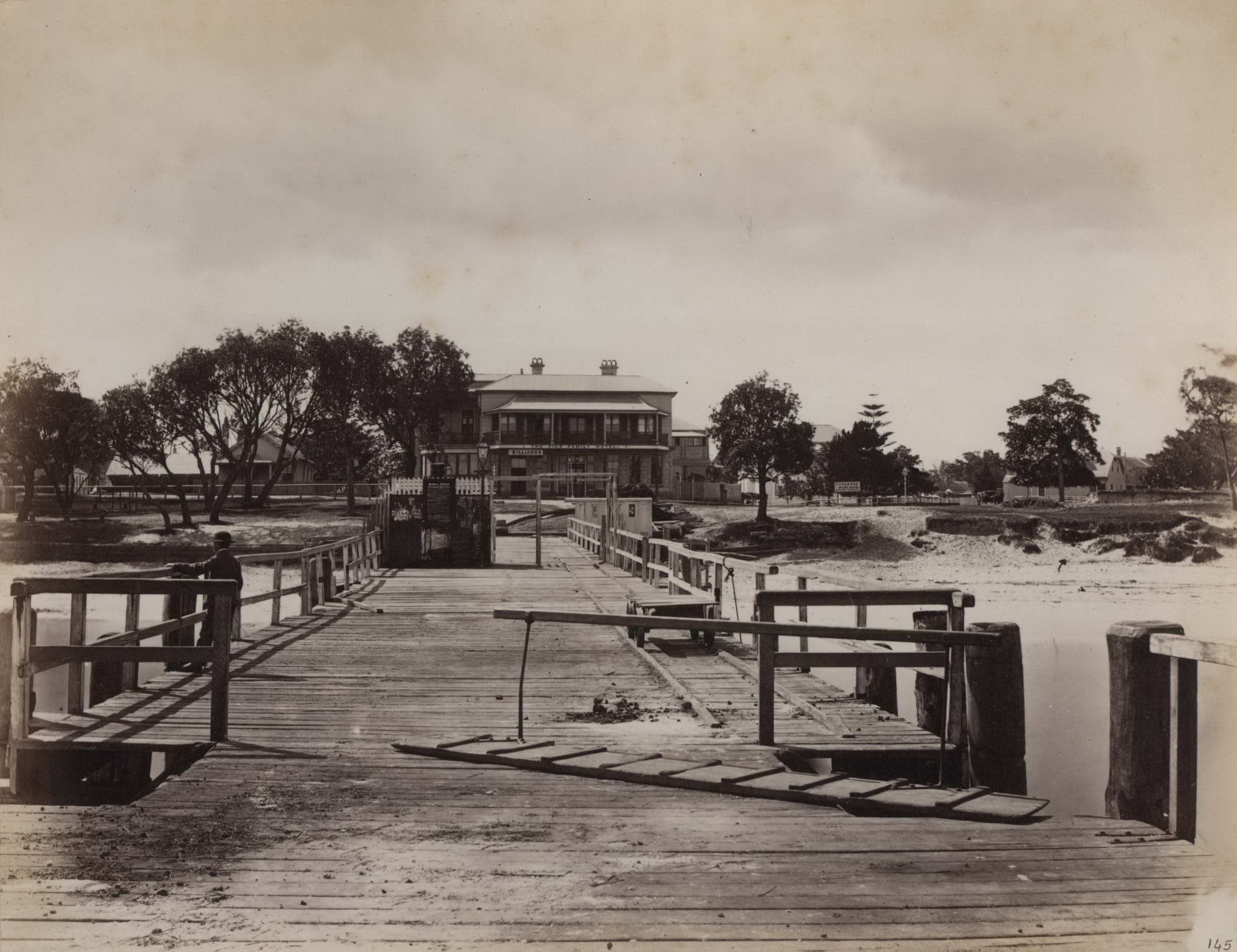
Manly Beach, c1860-70s. Albumen paper photograph, numbered “145” in negative lower right, titled on backing below image. Image shows the old wharf, in the location of the present Manly Wharf. Visible on the wharf are a Manly Beach Steamer timetable and rail tracks for goods. Signs in the background read “The Pier Family Hotel” and “Ivanhoe Park Hotel and picnic grounds.” From Josef Lebovic Gallery
In the Supreme Court of New South Wales.,
IN INSOLVENCY.
In the matter of the Petition of Philip Cohen, of "Wynyard Square, in the City of Sydney, merchant, praying that the Estate of James Turner Grocott, of Manly Beach, in the City of Sydney, hotel keeper, may be sequestrated for the benefit of his Creditors, according to law.
WHEREAS on the Petition of Philip Cohen, the Estate of James Turner Grocott, the above -named Insolvent, was, on the 28th day of September, one thousand eight hundred and sixty, by order of the Honorable Samuel Frederick Milford, one of the Judges of the Supreme Court of the Colony of New South Wales, placed under sequestration until the same should, by the said Supreme Court, be adjudged to be sequestrated, or the said Petition discharged according to law: And His Honor did appoint Friday, the 12th day of October next, for the said James Turner Grocott to appear before the said Supreme Court, to shew cause why his Estate should not, by sentence of the said. Court, be adjudged to be sequestrated for the benefit of his Creditors : And His Honor did at the same time appoint Frederick William Perry, Esquire, of Sydney, one of the Official Assignees of Insolvent Estates within the said Colony, to be Official Assignee of this Estate.— Dated at Sydney, this 1st day of October, a.d. 1860.
WILLIAM ALEXANDER PUREFOY, Chief Commissioner of Insolvent Estates. IN INSOLVENCY. (1860, October 2). New South Wales Government Gazette (Sydney, NSW : 1832 - 1900), p. 1871. Retrieved from http://nla.gov.au/nla.news-article229948412
In the Insolvent Estate of James Turner Grocott, of Manly Beach, near the City of Sydney, hotel keeper.
WHEREAS the Estate of James Turner Grocott, was, on the 28th day of September, 1860, placed under sequestration by order of the Honorable Samuel Frederick Milford, one of the Judges of the Supreme Court, I hereby appoint a First Meeting of the Creditors of the said Insolvent, to be holden before me, at my Office, Supreme Court House, King-street, Sydney, on Monday, the 12th day of November next, to commence at 3 p.m., for the proof of debts against the said Estate; and a Second Meeting to be holden before me, at the same place, on Thursday, the 15th day of November, to commence at 11 a.m., for the further proof of debts, and for the election of a Creditors' Assignee, if required.—Dated at Sydney, the 12th day of October, a.d. 1860. WILLIAM ALEXANDER PUREFOY, Chief Commissioner of Insolvent Estates. Official Assignee—Frederick William Perky. WHEREAS the Estate of James Turner Grocott, was, on the 28th day of September, 1860, (1860, October 16). New South Wales Government Gazette (Sydney, NSW : 1832 - 1900), p. 1983. Retrieved from http://nla.gov.au/nla.news-article229949025

Advertising (1861, January 24). The Sydney Morning Herald (NSW : 1842 - 1954), p. 1. Retrieved from http://nla.gov.au/nla.news-article13051796
In the Supreme Court of New South Wales.
IN INSOLVENCY.
In the Insolvent Estate of James Lurner Grocott, late of Manly Beach, innkeeper.
TAKE NOTICE, that I intend to apply to His Honor the Chief Commissioner of Insolvent Estates, at the Court House, King-street, Sydney, oil Tuesday, the 12th day of March next, at noon, that a Certificate of Discharge be granted me, in pursuance of an Act of the Governor and Legislative Council of New South Wales, 7th Victoria, No. 19.—Dated this 7th day of February, 1861, JAMES TURNER GROCOTT. 546 4s. 6d. IN INSOLVENCY. (1861, February 12). New South Wales Government Gazette (Sydney, NSW : 1832 - 1900), p. 417. Retrieved from http://nla.gov.au/nla.news-article230060279
WILL be published, on the 1st January next, THE SYDNEY DIRECTORY for 1863.
The publisher desires to state that no expense will be spared to render this Directory as perfect as possible, and to that end he has secured the services of Mr. J. T. Grocott whose extensive local knowledge thoroughly qualifies him for the compilation of the work.
Heads of Government Departments, Public Companies and Mercantile Establishments are respectfully requested to render all necessary information to the compiler to ensure the work being what the publisher desires to make it an accurate Directory of Sydney for 1863.
JOHN SANDS, 392, George-street. Advertising (1862, August 27). The Sydney Morning Herald (NSW : 1842 - 1954), p. 8. Retrieved from http://nla.gov.au/nla.news-article13233391
MARRIAGE. On the 15th October, at St. Peter's Church, Woolloomooloo, by the Rev. G. H. Moreton, Mr. Henry George Benson, youngest son of John Benson, Esq., of Castlereagh-street North, to Louisa Matilda, eldest daughter of Mr. James Turner Grocott, of Market-street, Sydney. Family Notices (1868, October 20). Empire (Sydney, NSW : 1850 - 1875), p. 1. Retrieved from http://nla.gov.au/nla.news-article60828381
DEATHS.
On the 6th instant, at his residence, Market-street, Sydney Mr. JAMES TURNER GROCOTT, aged 48.
FUNERAL.—The Friends of the late Mr. JAMES T. GROCOTT are respectfully invited to attend his funeral ; to move from his late residence, Market-street, near Castlereagh-street, THIS (Thursday) MORNING, at a quarter-past 8 o'clock. THOMAS HILL, Undertaker, Burdekin-square, William-street. Family Notices (1869, April 8). The Sydney Morning Herald (NSW : 1842 - 1954), p. 8. Retrieved from http://nla.gov.au/nla.news-article13187169
His wife, Anne, passed away in 1888 at Uralla;
GROCOTT.—August 12, at the residence of her friends, at Uralla, New England district, Annie Grocott, aged 62 years, relict of the late James Grocott, late of Sydney. Family Notices (1888, August 23). The Sydney Morning Herald (NSW : 1842 - 1954), p. 1. Retrieved from http://nla.gov.au/nla.news-article13694228
Another or the same Sydney Sketching Club decades on:
SYDNEY SKETCHING CLUB.
The annual exhibition of the Sydney Sketching Club will be opened at the gallery at Union-chambers today, when visitors will find nearly two hundred pictures on view. The majority of these pictures are so much in the crude that criticism is out of the question, and it is difficult to understand what end is attained by drawing public attention to them. Under the conditions described, the paintings that pass muster seem to obtain a fictitious value by comparison Placed in-with a first rate local show it can hardly be supposed that they would take any specially high place in it. The best work in the a Sketch Club is contributed by the president, Mr. Arthur W Chapple whose "Hour of Mystery," with the moon rising behind a dark clump of trees, reveals genuine feeling for the period of indefinite twilight.
Mr Chapple's "Ships that Pass in the Night" will also be admired Mr Leslie H Beer's "Daley's Brick Pit, the style of which is slightly reminiscent of Streeton's "Fires On!" is clever in its treatment of hard light, and he again shows promise in the evening effects that give charm to the sordid foreshores of Kerosene Bay. In the still-life section Miss E Lockley is well represented with Fan, Vase, and Shells" A portrait of a well known city incumbent, whilst easily recognisable, in from an art stand-point grotesque, but Miss Alice Foy's portrait of Mr. Foy is promising.
The main idea, of the Sydney Sketching Club is to provide a meeting ground for young students, where subjects are chosen by ballot and afterwards form the occasion of friendly competition This is a good idea in itself, but it cannot be said that it has elicited an conspicuous talent. SYDNEY SKETCHING CLUB. (1905, May 10). The Sydney Morning Herald (NSW : 1842 - 1954), p. 13. Retrieved from http://nla.gov.au/nla.news-article14702710